Batalha Monastery: The Complete Guide
Everything You Need to Know About Visiting this Gothic Masterpiece
:max_bytes(150000):strip_icc():format(webp)/Dave-yachtheadshot-668px-5b7324c6c9e77c0025c497d1.jpg)
lifeispixels/Moment/GettyImages

Batalha Monastery
The Batalha Monastery ("the monastery of the battle") in central Portugal is one of those rare gems that, despite being a UNESCO World Heritage Site, doesn't attract huge numbers of visitors.
The ornate, Late Gothic building showcases the skill of medieval Portuguese architects and stonemasons, with many unique features that hadn't been seen in the country before. Rewarding unhurried exploration, it's the kind of place you can decide to call into for a quick visit and find yourself still inside several hours later.
If you're planning a trip to Batalha Monastery , we've covered everything you need to know, from the history and architecture to practical details like costs and how to make the most of your visit.
As its name might suggest, the monastery exists solely because of a military victory. In 1385, despite being outnumbered and poorly equipped, the troops of King João I won the Battle of Aljubarrota against the Castilians nearby. The most famous battle in Portuguese history, it ensured the country its independence and started a new royal dynasty.
Before the battle, João prayed for help from the Virgin Mary, promising that if he won, he would build a great monument to the saint. True to his word, construction started soon after, with the monastery taking well over 150 years—and huge financial and human resources—to complete.
Originally and officially called the Mosteiro de Santa Maria da Vitória (Monastery of Saint Mary of the Victory), the building was somewhat damaged by the Lisbon earthquake in 1755, then ransacked and set alight by conquering Napoleonic troops a little over fifty years later.
After the dissolution of the monasteries in Portugal in 1834, the building was abandoned. A few years later, however, King Ferdinand II started a restoration program to save Batalha Monastery from falling into ruins. Completed by the early twentieth century, the rebuilt monastery was declared a national monument in 1907, and a UNESCO World Heritage site in 1983 .
Architecture and Features
The monastery is predominantly a Late Gothic masterpiece, although hints of other architectural styles can be seen throughout. Ornate archways and detailed stonework abound, with sculptures of saints and other religious figures featuring heavily around the exterior. A mounted statue of Nuno Álvares Pereira, the military genius responsible for winning the Battle of Aljubarrota (and many others) sits in the gardens outside the entrance.
Inside, the most obvious feature of the main cloister is just how narrow it seems. While the original architect intended a more traditional design, his successor raised the height of the nave to over 100 feet, while leaving the width at the existing 72 feet. This led to an unusual, towering perspective, only accentuated by the relatively austere walls and columns that draw the eye upward to the ceiling.
That architect, Huguet, was also responsible for adding two additional chapel areas to the complex, including what is now the monastery's most famous feature, the Imperfect Chapels.
Around the corner from the main building, these small chapels were built to house the tombs of the first seven Portuguese kings but, when the workers on the project were called away to build the famous Jerónimos Monastery in Belem instead, the roof and ceiling were never completed. They remain open to the sky to this day, giving insight into medieval construction methods.
Several prominent figures from Portuguese history are buried at Batalha Monastery, including King João I and his wife Philippa, along with their famous son, Henry the Navigator.
There is also a museum to the fallen dead from military campaigns throughout the ages, including two unknown Portuguese soldiers from World War I. The room's unsupported 200-square-foot vault was considered such a daring architectural ambition at the time that condemned prisoners were used to construct it! That may not have been bad idea—it took two failed attempts to get it right.
How to Visit
Batalha Monastery sits on the edge of the small town of the same name in central Portugal. A few hotels give the option of staying in the town if you wish, but most visitors come for a few hours from popular nearby spots like Nazare, Alcobaça or Fatima instead.
If you have your own transport, it's also possible to take a day trip from Lisbon or Porto—driving from either city should take two hours or less. Parking is easily available onsite and in surrounding streets.
An infrequent bus service from Lisbon also runs throughout the day, taking two hours to get to Batalha, but check the return times carefully if you plan to get back to the capital on the same day. Buses also run from Nazare, taking about an hour.
Most visitors spend an hour or two at the site, but if Gothic architecture is of particular interest, plan for a half-day visit. While there are no restaurants or cafes on site, several eating and drinking options are available in town within a short work.
Free public toilets are available, even if you haven't paid to enter the monastery. The building is fully accessible for those with reduced mobility and wheelchairs are available, if required.
Tickets and Opening Hours
As with many historic Portuguese buildings outside the capital, tickets to Batalha Monastery are surprisingly inexpensive .
An adult ticket costs 6 euros. Entry is free for children 12 and under, those with reduced mobility and on the first Sunday of every month. Half price entry is available to seniors aged 65 and over, people with disabilities, and those with student or youth cards. Family tickets are also available, offering the same discount.
A combination ticket is available that also covers the UNESCO-listed Monastery of Alcobaça and Convent of Christ in Tomar , costing 15 euros. You can pay by cash or card.
Opening hours over summer (April 1 to October 15) are from 9:00 a.m. to 6:30 p.m., seven days a week, and from 9:00 a.m. to 5:30 p.m. the rest of the year. Last entry is half an hour beforehand. The monastery is closed on January 1, Easter Sunday, May 1, Christmas Eve and Christmas Day.
Chateau de Vincennes: The Complete Guide
The Castles of William the Conqueror
Lisbon's Belém Tower: The Complete Guide
The 18 Best Things to Do in Cairo, Egypt
The Top Things to Do in Sintra, Portugal
20 Best Things to Do in Brussels
Salzburg Cathedral: The Complete Guide
Edinburgh Castle: The Complete Guide
The Top 18 Things to Do in Tiruchirappalli, India
Les Invalides in Paris: The Complete Guide
31 Top Things to Do in Jaipur, Rajasthan
Top 15 Monuments and Historic Sites in Paris
The Top 15 UNESCO World Heritage Sites in France
14 Famous Forts and Palaces in India that You Must See
15 Top Things to Do in Lisbon, Portugal
3 Magnificent Portuguese Mansions in Goa that You Can Visit
- Skip to main content
- Skip to secondary menu
- Skip to footer
ZigZagonEarth
Plan unforgettable road trips!
Batalha Monastery (Portugal): Visit Tips + Photos
Last updated on November 13, 2023 by Claire Robinson - this article contains affiliate links. If you purchase through them, I get a small commission ( more )
The Batalha Monastery in Portugal is considered one of the country’s architectural masterpieces. Its Gothic style and Manueline influenced decors are worth a visit and have been listed as a Unesco world Heritage. Below is my guide to help you plan your visit with photos, tips and map.
Before my tips + photos, here are my favorites for Portugal:
My favorite platform to rent a car in Portugal: DiscoverCars
The unmissable boat tour: Benagil sea cave from Portimao
My favorite excursion from Lisbon: Sintra Pena Palace and Cabo da Roca
My favorite places to stay:
- Lisbon: see best rated hotels – e.g. Santiago de Alfama boutique hotel
- Porto: see best rated hotels – e.g. Descobertas Boutique Hotel
- Lagos: see best rated hotels – e.g. Uma Cas A Beira Sol
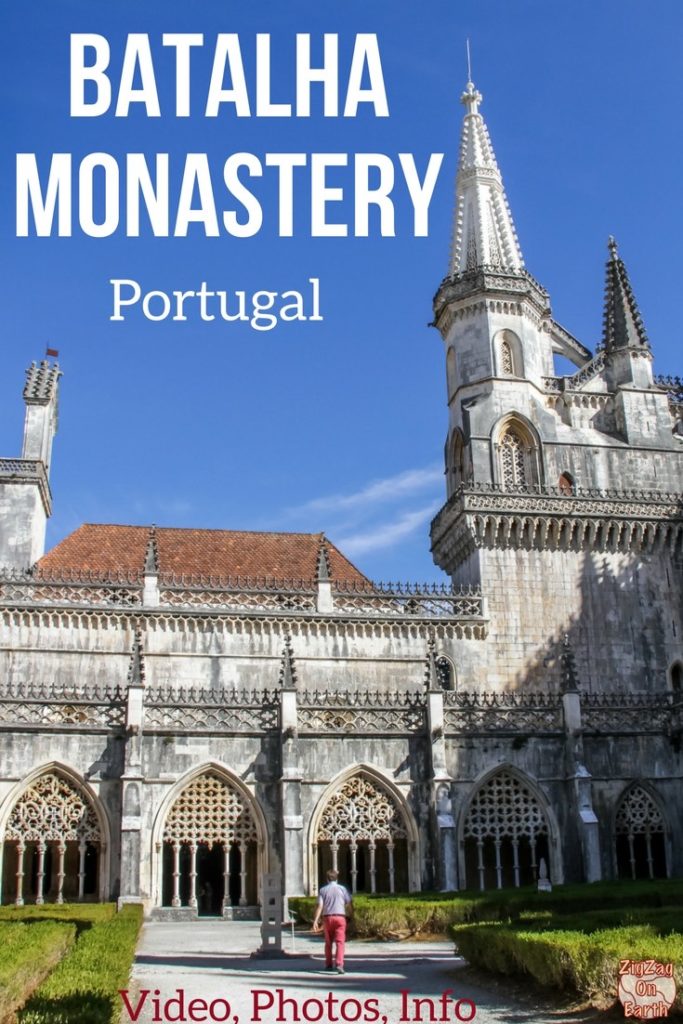
Why visit the Monastery of Batalha?
Is the batalha monastery worth a visit.
Yes, the Batalha monastery is worth a visit. It is one of the most magnificent buildings in Portugal. Its gothic structure has been well preserved and it is complimented by extra builds in Manueline style. During this easy visit, you will marvel at the structure and at the many delicate carvings. No wonder it is a Unesco World Heritage site .

What is Batalha famous for?
The Batalha monastery is famous for:
- the evolution in the architectural style – from Gothic to Manueline art, as Portuguese Monarchy added their section for 2 centuries
- its symbolic value as it was built to celebrate the victory over the Castilians at Aljubarrota in 1385
- the tombs of King John I and his wife Queen Philippa and other royal family members.
Here is a view of the monastery from Hotel Casa do Outeiro (some rooms have a balcony and a view over the Batalha Monastery):

Video – Virtual visit
Below is a short video to give you an idea of what it looks like to visit the Monastery of Batalha Portugal – enjoy a virtual tour!
Can you see why it is included in my list of the top things to do in Portugal ?
About the name
In Portuguese, it is often referred to as Mosteiro de Batalha (Batalha Monastery). However, its full name is Mosteiro de Santa Maria da Vitória (Monastery of Saint Mary of the Victory).
More photos of the different sections of the monastery after the planning tips section.
Planning tips & Map – Batalha Monastery Portugal
Where is the monastery of batalha in portugal map.
- In the town of Batalha,
- North of Lisbon,
- Lisbon to Batalha = 1h40 drive
- Obidos to Batalha = 45 min drive
- Porto to Batalha = 2h drive
- Part of the loop with the Alcobaca Monastery and the Convento de Cristo Tomar
- Below is a map to help you get oriented:
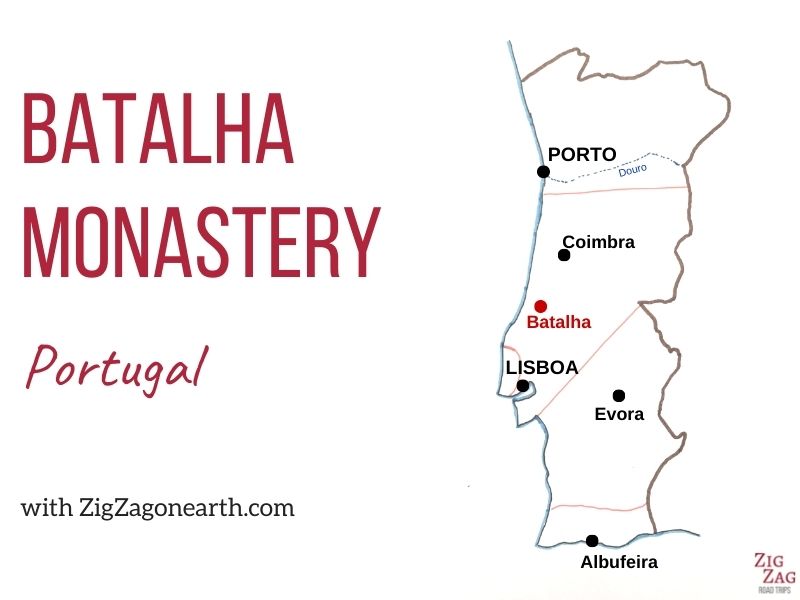
This location is included (with GPS coordinates, map of location and planning info) in my travel guide eBook that helps you easily plan your Portugal road trip :
Plan your dream trip in Scotland thanks to my guide

- 15 maps to easily plan your itinerary
- 170+ pre-selected locations
- GPS coordinates direct to the carparks
- Tips to make the most of your time
- 170+ original photos to help you choose
How to get to Batalha?
- By car – it is very easy to drive to Batalha and reach to monastery
- By organized tours from Lisbon – day trips often include Obidos and Batalha but another stop – see options and availabilities
- By public transportation – with Rede Expressos – 2h
Need to rent a car in Portugal ?
- Compare prices on my favorite platform: Discovercars.com – one of the best rated comparison sites!
- Prefer a compact car for the narrow streets in villages
- Consider their full coverage option – it for peace of mind!
- Book early to have a large choice of vehicles!
See all my tips

Batalha Parking
There is a large carpark behind the monastery. Parking is not an issue in this town.
- Batalha Monastery Opening Hours: 9am to 5:30pm (Oct to Mar) – 9am to 6:30pm (Apr to Sept) – Closed on some public holidays
- It is free to enter the main church but this is not the interesting part…
- Batalha Monastery price – 6€ entrance ticket
- Keep your ticket with you as you need it 3 times: to access the Founder’s Chapel, the cloisters and the unfinished chapels
- Plan 2 hours to tour all the sections, more if you get the audio guide
- Easy walking, not many stairs
Batalha Restaurants
There are several restaurants in town and in the region. Some have views of the monastery. One of the most referenced is Restaurante Burro Velho.
Where to stay in Batalha – hotels and accommodations
The town of Batalha is a great place to spend the nights as you explore the many stunning monuments in the area. Here are some accommodation suggestions:
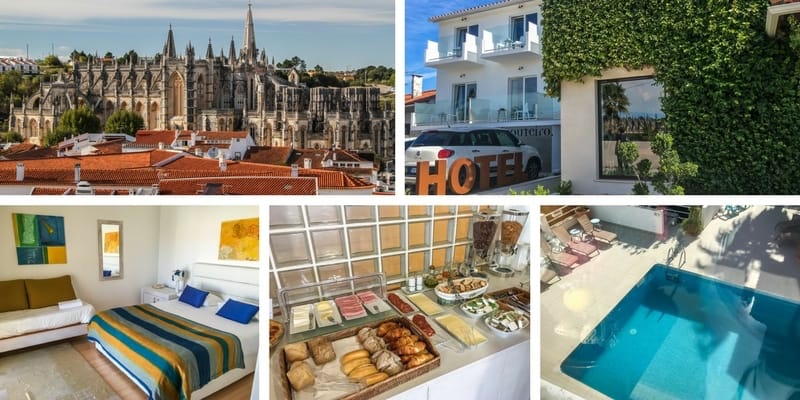
- Where I stayed – I chose Hotel Casa Do Outeiro for its location close to the Monastery and its excellent reviews. I enjoyed the modern and light design – they have rooms with balconies and views of the monastery – see photos and availability
- LOCATION, location, location – Hotel Mestre Afonso Domingues is facing the monastery with great views from the restaurant area – See photos and availability .
- LUXURY – Hotel Villa Batalha, a bit further away from the monastery, but with spa and golf, for those who love a little extra… See photos and availability
- FAMILY – All hotels above have family rooms (2 adults, 2 children) – but if you want your own space, Refugio da Ti Maria is a house with character you can rent not far from the center of Batalha – See photos and availability
- For other options, check out the best rated accommodations in Batalha
Largo de Mosteiro and façade
From the outside, you approach the Monastery from a large walking square. Signs can be found outside with some explanations about the Monastery and its history.
Largo do Mosteiro
There is a large square near the monastery: Largo do Mosteiro. And in the middle is the statue of Nuno Alvares Pereira, the military commander credited for winning the Aljubarrota battle.

Main Portal
The entrance is via the church. The front door is impressive with a lot of sculptures and carvings including angels and the 12 apostles. Above the apostles are statues of angels. And at the pinnacles is a statue of Christ.

Every single piece of sculpture is detailed and symbolic. I could have spent a full hour just on the façade, but I had to move on… lol

Map and Facts of Batalha Monastery in Portugal
A brief history.
Before I lead you inside the famous building, here are a few facts about the monastery:
- The monastery of Batalha (Mosteiro da Batalha) is also called Monastery of Santa Maria da Vitoria
- Its name means Monastery of the Battle because it was built to represent the victory of the Portuguese troops at the Battle of Aljubarrota in 1385
- Built in the 14th century and modified through to the 16th century
- Its original Gothic styled evolve to incorporate the Manueline art (as you will see in the magnificent Royal Cloister)
- Added to the Unesco World heritage list in 1983 , it is one of the most visited monuments in Portugal
Below is the map of the things to do in the Batalha monastery, the different sections to visit: You enter via the nave of the church, you can visit the 2 square cloisters and the round unfinished chapels.

The Gothic church
You first enter via the church. It was built in the 14th century under Architect Huguet.
Entrance to this section is free. You can purchase your tickets inside to explore further.

The church is quite narrow, which makes it look even taller (32.4 meter in height vs 22m in width). And its height is impressive for a building from the 14th century. It is not heavily decorated. It remains simple with beautiful carvings and elegant stained-glass windows.

The founder’s Chapel (Capela de Fundador)
At the end of the nave you can visit the Founder’s chapel. It was built in the 15th century as a pantheon of King Joao I and the Avis Dynasty. Originally, it had a pyramidal roof. But It collapsed during the Earthquake of 1755.
In the center is the Tomb of King Joao I and his wife, Philippa de Lancaster, who reigned during the 14th and 15th centuries. Their tombs are covered with 2 statues of them in full state dress.

The chapel also has the tombs of their four sons. The most famous is Henry, known as Henry the Navigator, born in 1394. He financed many expeditions to discover new kingdoms.

Don’t forget to look up to discover the octagonal roof.

I don’t drink coffee
But I also like other drinks and sweets! Do you like the free content you find on my blog? All my tips and practical information, without intrusive advertising…

Royal Cloister of King Joao I
I found the Royal Cloister the best part of the visit. I spent quite some time admiring the corridors and the play of light through the carvings.
It was built between 1386 and 1515, and as you can see, it was finished in the Manueline style. It is a little similar to the Cloister a the Jeronimos Monastery in Lisbon. The intricate carved decor in the arches is stunning! Pay attention and see the flowers, pearls, shells and more…

Chapter House – Tomb of unknown soldier
Around the cloister you can visit the chapter house (Sala do Capitulo). This is where the monks would have meetings. Inside are the Tombs of an unknown soldier protected by military personnel. I decided not to photograph. The stained-glass window inside dates back to 1508.

Many architects have participated over the years. New technics were implemented. The Basin (Lavabo in Portuguese) was an element of the hydraulic systems. It was located near the entrance to the refectory for people to wash their hands.

Other rooms
Around the cloister, your can also discover the refectory, the dormitory…
Cloister of King Afonso V
Next stop is another square cloister. The contrast is very surprising. This cloister was built during the reign of King Afonso V (15th century). It is visually very simple and representative of the austere gothic style.

It was one of the first double-layer cloisters in Portugal.

The Unfinished Chapels
One of the most famous places at the Batalha Monastery are the unfinished chapels (Capelas Imperfeitas in Portuguese).
They were commissioned by King Duarte in the 15th century for his pantheon. King Koao III (16th century) tried to finish the chapels too.

You have to get outside the Cloister to reenter the building on the other side. Don’t loose your ticket! As you can see on the photo below, to the left the towers are not supporting any roof… hence the ‘unfinished’…

Once again, we discover a lot of very detailed carvings all around.

The Batalha Monastery can be enjoyed as a day trip from Lisbon or a day trip from Porto .
Other things to do in Batalha and in the area
The town of batalha.
There is not much else to see in the town of Batalha.
Fundacao Batalha de Aljubarrota museum
With a 5min drive you can ream the Fundacao Batalha de Aljubarrota museum.
- Closed on Mondays
- 10am to 5:30pm
- A small but interactive museum to learn more about the famous Aljubarrota battle
Alcobaça Monastery and Convent of the Christ – the Batalha Loop
The monastery is part of a loop of historical buildings. I think all 3 are worth a visit but my favorite 2 are Batalha and the Convent of the Christ.
- Batalha to Alcobaça Monastery = 30min drive
- Batalha to Tomar = 30min drive – Check out my article about the Tomar Convent of the Christ

With Fatima and Obidos – the typical day trip from Lisbon
Day trippers from Lisbon typically combined a visit to Batalha with the fortified village of Obidos and the religious site of Fatima Sanctuary.
- Batalha to Fatima = 30min drive
- Batalha to Obidos = 50min drive – I think Obidos should not be missed – check out my article.

Want to see more of the best Portugal has to offer?
- 30 Most beautiful landscapes in Portugal – read article
- Best things to do in Portugal – read article
- The best beaches in Portugal – read article
- The best villages in Portugal – read article
- Lisbon vs Porto – where to go? – read article
- Driving in Portugal – read article
- The best of the Algarve region – read article
- The highlights of Sintra and the Sintra-Cascais Nature park – read article
Planning a trip to Portugal?
Check out my travel guide to help you plan:
Plan your dream trip in Portugal thanks to my guide

- 13 maps to easily plan your itinerary
- 120+ pre-selected locations
- 200+ original photos to help you choose
And keep track of your own trip!

PREVIOUS:
BRAGA BOM JESUS SANCTUARY
NEXT:
CONVENTO DE CRISTO TOMAR

Inspired? Share it on your favorite platform!
Par Claire Robinson Region Lovers SARL 76600 Le Havre FRANCE VAT FR21845103191
Follow ZigZag on Facebook
Follow ZigZag on Pinterest
Website in French: ZigZagvoyages.fr
Website in German: ZigZagreisen.de
Website in Spanish: ZigZagviajes.com
And discover the French regions:
Normandielovers.fr LoireLovers.fr CorsicaLovers.fr Provencelovers.fr
Privacy / Terms of Use / Disclosure Policies / Refund policy
Become an affiliate for the ZigZag road trip guides
As an Amazon Associate I earn from qualifying purchases. ZigZagOnEarth.com is a participant in the Amazon Services LLC Associates Program, an affiliate advertising program designed to provide a means for sites to earn advertising fees by advertising and linking to Amazon.com, Amazon.uk and Amazon.ca
Take advantage of the search to browse through the World Heritage Centre information.
Share on social media
Unesco social media, monastery of batalha.
- Description
The Monastery of the Dominicans of Batalha was built to commemorate the victory of the Portuguese over the Castilians at the battle of Aljubarrota in 1385. It was to be the Portuguese monarchy's main building project for the next two centuries. Here a highly original, national Gothic style evolved, profoundly influenced by Manueline art, as demonstrated by its masterpiece, the Royal Cloister.
Description is available under license CC-BY-SA IGO 3.0
Monastère de Batalha
Édifié pour commémorer la victoire des Portugais sur les Castillans à la bataille d'Aljubarrota en 1385, le monastère des dominicains de Batalha fut pendant deux siècles le grand chantier de la monarchie portugaise où se développa un style gothique national original, profondément influencé par l'art manuélin, comme le montre le cloître royal, véritable chef-d'œuvre.
شكّل دير الرهبان الدومينيكيين في بطليوس الذي شيّد احتفاء بذكرى انتصار البرتغاليين على القشطاليين في معركة الجبروت عام 1385 ورشة كبرى أقامتها المملكة البرتغالية على مدى قرنين وتطور فيها طراز قوطي وطني فريد شديد التأثر بالفن المانويلي، كما يظهر في الرواق الملكي الذي يُعتبر تحفة حقيقية.
source: UNESCO/CPE Description is available under license CC-BY-SA IGO 3.0
这座多明各会的巴塔利亚修道院是为了纪念1385年葡萄牙王国在阿尔儒巴罗塔战役中战胜卡斯提尔王国而建立的。在后来的两个多世纪中,葡萄牙王室一直把修建这座修道院当作最重要的建设工程之一。巴塔利亚修道院展示出了高度原创和有葡萄牙特色的哥特式风格,整个建筑明显受到曼奴埃尔式风格的深刻影响,这一点从皇家修道院这一建筑杰作中可以很清楚地看出来。
Monasterio de Batalha
El monasterio dominico de Batalha fue erigido para conmemorar la victoria de los portugueses sobre los castellanos en la batalla de Aljubarrota (1385). Su construcción, que fue la principal empresa arquitectónica de los monarcas portugueses durante dos siglos, dio nacimiento a un estilo gótico nacional hondamente influido por el arte manuelino, como puede apreciarse en el claustro real, auténtica obra maestra de la arquitectura.
source: NFUAJ
Klooster van Batalha
Het Dominicaanse klooster van Batalha werd gebouwd om de overwinning van de Portugezen op de Castilianen te herdenken, in de slag van Aljubarrota in 1385. Het moest dienen als begraafplaats van de leden van het Portugese koningshuis. De daaropvolgende twee eeuwen zou het complex het belangrijkste bouwproject van de Portugese monarchie worden. Tijdens de bouw ontwikkelde zich een zeer originele, nationale gotische stijl, die sterk beïnvloed werd door de Manuelijnse kunst. Een meesterwerk hiervan is het Koninklijk Klooster, dat in 1416 werd voltooid. Het grootste deel van het monumentale kloostercomplex Batalha dateert uit de regeringsperiode van João I.
Source: unesco.nl
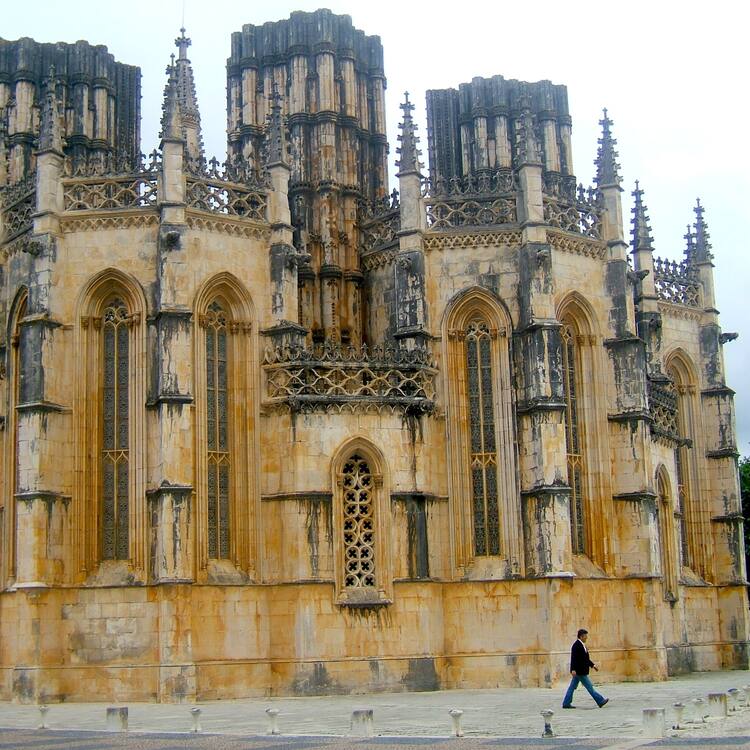
Outstanding Universal Value
Brief synthesis
Constructed in fulfilment of a vow by King João to commemorate the victory over the Castilians at Aljubarrota (15 August 1385), the Dominican Monastery of Batalha, in the centre of Portugal, is one of the masterpieces of Gothic art. The greater part of the monumental complex dates from the reign of João I (1385-1433), when the church (finished in 1416), the royal cloister, the chapter-house, and the funeral chapel of the founder were constructed.
The design has been attributed to the English architect Master Huguet. The chapel's floor plan consists of an octagonal space inserted in a square, creating two separate volumes that combine most harmoniously. The ceiling consists of an eight-point star-shaped lantern. The most dramatic feature is to be found in the centre of the chapel: the enormous medieval tomb of Dom João I and his wife, Queen Philippa of Lancaster. Bays in the chapel walls contain the tombs of their sons, among them Prince Henry the Navigator.
The main entrance of the church is through the porch on the west facade. On both sides of this portal are sculptures of the twelve apostles standing on consoles. In the centre is a high relief statue of Christ in Majesty surrounded by the Evangelists, framed by six covings decorated with sculptures of biblical kings and queens, prophets and angels holding musical instruments from the Middle Ages. This great profusion of sculptures is completed by the crowning of the Virgin Mary.
As a monument charged with a symbolic value from its foundation, the Monastery of Batalha was, for more than two centuries, the great workshop of the Portuguese monarchy. It is not surprising that the most characteristic features of a national art would have been determined there, during both the Gothic and the Renaissance periods. Batalha is the conservatory of several privileged expressions of Portuguese art: the sober architectural style of the end of the 14th century, with the stupendous nave of the abbatial, of which the two-storey elevation, with broad arcades and high windows, renders most impressive; the exuberant aesthetic of the capelas imperfeitas; the flamboyant arcades embroidered in a lace-work of stone: the Manueline Baroque even more perceptible in the openwork decor of the tracery of the arcades of the royal cloister than on the immense portal attributed to Mateus Fernandes the Elder; and finally, the hybrid style of João de Castilho, architect of the loggia constructed under João III (1521-1557).
Criterion (i): The Dominican Monastery of Batalha is one of the absolute masterpieces of Gothic art.
Criterion (ii): The Monastery of Batalha was, for more than two centuries, an important workshop of the Portuguese monarchy. The most characteristic features of a national art were determined here, both during the Gothic and the Renaissance periods.
Within the boundaries of the 0,98 ha property are located all the necessary elements to express the Outstanding Universal Value of the Monastery of Batalha. To reduce the traffic in the old main road (EN1) which crossed the site’s buffer zone, a new road (A14) was built outside the property and a curtain of trees was planted to reduce possible pollution impacts on the monument.
Authenticity
The Monastery of Batalha preserves its authenticity by maintaining its original plans, materials and social and religious significance. The property’s most relevant attributes have been preserved and even reinforced as far as quality is concerned. Conservation and restoration of all stained glass windows and mural paintings in the Royal Cloister and in the Sacristy have been carried out according to the Nara Document on Authenticity. Besides, the Escola Nacional de Artes e Ofícios da Batalha (School of Arts and Crafts) has been supllying skilled workers both for the conservation and restoration of stone elements and stained glass windows.
Ecclesiastical authorities have contributed to the preservation and enhancement of this property, by using the church for religious ceremonies.
Since 9 April 1921, the Chapter House has a permanent guard of honour and is lit by a lamp symbolizing the homeland flame in homage to the Unknown Soldier protected by the mutilated “Christ of the Trenches”.
Protection and management requirements
The Monastery of Batalha was classified as a national monument by a Decree published in the government Journal no. 14 of 17 January 1907.
In order to ensure enforcement of the Law establishing the bases for the policy and system of rules for protection and enhancement of cultural heritage (Law no. 107 of 8 September 2001), Decree no. 140 of 15 June 2009 established the legal framework for studies, projects, reports, works or interventions upon classified cultural assets. It established, as a rule, the need for a previous and systematic assessment, monitoring and weighing of any works that are likely to affect the site’s integrity so as to avoid any disfigurement, dilapidation, loss of physical features or authenticity. This is ensured by appropriate and strict planning, by qualified staff, of any techniques, methodologies and resources to be used for implementation of works on cultural properties.
Furthermore, there is a responsible management policy that has focused on environmental solutions and on maintaining open dialogue and building partnerships with, among others, the municipality so as to overcome the negative effects of undue use of the monument’s surrounding area.
Similarly, according to Decree no. 309 of 23 October 2009, buffer zones are considered special protection zones benefitting from adequate restrictions for the protection and enhancement of cultural properties.
To preserve the authenticity and integrity of the whole monumental complex within a work plan involving the local community is the key management goal. It also takes into account UNESCO’s recommendations in the State of Conservation Report from 1990, namely conservation measures that have been taken to solve the problem of distortion of the lead work and broken panes in the stained-glass windows.
All the interventions that have been implemented or are foreseen comply with current legislation, as well as with strict technical and scientific criteria. There is a special focus on the treatment and rehabilitation of the area surrounding the monument, as these works will be ensured by local organisations involving both the municipality and the local community.
Management of this complex is ensured by the decentralized services of the Directorate General for Cultural Heritage (DGPC), the central administration department responsible for cultural heritage. Conservation, enhancement and safeguarding measures are ensured by DGPC that is responsible for drawing up an annual programme and implementing it so as to secure the future of the monument.
Furthermore, an interpretation centre has been established. Today visitors have access to more areas and to new information that will ensure a better and more integrated knowledge of the World Heritage property.
- National Commission for UNESCO (in Portuguese)
- Sistema de Inventário para o Património Arquitetónico (in Portuguese)
- Monastery of Batalha (Direção-Geral do Património Cultural) 'in Portuguese)
- Direção-Geral Património Cultura (in Portuguese)
The Nomination files produced by the States Parties are published by the World Heritage Centre at its website and/or in working documents in order to ensure transparency, access to information and to facilitate the preparations of comparative analysis by other nominating States Parties.
The sole responsibility for the content of each Nomination file lies with the State Party concerned. The publication of the Nomination file, including the maps and names, does not imply the expression of any opinion whatsoever of the World Heritage Committee or of the Secretariat of UNESCO concerning the history or legal status of any country, territory, city or area or of its boundaries.
State of Conservation (SOC)

Batalha Guide: Visiting Batalha Monastery & More
Batalha, a picturesque town in central Portugal, is a place steeped in history and renowned for its stunning Gothic architecture. Its name, meaning ‘battle,’ refers to the Battle of Aljubarrota fought nearby in 1385, where Portuguese forces triumphed over Castilian invaders. The victory solidified the nation’s independence and led to the construction of the town’s most famous landmark, the Monastery of Batalha, a UNESCO World Heritage Site.

The town’s charm extends beyond its historical significance, offering visitors a blend of culture, art, and natural beauty. Nestled in the lush landscapes of the Leiria district, Batalha’s cobbled streets and traditional houses create a serene atmosphere that invites exploration. The local gastronomy, featuring traditional Portuguese dishes, is another delightful aspect that adds to the town’s allure.
Visiting Batalha provides a unique opportunity to step back in time and experience a slice of medieval Portugal. Its central location also makes it a convenient base for exploring other historical sites and attractions in the surrounding region.
Useful Resources for Your Trip to Batalha
Here’s our top tips and tricks for getting the best deals for your trip to Batalha.
- Accommodation: Booking.com and Airbnb are the two most comprehensive websites for finding hotels, hostels, apartments, and other types of accommodation in Batalha.
- Car Rental: Discover Cars and Rental Cars are the two most useful sites for booking local car rental, particularly in Batalha and the surrounding Central Portugal region. There are normally cheaper deals at the airport.
- Airport transfers: There are taxis and Ubers at Lisbon and Porto Airport, but you can also pre-book an airport transfer with Welcome Pickups .
- Tours & Things to Do: Both Get Your Guide and Viator list lots of local tours and activities in Batalha and the surrounding Central Portugal region.
- Luggage Storage: Luggage Hero and Bounce are two great sites for finding places to store your luggage in Portugal, and are a good place to look for luggage storage in Batalha.
- Public Transport: Cp.pt is the main website for trains in Portugal. For longer distance buses, see Rede Expressos . Flixbus.pt often has cheap tickets between cities in Portugal.
- Flights: Skyscanner and Google Flights are the two most useful websites for finding flights to Portugal. The nearest airport to Batalha is Lisbon Airport.
Although there are other attractions in Batalha, the main attraction is undoubtedly the monastery. Batalha is also close to several nearby towns with other attractions, such as Fátima, which is a famous religious destination, and Nazaré, which is a famous destination for surfers. The picturesque medieval town of Óbidos is also relatively close by — just 45 minutes by car.
Batalha Monastery

The Batalha Monastery, or Mosteiro da Batalha, stands as the focal point of Batalha and a symbol of Portugal’s historical pride and architectural brilliance. Commissioned by King John I to commemorate the Portuguese victory over the Castilians at the Battle of Aljubarrota, its construction began in 1386 and continued for over a century, resulting in a masterpiece that blends Gothic and Manueline styles.

The monastery’s facade is breathtaking, adorned with intricate stonework, flying buttresses, and delicate pinnacles. The main portal’s ornate sculptures and the detailed rose window above it showcase the skilled craftsmanship of medieval artisans. Once inside, the church’s nave impresses with its grandeur, while the Founders’ Chapel houses the tombs of King John I, Queen Philippa of Lancaster, and their famous sons, including Prince Henry the Navigator.

One of the monastery’s most celebrated features is the unfinished Royal Cloister, known as the “Unfinished Chapels.” Intended as a royal mausoleum, its construction halted with the death of King John I’s successor. The open, unfinished chapels provide a hauntingly beautiful glimpse into a grand vision that was never realised. The Manueline ornamentation, with motifs from the sea, reflects Portugal’s age of exploration and its maritime triumphs.

Visitors to the Batalha Monastery can also explore the Chapter House, Refectory, and the beautiful cloisters, each offering a unique aspect of monastic life and artistry. The monastery is not just a monument but a living piece of history, telling stories of devotion, ambition, and the nation’s identity. It remains a must-see destination for anyone interested in architecture, history, or simply experiencing one of Portugal’s most remarkable cultural treasures.
Igreja Matriz da Batalha

The Igreja Matriz da Batalha, also known as the Mother Church of Batalha, is an impressive and historically significant structure that stands as a symbol of the Manueline style in the town of Batalha. Its construction was initiated by King D. Manuel in 1514, at the request of the town’s inhabitants, since the Batalha Monastery did not offer parish services for the local population. The church was completed in 1532, as marked on the main portal, and is thought to have been designed by Boitaca, one of the master architects of the Monastery of Batalha.
The church’s architecture is a fascinating blend of styles, dominated by the Manueline features on the portal, but also including late-Baroque elements from the 18th century and revivalist features from the 1930s. The design exhibits a longitudinal plan with a single nave covered in wood and a quadrangular chancel with a starry vault. Unfortunately, the church suffered damage during an earthquake in 1858, which led to the collapse of the roof and part of the bell tower, causing the building to be abandoned for several decades.
Over the centuries, the Igreja Matriz da Batalha underwent various restorations and enhancements. The interior has been enriched with elements such as a Renaissance stone altarpiece, a baptismal font from the Monastery of Batalha, and tiles from the extinct Ara-Coelis Convent. The church’s main façade is Manueline in style, with detailed ornamentation including plant motifs, the cross of the Order of Christ, and the armillary sphere. The bell tower, added in the 1930s, consists of three registers, topped with a fleur-de-lis balustrade and a pyramidal spire. The Igreja Matriz da Batalha is not only a testament to the rich architectural history of Portugal but also an embodiment of the town’s cultural heritage and devotion.
Getting Here
There are several ways to get to Batalha, but the easiest way is to drive or take the bus.
- Flying : The nearest airport to Batalha is Lisbon Airport. From there, you can hire a car or take a bus to reach Batalha, which is approximately 120 kilometers away.
- Train : While there’s no direct train service to Batalha, you can take a train to the nearby city of Leiria and then use local bus services or taxis to reach Batalha. For train tickets and timetables, see cp.pt.
- Bus : Regular bus services connect Batalha with several major cities, including Lisbon and Porto. The journey offers a comfortable and cost-effective way to reach the town. For train tickets and timetables, see Rede Expressos or Flixbus.pt.
- Car : Batalha is accessible by car and is well-connected by major highways, such as the A1 and A8. Driving allows for greater flexibility and the opportunity to explore the surrounding region at your own pace.
Spotted a mistake? Suggest a correction
Leave a Comment Cancel reply
Save my name, email, and website in this browser for the next time I comment.
Find Portugalist on Facebook | X | Instagram FR | DE | ES | PT
The Monastery of Batalha
Batalha Monastery
The great Dominican monastery of Santa Maria da Vitória in the small town of Batalha, central Portugal , isn’t just a national shrine but one of the finest examples of Gothic architecture in Europe.
Rising high from the valley floor, the monument is a riot of pinnacles, gargoyles, rose windows, buttresses and balustrades wrought in a fine, smooth limestone that time has mellowed to a honey-coloured gold that looks particularly striking at sunset.
It was built in fulfilment of a vow made by King João I on the eve of the famous Battle of Aljubarrota in 1385, during which a united front of Portuguese and English forces (led by Nuno Álvares Pereira) defeated the army of Juan, King of Castile, to secure Portugal’s independence.
The main part of this magnificent building was constructed between 1388 and 1433, with work mostly consisting of the church itself (finished in 1416), royal cloister, Chapter House and Founder’s Chapel.
The original architect was Afonso Domingues who worked on the project from 1388 until 1402. He drew up plans very similar to those of the Santa Maria Monastery in nearby Alcobaça and constructed the choir and side doorway prior to his successor David Huguet (also written Houet and Ouguête) taking charge from 1402 to 1438.
Classified as a UNESCO World Heritage site in 1983, Batalha Monastery (indicated on the Google map below) was finally completed during the reign of King Duarte I, with subsequent monarchs Afonso V and Manuel I respectively adding more cloisters and a lavish array of Manueline ornamentation.
Where to go in central Portugal
80 metres long and 32.5 metres high, the interior of the church is well punctuated with elevated stained-glass windows, some of which are very old, particularly those in the choir.
To the right of the entrance is the Founder’s Chapel, which was built as the resting place of King João I and his English queen, Philippa of Lancaster, daughter of John of Gaunt. They lie hand-in-hand on a high Gothic sarcophagus with the tombs of their equally extraordinary sons set around them, including Prince Henry the Navigator .
To the left of the nave is the Royal Cloister, a marvellous combination of Gothic arches and richly-carved Manueline decoration, and beyond it the more sober but equally elegant Gothic cloister of King Afonso V.
Close by, and very much the magnum opus of the monastery, is the pillar-less, square-shaped, 19-metre-high Chapter House where two unknown Portuguese soldiers lie beneath the glow of an eternal flame and guarded by a sentinel. One fell in Flanders and the other in Africa.
Behind the chancel stand the seven Capelas Imperfeitas (Unfinished Chapels) surrounding a large octagonal space with a stunning coral-stone entrance. Roofless and open to the sky, the chapels were begun in 1435 by King Duarte I who died three years later and despite the valiant efforts of King Manuel I, they remain incomplete to this day, hence the name.
Need more sightseeing ideas for your next visit? Listen to the Portugal Travel Show , the podcast for people planning a trip to sunny Portugal…
Related Articles
The Roman City of Cetóbriga
The Climb to Cloud Nine
The Capelinhos Moonscape

Batalha Portugal: The Ultimate Guide to Batalha [2024]
Batalha is a peaceful town around 120km north of Lisbon with one very big surprise. The name of the town – Batalha – literally means battle and was the stage for one of the most important battles in Portuguese history. In 1385, Batalha de Aljubarrota secured Portuguese independence from Castile. To honour that victory, King João I constructed one of the finest monasteries in Portugal, Mosteiro da Batalha.
This grand monastery was the Portuguese Monarchy’s main building project for over two centuries. Representing the architectural transition from Gothic to Manueline, and although never finished, would influence Portuguese architecture for generations. Batalha might only be a small town, but it packs a strong historical punch. Anyone interested in history or architecture should place this town and its UNESCO heritage site high on your list of places to visit while in Portugal!

Top Things to See and Do in Batalha
The town of Batalha is dominated by the monastery. So no surprises its many features make the list of top things to see and do. However, the small streets surrounding the monastery ooze small town charm, and you’ll even find a few other historical curiosities. Following your visit to the monastery we do recommend you take a wonder through the streets and find somewhere for a coffee!

If you’re interested in finding out more about the battle and the history of the area that make sure to stop at the interpretation centre (Fundação Batalha de Aljubarrota). It’s located around a 5-minute drive outside the town and well worth a stop!
The Mosteiro da Batalha (Batalha Monastery)
The Mosteiro da Batalha is one of the finest religious buildings of Portugal and recognised as a place of World Heritage by UNESCO . The local legend states that on the eve of the battle, King João prayed to the Virgin Mary. Asking for her assistance and vowing to build a monumental monastery should the Portuguese be victorious. Three years later, the king would return to Batalha and begin building the grand monastery in 1388. It would become a multi-century project taking over 150 years across multiple phases of construction.

For that reason, you’ll find an array of features in not only Gothic style, but also Manueline and some Renaissance touches. Multiple alterations were made to the initial project. Resulting in a vast monastic complex that today includes a church, two cloisters, two royal pantheons – the Founder’s Chapel, and the Unfinished Chapels. For anyone interested in Portuguese history, Mosteiro da Batalha is an essential destination.
The Main Church and Interior
The monastery complex is split into several different areas. Some of which some are public access and some are paid access. The main church: its nave, its impressive portal, and slightly smaller south portal are free to access to anyone. Today it still operates as a functioning church so depending on the timing of your visit you may see church services.

Igreja de Santa Maria da Vitória to give the church its full name in Portuguese is one of the most impressive churches in Portugal. At around 80m long, and 30m high, its columns and vaulted ceilings really impart the sheer size and scale of the monument. Also reflecting the ambition of King João I. Even if you’re not interested in religious heritage, the scale of the church is impressive. The church itself is organised into three naves, a central taller and wider nave, straddled by two narrower naves. Between them grand arches and stained-glass windows.

The next sections will require you to purchase a ticket that currently costs €6 for an adult, but several concessions are available for children, students and seniors. To really explore the site, we do recommend you purchase this ticket!
Founder’s Chapel (Capela do Fundador)
To the right of the main entrance is the Founder’s Chapel. A place that from its conception was intended to be a Royal pantheon, a place for João I’s family to be laid to rest surrounded by grandeur. At the centre of chapel, lies the tomb of King D. João I and Queen D. Filipa de Lencastre. On the lid of what is the largest 15th century gothic sarcophagus in Portugal is a sculpture of the royal couple at rest holding hands. Above them, an intricate star shaped vault surrounded by stained glass windows. If the sheer size and scale of the tomb wasn’t enough, the intricate details of each individual tomb and surroundings of the chapel should impress. Surrounding the central tomb, are the inset tombs, of the “illustrious generation” as the poet Camões referred to them.

The Tomb of the Unknown Soldier ( Túmulo do Soldado Desconhecido )
In 1921, the monastery would be given a renewed impetus as a place of reflection not just for the monarchy, but also for Portugal’s Military. Becoming the place of rest for two unknown soldiers from the First World War. One from the battlefield of Flanders, and another from Africa. They were interned on the 6 th April 1921 in the Chapter House. A Guard of Honour keeps watch, and the ‘Flame of the Mother Country’ is kept lit.

In the courtyard of the monastery you’ll find an olive tree which provides the olives, and oil which keeps the flame burning. Silence and respect is expected, and you’ll find the sound of soldiers boots echoing along the corridor during the changing of the guard quite remarkable.
Capelas Imperfeitas (Imperfect Chapel, Flawed Chapel)
The Capelas Imperfeitas, often translated to either the imperfect, flawed, or unfinished chapels are a separate section of the complex accessible from its northern face. You’ll still need your ticket to enter. The construction of the chapels began in 1434 under King Duarte I, but suffered from the same stop/start fate as the rest of the complex. Both the Master Builder and Duarte I would pass away several years later, leaving the unfinished chapel to King Manuel.

King Manuel would impart many of the Manueline features including the incredibly detailed portal, and the 7 funeral chapels that surround the octagonal space. In 1533, Renaissance features were added in the form of a large balcony by King João III. The twin tomb of King Duarte and Queen Leonor would only be added to the pantheon in 1940.

The details and full history of the Monastery of Batalha could easily fill multiple posts, so for now we’ll move on to elsewhere in Batalha.
The Centro de Interpretação da Batalha de Aljubarrota museum
The Centro de Interpretação da Batalha de Aljubarrota (CIBA ) is a museum and exhibition centre constructed on the historical battle site of Aljubarrota. CIBA describes itself as edutainment aiming to both educate and entertain visitors and all topics covering the famous battle. There’s three parts or exhibitions, the first covering the Architectural heritage of the battle.

The second, focusing on setting the scene, timeline and history of the battle, and the movements of the day. Of note are the displays of skeletons and weaponry found during the archaeological surveys of the site. The final part of the exhibition is a movie – A Batalha Real. Shown in the auditorium of the site, which combines documentary, and re-enactment with story telling elements.

The interpretation centre is open Tuesday to Sunday, from 10 am to 5:30 pm. Tickets cost €7 for an adult, with discounts available for young and old! The CIBA museum is 3km south of Batalha, if you do not have a rental car a taxi is around €6 each way.
Casa da Padeira de Aljubarrota (The Baker of Aljuborrota)
A unique story, and perhaps one of our favourite examples of Azulejo tiles is a further 7km outside of Batalha. Here you’ll find a building named Casa da Padeira de Aljubarrota and a statue. The statue of a woman with what looks like a spade held in the air. Located on the walls of the building behind the statue will give you the details of the Baker of Aljubarrota, a local legend.

This legend states that a local baker named Brites de Almeida, after returning from giving aid at the battlefield found seven Spanish soldiers hiding in her bread oven. The seven soldiers refused to leave and surrender. The quick-thinking baker then lit a fire with hay to smoke them out of the oven, before giving each one a death blow from her iron bakers shovel. The baker is now honoured as a local and Portuguese heroine. To this day, there are rumours that the town hall in Alcobaça keeps the bakers shovel in storage! It’s unique but probably only worth stopping if you have a car or alternative method of visiting.
How Long Should you Spend in Batalha?
Batalha is a small but very likable town. However the main thing to see and do is of course the monastery. Combining the monastery, with the town, and perhaps some local food will occupy an easy half day, or even a few hours if you just want to see the main site. Other than Mosteiro da Batalha, the site of the battlefield, and the interpretation centre, there is not much else to see and do. Of course many people choose to skip the interpretation centre and only focus on the monastic complex.

It can make a short day trip, or combined with one of the nearby towns of Alcobaça, Fátima, Óbidos or even one of the coastal towns like Peniche or Nazaré to make a full day trip of sightseeing. Combining it with one of the historical towns keeps the theme of the day going, but combining it with Nazaré or Peniche means you can cover both the historical side of Portugal and some of its incredible coastline in the same day.
Should you Spend the night in Batalha?
Unique to Batalha is the continual arrival of day trippers and tourers that stay for a couple of hours before leaving again. After these types of tourists leave, the town becomes much much more peaceful and opens itself as a slower paced destination. There are quite a few restaurants covering both local and international cuisine so it’s easy to find a good meal too! It’s a great place to base yourself if you’re planning on sticking around the central region and want to explore a few of the towns and places mentioned above as a day trip. Batalha has several great hotels and being further away from the coast and resort towns, the accommodation tends to cost significantly less.
Why was the battle of Aljubarrota so Important?
The battle of Aljubarrota resulted in a decisive victory for Portugal against the Castilians, ruling out any Castilian ambitions for the Portuguese throne. It established João I as the king of Portugal from 1385 to 1433. If the Castilians had defeated the army of King João, Portugal would likely have been absorbed into Spain. However, The Portuguese and their allies won, establishing a new Portuguese dynasty – the House of Aviz.

English aid to the battle, in the form of long-bowman veterans from France, also reinforced the Anglo-Portuguese Treaty of 1373. Which would become the Anglo-Portuguese Alliance. Today recognised as the oldest political alliance in world history. The battle was remarkable due to the numbers and the shocking defeat, around 6,000 men under the Portuguese command, and 31,000 men under the Castilian command. You’ll find a monument to Nuno Álvares Pereira, the brilliant tactician who led Portugal and its allies to victory outside Batalha Monastery.
How to Get to Batalha?
From Lisbon to Batalha the bus services are operated by Rede Expressos , who are one of the biggest intercity transport companies in Portugal. Currently there are only a few daily services from Lisbon to Batalha and it costs €12 each way, or €11.40 each way if you book the return ticket at the same time. Attempting a day trip will be tight but possible, the first bus departs Lisbon at 12:00 and arrives in Batalha at 14:00. The last bus departs Batalha at 18:15 and arrives in Lisbon at 20:15. Alternatively, there is a departure at 08:15 in the morning should you want to consider an overnight trip. As always, we recommend checking the exact time tables before organising your trip!
For people already exploring the Centro region of Portugal, there are local bus services between most of the towns like Batalha, Fatima, Alcobaça, Nazaré and Tomar operated by the local operator by Rodotejo .
Organised Tours to Batalha
With its UNESCO World heritage site, Batalha is a very popular place to take a day trip or organised tour. Although it’s rare to find a tour that specifically only goes to Batalha, you’ll find several that combine Batalha with nearby destinations like Óbidos, Nazaré, Fatima, and Alcobaça . We did mention this part of Portugal was packed with amazing places to visit didn’t we? Most of these are large group tours – coach trips that will start in Lisbon and bring you back in the same day, but if you’re willing to up your budget you’ll find private options as well!
Here’s our pick of our favourite and best reviewed tours:
- From Lisbon: Fátima, Batalha, Nazaré & Óbidos Full-Day Tour (€80 per person)
- Lisbon: Private Guided Tour of Tomar, Batalha, and Alcobaça (€100 per person)
- Fatima, Batalha, Nazare, Obidos Private Full Day Tour (€319.90 for two)

Where to Stay in Batalha?
Batalha is definitely less of an out and out tourist destination then nearby resort towns, however it still has several fantastic options for overnight stays, and longer stays if you’re interested in using Batalha as a base! Our personal favourite is Hotel Vila Batalha . A wonderful hotel just a short walk from the main sites in Batalha. It’s pool and spa were a fantastic place to unwind after a few busy days exploring central Portugal! You can take a look at the full range of options with this list here!

Should you Visit Batalha?
Batalha is a great town to visit, or even base yourself in to explore the slower paced inland Central Portugal . Surrounded by authentic sites, and some great local food, Batalha makes a good day trip, or a great stopping point for longer trips. If you want to fully absorb yourself in Portuguese history and historical sites, then combining Batalha with nearby Tomar , or Alcobaca , is also a great option!
2 thoughts on “Batalha Portugal: The Ultimate Guide to Batalha [2024]”
I am looking for a former hunting lodge used by the British elites turned to a hotel it was in a heavily wooded area just out of Batalha
Sounds like you could be thinking of Bussaco Palace. It was a former convent, turned into a Palace by Portuguese Royalty. Then used as a rural hunting lodge by the royal family and guests. I’m not aware of a connection to British elites though. Do let us know if you find out!
Leave a Comment Cancel reply
www.visitportugal.com

- Share RSS Partilhe E-mail
Mosteiro da Batalha
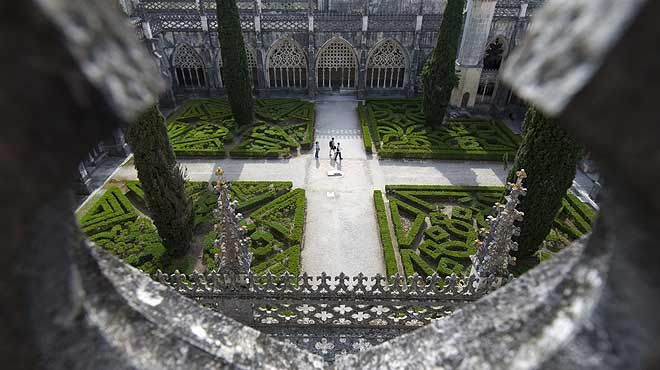
Monastery of Santa Maria da Vitória (or Monastery of Batalha) One of the most fascinating places in the Iberian Peninsula. A decisive event for the consolidation of the Portuguese nation took place on August 14, 1385, near the spot where the Monastery of Batalha stands: D. João, Master of Avis and the future king of Portugal, overcame the Castilian armies in the battle of Aljubarrota. This victory put an end to a dynastic crisis that had dragged on since 1383, since the death of King Ferdinand, whose only daughter was married to the King of Castile, an aspirant to the throne of Portugal. D. João dedicated the monastery to the Virgin Mary, who he had invoked to intercede his triumph and donated it to the Dominican Order, to which his confessor belonged. This gave way to the birth of a work whose construction would last for almost two centuries and which resulted in one of the most fascinating Gothic monuments of the Iberian Peninsula. The construction of the monastery also embodied the consecration of King João I as king of Portugal, thus assuming itself as a symbol of the new dynasty and legitimised by divine will. Its architectural value and historical significance spurred the classification of the monument as a UNESCO World Heritage Site in 1983. The construction included seven reigns of the second dynasty (1385-1580) and involved a large team of master masons of a high level, both national and foreign, that were initially directed by Afonso Domingues, until his death, in 1402. During this period, part of the church and the royal cloister were erected. He was succeeded by Master Huguet, an Englishman, who by 1438 completed the church, built the chapel of the founder and began work on the pantheon of D. Duarte. Between 1448 and 1477, Fernão de Évora designed the cloister of D. Afonso V and, in the 16th century, Mateus Fernandes was responsible for the Unfinished Chapels. The monastery houses the most important nucleus of Portuguese medieval stained glass windows, which can be admired in the Chapel and the Chapter Hall. The central nave of the church stands at 32.5 metres and rests on eight columns on either side. In addition to the chapels and the cloisters, the monastery's dormitory, dining room and kitchen can also be visited. The square outside was once largely occupied by the Cloister of D. João III. Burned down during the Napoleonic Wars, it was demolished during renovation works undertaken in the mid-nineteenth century. In the middle of the square you will see a tombstone that replicates the acronyms of several masons and marks the site of the old Santa Maria-a-Velha Church, the original temple where the monastery's builders attended the liturgical services.
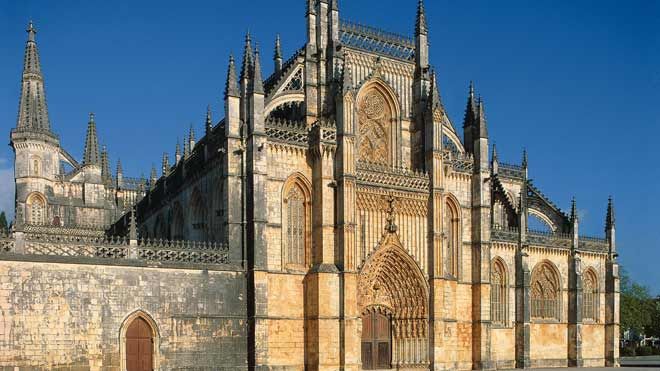
Your opinion
- Characteristics and Services
- Accessibility
- Other informations
1 April / 15 October: 9am-6.30pm 16 October / 31 March: 9am-6pm
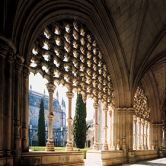
- Portugal Identity Card
- Getting to Portugal
- Useful Information
- Postcards and Wallpapers
- Maps and Brochures
- Useful phrases

- Portugal by...

- Travel Diaries
Menu Destinos
- Porto and the North
- Centro de Portugal
- Lisboa Region
- See All Regions

- Travel Agencies
- Accommodation
- Protected Areas
- Bars and Discotheques
- Brochures Maps and Videos
- Science and Knowledge
- Tours and Other Tourism Services
- Useful Contacts
- Embassies and Delegations
- Gardens, Parks and Forests
- Towns and Villages
- Marinas and Harbours
- Museums, Monuments and Sites
- Other Interesting Features
- Tour Operators
- Theme Parks
- Restaurants and Cafés
- Rent-a-Car and Caravans
- Baths, Spas and Thalassotherapy
- Transport Terminals
- Transport Companies
- Regular Transport Services
- Zoos and Aquariums
- Art and Culture
- Outdoor Activities
- Youth tourism
- Short breaks
- Health and Well-being
- Sun and Sea
- Accessible Tourism
- Nautical Tourism
- Religious Tourism
- All About Portugal
- Learn about
- What to do?
- What are you looking for?
- Remember & Share
- Login with Google
- Login with Facebook
- Login with Twitter
MyPortugalHoliday.com
The best independent guide to Central Portugal
Obidos – Nazaré - Ericeira - Batalha - Tomar - Peniche - Alcobaça – Mafra - Berlengas Islands
Batalha Monastery (Mosteiro da Batalha) Image Tour and Guide
The Batalha Monastery is one of the most impressive religious buildings of Portugal. This Gothic monastery was commission by King João in gratitude for the decisive victory in the battle of Aljubarrota (1385), and the grand designs took over a hundred years to construct.
The Mosteiro da Batalha is a beautiful representation of the transition from the Gothic style of architecture through to the decorative Manueline style, and a visit to this iconic monument should be included in your tour of central Portugal. This article will provide a tourist guide and image tour of the Mosteiro da Batalha.
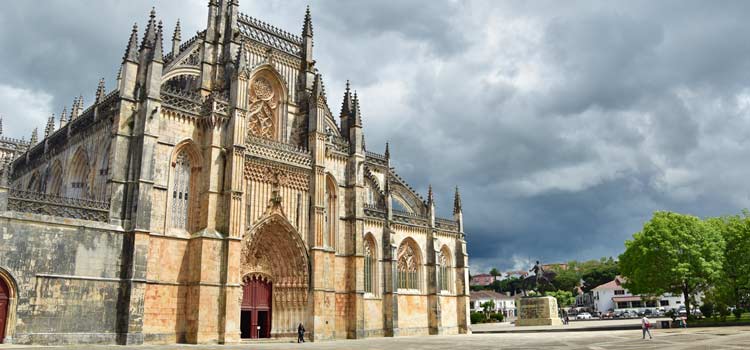
The magnificent Mosteiro da Batalha
Tourist Information Batalha Monastery
It is free to visit the main church, with its high vaulted ceilings and original stain glass windows, but to experience the true magic of the monastery, the paid sections must be visited. The €7.50 entrance fee provides access to the Founders Chapel, the two cloisters and the unfinished chapel. There is a free audio guide with the entrance fee. Insight: Tickets for the Batalha Monastery (€8) can be pre-purchased here, to avoid ticket queues
At least two hours are needed to fully explore the monastery (this includes the exterior, church, cloisters and chapels). Organised coach tours often only provide enough time to view the exterior of the monastery and the church nave.
If you wish to see the entire complex consider making a day trip to Batalha, also a day trip should also include the informative Fundacao Batalha de Aljubarrota museum. Batalha is a peaceful Portuguese town, and is a pleasant location for a night’s stay.
Image tour of the Mosteiro da Batalha
Most visitors arrive by coach and their first view of the monastery is across the Largo Do Mosteiro. At the centre of this plaza is a statue of Nuno Álvares Pereira (Estátua D. Nuno Alvares Pereira). He was the brilliant military commander who was credited for winning the battle of Aljubarrota and keeping Portugal as an independent country.
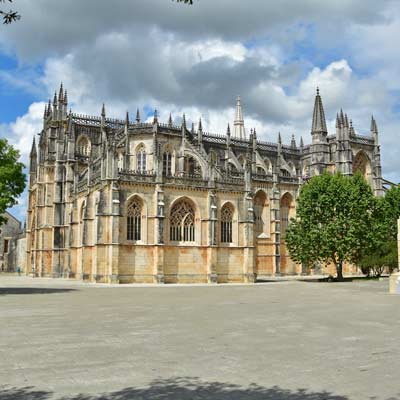
The Largo Do Mosteir is usually filled with coach loads of tourists
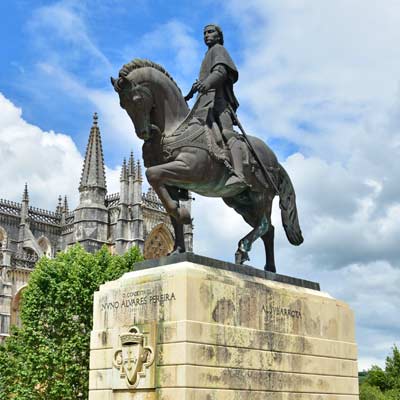
The statue of Nuno Álvares Pereir, the true hero of the battle of Aljubarrota
Before heading into the church via the main portal (on the western side) walk to the eastern side and view the Transept Portal and the exterior of the Capelas Imperfeitas (Unfinished Chapel). The stain glass windows above the Transept Portal are some earliest examples in Portugal and add a flash of colour to the sombre interior.
At the eastern end of the monastery the seven pillars of the Capelas Imperfeitas can be seen raising from the midst of the chapel. The Unfinished Chapel has elaborate Manueline stone carving and is the burial location for King Duarte I, but there is no roof!
An admission ticket is needed to enter the chapel, and the normal flow of the tour means it is the last section of the monastery to be visited.
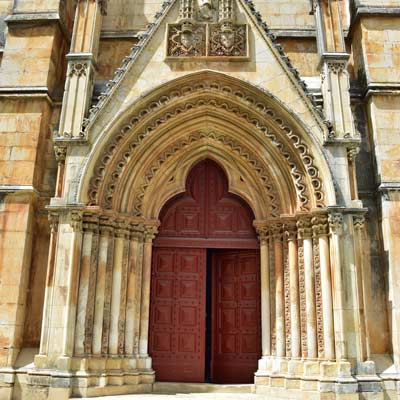
The southern Transept Portal
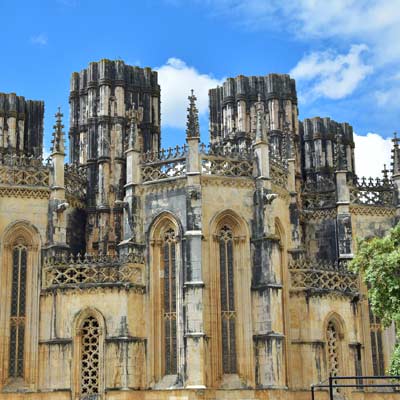
The massive, unfinished columns of the Capelas Imperfeitas
On the walk to the main entrance on the western side of the monastery, observe the numerous pinnacles and flying buttresses. The flying buttresses are not just decorative and were designed to support the high vaulted walls of the Nave and the Founders Chapel.
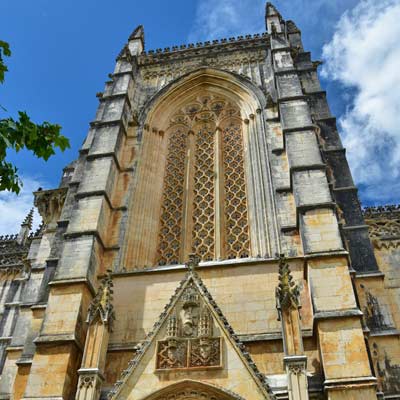
The medieval stain glass windows are characterised by their small panels
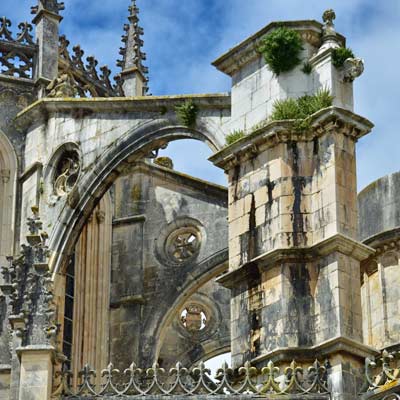
The flying buttress give strength to the tall outer walls of the church and chapel
The main portal is myriad of carved arches and wonderful stone statues, which covers most of the western wall. The lower statues represent the Apostles, above them are angels and at the pinnacle is a statue of Christ.
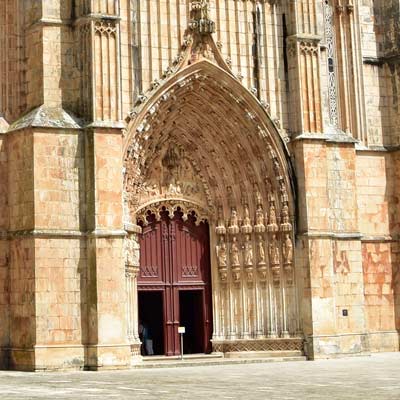
The main entrance to the church
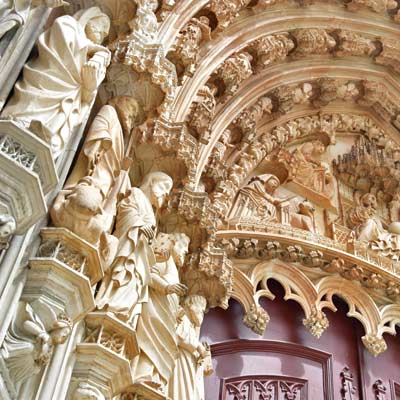
The incredible detail of the stone carving
The interior of the church follows classic Gothic designs, with a Latin cross layout and minimal ornamental features. The two real features are the early examples of stain glass windows and the incredible height (32m), which is remarkable considering the church was constructed in the 14th century.

Height is the dominating impression of the interior
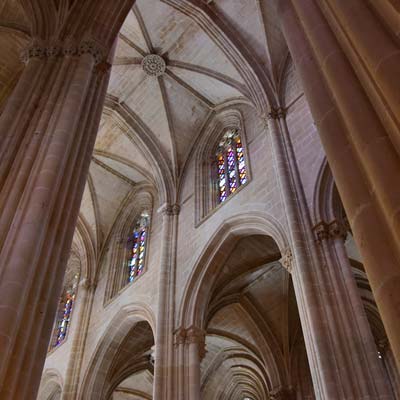
The main nave is surprisingly light and airy
Ticketed section of the Batalha Monastery
The following areas of the monastery can only be visited with the admission ticket.
The Capela do Fundador (Founders Chapel) was the first royal pantheon of Portugal, and is one of the most stunning sections of the monastery. The unique octagon chamber contains the combined tomb of King John and his wife, Queen Philippa, with the tombs of their children lining the side walls.
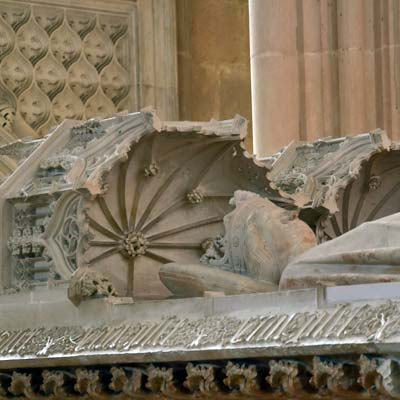
The tomb of King John, carved in his full suit of armour
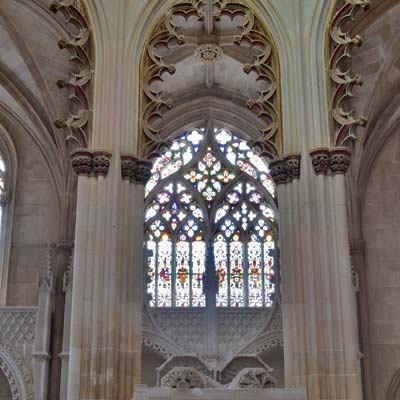
The Founders Chapel with the tomb of João and Philippa in the centre
The tour now visits the two cloisters, which were later additions to the church.
The first cloister is the Claustro Real (Royal Cloister) and often referred to as the Claustro de Dom João I (King John Cloister), and is the beautiful combination of Gothic arches with Manueline lattice stonework.
The second cloister, the Claustro Dom Afonso V (Cloister of King Afonso V) follows the conventional designs of medieval cloisters, and is much more austere.
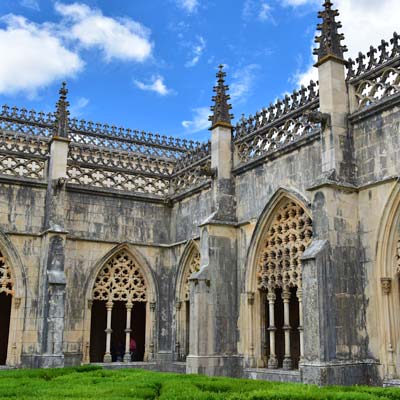
The intricate stone lattice work of the Claustro Real
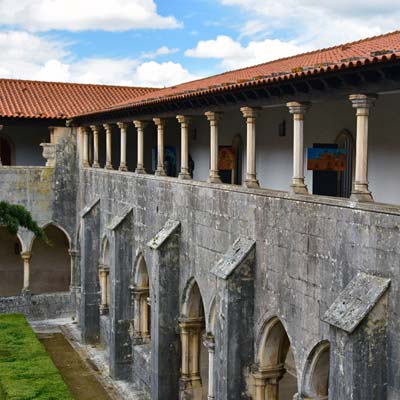
The Afonso V cloister was the first example of two levels
On the eastern side of the Claustro Real, is the Sala do Capitulo (the Charter House), and was where monks would hold meetings and religious discussions. This chamber is impressive for medieval architecture, as it spans 19m and is unsupported. During its construction, the architects were so concerned about the roof collapsing that they only employed convicted criminals.
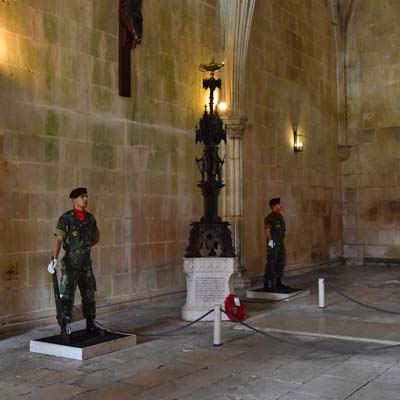
The memorial to the Unknown Soldier
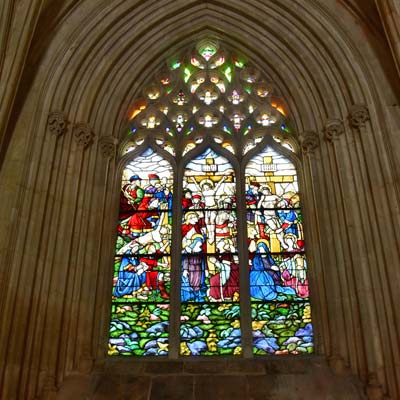
The stain glass window adds colour to the sombre chamber
Today the Sala do Capitulo is the location for a memorial to the Unknown Soldier and has a permanent guard of honour. The single window in the chamber is a beautiful example of Renaissance stain glass and depicts the passion of Christ.
Before leaving the chamber, have a look at the (presumed) stone carving of Master Huguet, the architect responsible for the Charter House.
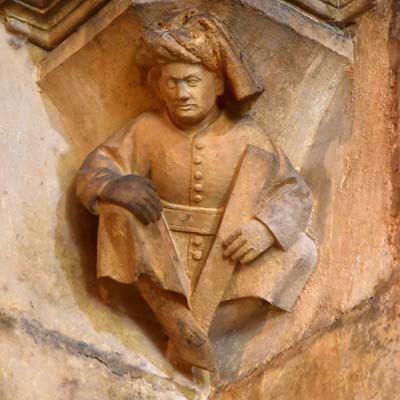
Master Huguet with his measuring stick….
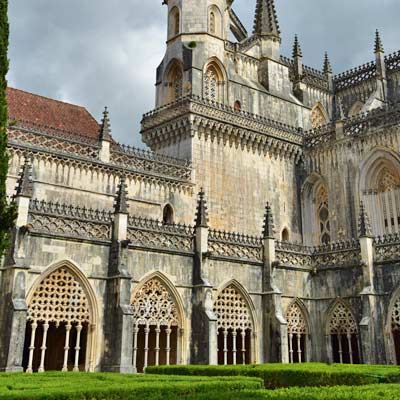
The main church and Charter House as seen from the Claustro Real
The refectory is vast but sparse, and was where the monks ate their meals in silence. Before entering for meals, the monks would symbolically wash their hands, and there is a beautiful fountain outside of the refectory.
Between the two cloisters is a long room, which was initially designed as a communal dormitory, but the Dominical monks believed in solitude, so the area was little used. This is the medieval example of a designer not listening to what user wants……
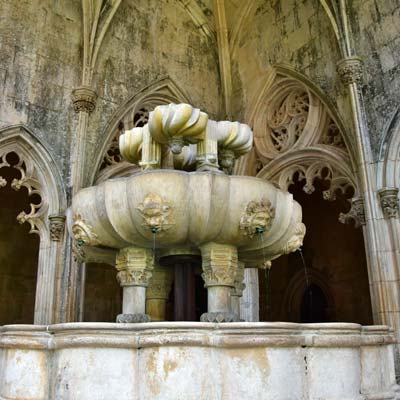
The fountain where monks would wash their hands
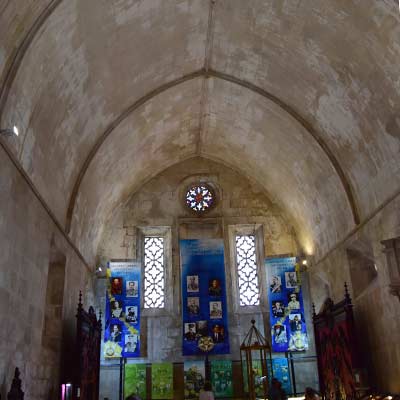
The refectory is as plain on the exterior as the inside….
The Claustro Dom Afonso V is typical of other Portuguese Gothic monasteries, and could be considered rather plain in comparison to the extravagant Claustro Real. At it’s constructed the King Afonso V cloister was of a novel design, and was the first example of a double layer cloister in Portugal.
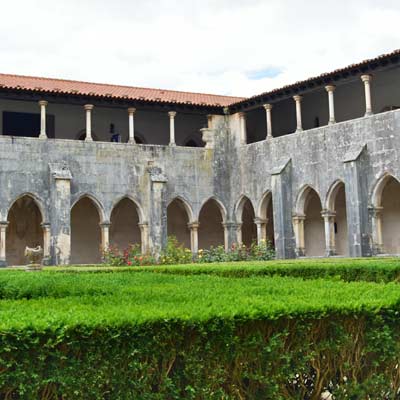
The dual layers of the Dom Afonso V cloister
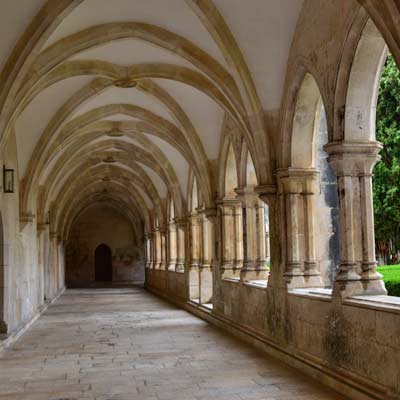
Classic Gothic architecture
The final stage of the Batalha Monastery is to visit the unfinished chapel (Capelas Imperfeitas), which is to the rear of the main church. This section is possible to miss, as you must exit the monastery and cross the Largo Infante Dom Henrique to the small side entrance to the chapel.
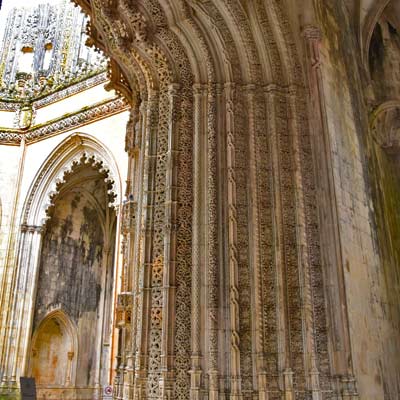
The flamboyant Manueline stone carving on the portal to the unfinished chapel
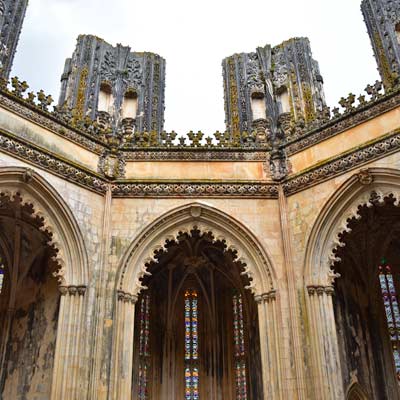
The massive pillars give some indication of the architect’s final ideas for the chapel
The Capelas Imperfeitas was commissioned by Duarte I (King Edward) to be a royal pantheon for him and his family (the second of the church), but it was never completed due to the premature death of the king (in 1438) and then the death of the main architect, Mateus Fernandes. The chapel is one of the earliest examples of Manueline architecture, characterised by its elaborate stone carving, as seen on the stone pillars. Though the chapel was never completed, King Duarte’s tomb was placed in the Capelas Imperfeitas.
Discover more of central Portugal with our guides

The vibrant and dynamic capital of Portugal

Extravagant palaces, opulent villas, and stunning scenery

The finest resort town of the Lisbon coastline

The classic Portuguese walled town, owned by the Queen of Portugal
- Serra da Arrabida

Stunning mountains and picturesque beaches south of Lisbon

The capital of the Alentejo region is steeped in history

Experience true Portugal in this busy fishing port

Delightful beach town, which is a favourite with the Portuguese

The ancient stronghold of the Knights Templar
Costa da Caparica

Lively resort town and 13km of golden sands

Trendy surfing town set along a beautiful coastline

Magnificent monastery and site of Portugal’s most important battle

Important pilgrimage site where Mary appeared to three shepherds

A charming town, famed for the world’s highest surfing waves

Traditional fishing port surrounded by magnificent beaches
V ila Nova de Milfontes

Authentic Portugal on the undiscovered Alentejo coastline

Heavily fortified town on the Spanish border

Paradise beaches and the secluded hideaway of millionaires

Wild and windswept islands, a refuge to seabirds and sea life

Sophisticated beach resort along the beautiful Lisbon coastline
A complete list of all of our guides to central Portugal
- Obidos Introduction
- Things to See in Obidos
- Obidos day trip
- Lisbon to Obidos
- Tomar Introduction
- Things to see in Tomar
- Lisbon to Tomar
- Evora Introduction
- Evora Things to See
- Day Trip to Evora
- Lisbon to Evora
- Capela dos Ossos
- Evora or Sintra?
- The Alentejo region
- Fatima introduction
- Lisbon to Fatima
- Mafra Introduction
- Lisbon to Mafra
- Ericeira introduction
- Lisbon to Ericeira
- Ericeira beaches
Central Portugal
- Alcobaça monastery
- N2 road tour
- São Martinho do Porto
Portugal Guides
- Where to go in Portugal
- 1 week in Portugal
- A weekend in Portugal
- When to visit?
- Portugal's best beaches
- Top 10 Portugal
- Portugal airports
- Portugal for families
- Lisbon to Porto tour
- Where to live in Portugal
- Portugal in January
- Portugal in February
- Portugal in March
- Portugal in June
- Portugal in July
- Portugal in August
- Portugal in September
- Portugal in November
- Portugal in December
- Portugal in the winter
- Sintra introduction
- Sights of Sintra
- Day trip to Sintra
- Lisbon to Sintra
- Sintra beaches
- Sintra tourist bus 434
- Palacio da Pena
- Palácio de Monserrate
- Quinta da Regaleira
- Parque da Pena
- Castelo dos Mouros
- Cascais introduction
- Day trip to Cascais
- Cascais beach guide
- Cascais sights
- Cabo da Roca
- Lisbon to Cascais
- Sesimbra intorduction
- Sesimbra sights
- Sesimbra's beaches
- Lisbon to Sesimbra
- Cabo Espichel
- Setubal introduction
- Setubal sights
- Day trip to Setubal
- Setubal's beaches
- Peninsula de Troia
Near Lisbon
- Fonte da Telha
- Lagoa de Albufeira
- Praia das Macas
Lisbon Guides
- Lisbon introduction
- Lisbon top 10
- Secret Lisbon
- Lisbon beach guide
- 24 hours in Lisbon
- 48 hours in Lisbon
- 3 days in Lisbon
- Lisbon in 5 Days
- 1 Week Lisbon
Lisbon day trips
- Where to stay?
- Lisbon shopping
- Lisbon Parks
- Lisbon on a wet day
- Museums and galleries
- Alfama District
- Baixa District
- Belem District
- Parque Nações
- Alcântara District
- Graça District
- Cais do Sodre
- Lisbon airport
- Lisbon Metro
- Castelo de São Jorge
- Elevador Santa Justa
- Torre de Belem
- Elevador da Bica
- Elevador do Lavra
- Elevador da Gloria
- Praça do Comercio
- Mosteiro dos Jerónimos
- Padrão dos Descobrimentos
- Lisbon Viewpoints
- Miradouro da Graça
- Sao Pedro de alcantara
- Senhora do Monte
- Lisbon to Belem transport
- Costa da Caparica Portugal
- Lisbon at Christmas
- Santos Populares
- Lisbon for Families
- Lisbon for Seniors
- Cristo Rei Christ
- Lisbon Markets
- Ponte 25 de Abril
- Príncipe Real
- Free Lisbon
- Is Lisbon Walkable
- Lisbon Budget
- Driving in Lisbon
- From the airport
- To Cristo Rei
- Lisbon to Porto
- Lisbon tram guide
- Lisbon Ferrys
North Portugal
- Douro Valley
- Serra da Estrela
- Viana do Castelo
- Porto where to stay
- How Long in Porto
- Porto sightseeing
- Porto beaches
- Porto in 1 Day
- Porto in 3 Days
- Porto 1 Week
- Foz do Douro
- Linha do Douro
- Port Cellars
- Airport to City
- Porto Trams
South Portugal
- Algarve introduction
- Albufeira guide
- Albufeira activities
- Albufeira beaches
- Day trip to Albufeira
- Albufeira boat trips
- Carvoeiro beaches
- Percurso dos Sete Vales hike
- Sights and activities
- Faro beaches
- Funchal introduction
- Lagos guide
- Lagos beaches
- Praia da Marinha
- Praia da Rocha
- Praia da Rocha beaches
- Tavira guide
- Tavira sights
- Tavira Beaches
- Vilamoura beaches
- Vila Nova de Milfontes
Batalha Monastery (Mosteiro da Batalha) © 2024 MyPortugalHoliday.com - Privacy Policy & Contact Us Page

Discover more of Portugal

What are the best day trips from Lisbon?
1 week in Lisbon

Inspirations for your 1-week holiday to Lisbon
Sophistication along the Lisbon coastline

Guias e Roteiros / Experiências / Comunidade / Ver e Fazer
World Heritage
Monastery of Alcobaça
Monastery of batalha, university of coimbra, alta and sofia, convent of christ in tomar.
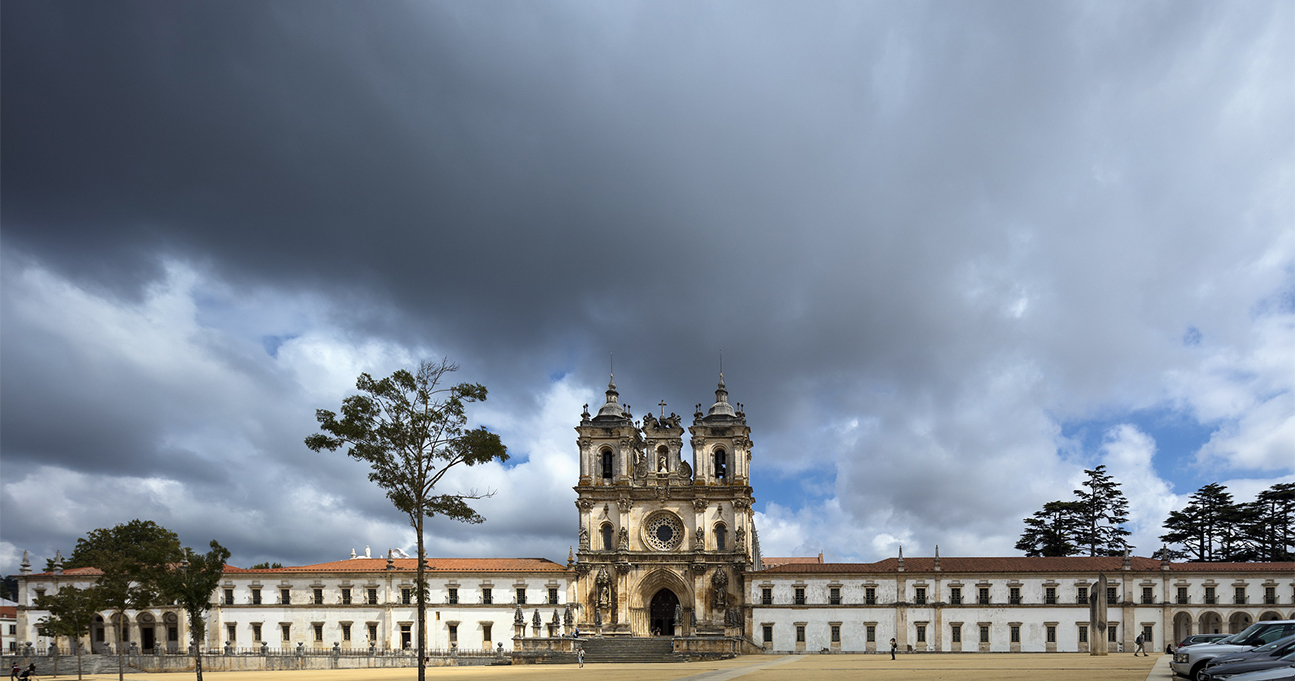

How To Visit The Monastery Of Batalha In 2024
The Monastery of Batalha, officially the Monastery of Santa Maria da Vitória (in Portuguese, Mosteiro da Batalha or Mosteiro de Santa Maria da Vitória, respectively), is a Manueline-style monument that was built by King João I. Located in the town of Batalha, in the Leiria district, it was dedicated to the Virgin Mary as a way of thanks for the Portuguese victory in the Battle of Aljubarrota against the Castilians!
The Monastery of Batalha was classified as a National Monument in 1910 and inscribed on the UNESCO World Heritage List in 1983. In addition, it was declared one of the “7 Wonders of Portugal” in July 2007 and gained the status of National Pantheon in May 2016!
So, do you want to know How To Visit The Monastery Of Batalha In 2024? Keep reading!
This post may contain affiliate links, meaning I earn a small commission if you make a purchase, at no additional cost to you. Please read my disclosure & privacy policy for more information.
No time to read now? Pin it for later!

World Heritage
Opening hours & ticket prices, unfinished chapels, brief history of the monastery of batalha.
As I mentioned before, the history of the Monastery of Batalha (and the town of Batalha) began with the Battle of Aljubarrota, fought on August 14th, 1385. On one side of the dispute, the Kingdom of Portugal (led by King João I of Portugal and its Constable D. Nuno Álvares Pereira, and supported by the Kingdom of England); on the other, the Kingdom of Castile (led by King João I of Castile and supported by the Kingdom of France and the Crown of Aragon).
The decisive victory of the Portuguese put an end to the Dynastic Crisis of 1383-1385 and led to the acclaim of D. João I, the Master of Aviz, as King of Portugal and the first of the Aviz Dynasty (or Joanine Dynasty). This battle also gave rise to the Anglo-Portuguese Alliance – the oldest diplomatic alliance in the world still in force – which was established on May 9th, 1386, with the signing of the Treaty of Windsor.

That being said, the Monastery of Batalha was founded in 1386 and its construction took almost 200 years. For this reason, the monument integrates different architectural styles, of which Manueline (or late Portuguese Gothic) stands out. Likewise, the works were supervised by different architects: Afonso Domingues, David Huguet, Martim Vasques, Fernão d’Évora, and Mateus Fernandes.
Did you know that the Monastery of Batalha was part of Portugal’s first set of inscriptions on the UNESCO World Heritage List ? This 7th session of the World Heritage Committee took place in Florence (Italy), between December 5th and 9th, 1983.
Four other Portuguese sites were announced in the session: the Central Zone of the Town of Angra do Heroismo in the Azores; the Convent of Christ in Tomar ; and the Monastery of the Hieronymites and Tower of Belém in Lisbon.
Nowadays, Portugal is the ninth country in Europe and the eighteenth country in the world with the most UNESCO sites, tied with Czechia and Poland. It has seventeen heritage assets (both cultural and natural) inscribed on the world list of the United Nations Educational, Scientific, and Cultural Organization.
In the meantime, I’ve already had the opportunity to visit fourteen of them:
- Alto Douro Wine Region (2001)
- Convent of Christ in Tomar (1983)
- Cultural Landscape of Sintra (1995) – Chalet of the Countess of Edla , Convent of the Capuchos , Moorish Castle , National Palace of Pena , National Palace of Sintra , Palace of Monserrate , Quinta da Regaleira , Villa Sassetti
- Garrison Border Town of Elvas and its Fortifications (2012)
- Historic Center of Évora (1986)
- Historic Center of Guimarães and Couros Zone (2001, 2023)
- Historic Center of Porto, Luiz I Bridge, and Monastery of Serra do Pilar (1996)
- Monastery of Alcobaça (1989)
- Monastery of Batalha (1983)
- Monastery of the Hieronymites and Tower of Belém in Lisbon (1983)
- Prehistoric Rock Art Sites in the Côa Valley (1998, 2010)
- Royal Building of Mafra – Palace, Basilica, Convent, Cerco Garden , and Hunting Park (Tapada) (2019)
- Sanctuary of Bom Jesus do Monte in Braga (2019)
- University of Coimbra – Alta and Sofia (2012)
How to Get to the Monastery of Batalha
The Monastery of Batalha is one of the most popular tourist attractions in Portugal, not only for its unique architecture but also for its important historical context. Therefore, it’s only natural that this monument receives more than 100,000 annual visitors and is one of the most frequented cultural spaces in the country!
In my opinion, the best way to visit the Monastery of Batalha (and the town of Batalha) is on a day trip from Lisbon . And to get there from the Portuguese capital, you have two options: travel by car (about 120 km) or by public transportation (2 hours by bus ).
However, Batalha is also an excellent stop on a road trip through the Leiria district! In that case, I suggest you explore other destinations in the vicinity: Porto de Mós (9 km), Leiria (13 km), Marinha Grande (20 km), Alcobaça (22 km), Nazaré (29 km), or Pombal (40 km).
The Monastery of Batalha is open every day, from 9 am to 6 pm (from October 16th to March 31st) or from 9 am to 6:30 pm (from April 1st to October 15th), with the last entry taking place at 5:30 pm and 6 pm, respectively. The monument closes on January 1st, Easter Sunday, May 1st, and December 25th.
As far as tickets are concerned, the Church of Santa Maria da Vitória is free to enter. On the other hand, the Monastery of Batalha requires entry with a ticket, which costs €6 (normal fare) or €3 (reduced rate for people over 65 and holders of a Student Card or Youth Card), while children up to 12 years old don’t pay admission.
TIP: Like the other monuments and museums managed by the Directorate-General for Cultural Heritage , the Monastery of Batalha is free on Sundays until 2 pm, for all residents in Portugal!
What to See at the Monastery of Batalha
Equestrian statue of d. nuno álvares pereira.
The Equestrian Statue of D. Nuno Álvares Pereira (in Portuguese, Estátua Equestre do Condestável D. Nuno Álvares Pereira) is situated in the Constable Square (in Portuguese, Largo do Condestável), south of the Monastery of Batalha.
Sculpted in 1968 by Leopoldo de Almeida at the request of the Estado Novo, this bronze work represents Nuno Álvares Pereira (a nobleman and general, who served as 2nd Constable of the Kingdom of Portugal between 1385 and 1431).
Nuno Álvares Pereira was one of the protagonists of the Battle of Aljubarrota and is also known as the Holy Constable or Saint Nuno de Santa Maria since he was beatified by Pope Benedict XV (on January 23rd, 1918) and canonized by Pope Benedict XVI (on April 26th, 2009).

Main Façade
The Main Façade of the Monastery of Batalha (in Portuguese, Fachada Principal) impresses anyone with its architectural stateliness, structural grandeur, and decorative richness. Have you noticed the flaming tracery that adorn the windows? Or the “game” of depths and heights created by buttresses, cornices, gargoyles, and pinnacles?

And the Portal of the Main Façade (in Portuguese, Portal da Fachada Principal) was designed by David Huguet, presenting a unique sculptural work in Portugal. The more than seventy figures include God, the Four Evangelists, the Twelve Apostles, the Kings of Judah, popes, monks, martyrs, and angels, among other biblical characters.
Did you know that the Church of Santa Maria da Vitória (in Portuguese, Igreja de Santa Maria da Vitória) is the tallest in Portugal, at 32.5 meters high? Then, we have to join its 80 meters long and 22 meters high. And so it’s easy to see why the Monastery of Batalha leaves all its visitors with their jaws dropped!

Although the Monastery of Batalha had been donated to the friars of the Dominican Order – a religious order known for its vows of obedience, poverty, and chastity – it’s relevant to note that its monumentality is due to the ambitious desire of King João I to assert his power before the Kingdom of Castile.

The Church of Santa Maria da Vitória is composed of three naves (one central and two lateral), a transept, and five chapels (Chapel of Saint Barbara, Chapel of Our Lady of the Rosary, High Chapel, Chapel of Our Lady of Sorrows, and Chapel of Saint Michael; in Portuguese, Capela de Santa Bárbara, Capela de Nossa Senhora do Rosário, Capela-Mor, Capela de Nossa Senhora da Piedade e Capela de São Miguel). And the stained glass windows are the oldest in the country, dating back to the 15th century!
Founder’s Chapel
The Founder’s Chapel (in Portuguese, Capela do Fundador) is one of the most notable spaces in the Monastery of Batalha. Concluded by David Huguet in 1434, it wasn’t part of the monument’s original plan. Nevertheless, it was added when King João I converted the Monastery of Batalha into a Royal Pantheon.

With a quadrangular plan and an octagonal central vault, it’s in this room that the conjugal tomb of King João I and Queen Filipa de Lencastre (the first of its kind in Portugal) is located, as well as those of their sons – the “Illustrious Generation”, as Luís de Camões called them. On the ceiling, a starry dome fills the chapel with light and color.

With the exception of King Duarte I, here are the sons of King João I and Queen Filipa de Lencastre buried in the Founder’s Chapel (from left to right): Prince Fernando, the Saint Prince; Prince João and his wife, Isabel; Prince Henrique, the Navigator; and Prince Pedro and his wife, Isabel de Urgel.
Cloister of King João I (or Royal Cloister)
The Cloister of King João I (in Portuguese, Claustro de D. João I) is the “heart” of the Monastery of Batalha, as it provided access to the monastery’s common spaces: the Church, the Refectory, the Dormitory, the Cellar, and the Chapter Room, among other smaller dependencies. Also known as the Royal Cloister, it has a single floor and galleries covered by arched vaults.

The Cloister of King João I was started in 1386 by Afonso de Domingues, the first architect of the Monastery of Batalha. He was succeeded by David Huguet, who completed the bulk of the structure. But the work campaign was also supervised by Martim Vasques and Mateus Fernandes and was definitively completed in 1515.
Chapter House
When passing through the east gallery of the Cloister of King João I, you’ll find the entrance to the Chapter House (in Portuguese, Sala do Capítulo or Casa do Capítulo), a quadrangular space covered by a gigantic suspended vault, in the shape of an eight-pointed star. If you arrive on the dot, you’ll be able to see the changing of the guard, which honors the Unknown Soldier!

The Chapter House is a hall present in almost all monasteries, convents, and collegiate churches, where meetings were held between monks, nuns, or canons and their superiors (abbots/abbesses, priors, deans, etc.). In Portugal, some of the most extraordinary chapter houses are found in the Monastery of Alcobaça , Jerónimos Monastery (in Lisbon), Monastery of Tibães (in Braga), and Convent of the Capuchos (in Sintra ).
Friars’ Fountain (or Basin)

It’s time to return to the Cloister of King João I, to discover an exuberant structure: the Friars’ Fountain or Basin (in Portuguese, Fonte dos Frades or Lavabo).
Installed at the entrance to the Refectory, at the northwest end of the Royal Cloister, this Basin bears witness to a daily ritual of Dominican friars: washing their hands before a meal.
The Friars’ Fountain is part of the hydraulic system of the Monastery of Batalha. The water came from a spring located about 900 meters away and was supplied through underground pipes.
This Basin was created by Mateus Fernandes already in the Manueline period and has a lobed basin, with two other small staggered basins.
Museum of Offerings to the Unknown Soldier (Former Refectory)
These days, the Former Refectory of the Monastery of Batalha (in Portuguese, Antigo Refeitório) houses the Museum of Offerings to the Unknown Soldier (in Portuguese, Museu das Oferendas ao Soldado Desconhecido).
This site houses a vast collection of objects belonging to the League of Combatants, such as medals, flags, shields, plaques, etc. Many of them were offered by foreign countries, including Spain, France, Belgium, Italy, Greece, Norway, and Canada.
The Museum of Offerings to the Unknown Soldier is open every day, from 9 am to 5 pm (from October 16th to March 31st) or from 9 am to 6 pm (from April 1st to October 15th). And closes on January 1st, Easter Sunday, May 1st, and December 25th.

Cloister of King Afonso V (or Afonsine Cloister)
Did you know that the Cloister of King Afonso V (in Portuguese, Claustro de D. Afonso V) was the first Portuguese cloister to be built with two floors? On the ground floor were the warehouses for essential provisions for the monastic life, while the upper floor accommodated the friars’ cells, the registry office, the apothecary, and the infirmary.

Much simpler and more austere than the Royal Cloister, the Afonsine Cloister (in Portuguese, Claustro Afonsino) was designed by Fernão de Évora and erected between 1448 and 1477. In the center, you can see a well, which was used to store water. It’s also known that, in the 16th century, two more cloisters were added (now demolished).
Unfinished Chapels (in Portuguese, Capelas Imperfeitas) is the name given to the Pantheon of King Duarte I (in Portuguese, Panteão de D. Duarte I), as this octagon with seven funerary chapels was never finished. Aligned with the High Chapel at the back of the Church, the Unfinished Chapels were begun in 1434. But the death of the monarch and the architect David Huguet in 1438 dictated their “unfinished” fate.

The Unfinished Chapels are proof of the artistic and technical mastery of David Huguet. Apart from that, the Manueline portal was sculpted by Mateus Fernandes (in 1509) and the Renaissance balcony, dating from 1533, is attributed to Miguel de Arruda. As for the conjugal tomb of King Duarte I and Queen Leonor de Aragão, it was placed here in the 1940s.
Share this blog post on your social media!
More Posts about Portugal

4 Best Monasteries In Portugal (That You Should Visit This Year)

5 Best Palaces In Sintra (That You Should Visit This Year)

1 Day In Penafiel: The Perfect Penafiel Itinerary
More posts about religious temples.

Jewish Museum Of Prague: Best Tips For Visiting In 2024

How To Visit The Sanctuary Of Sameiro In 2024
More posts about world heritage.
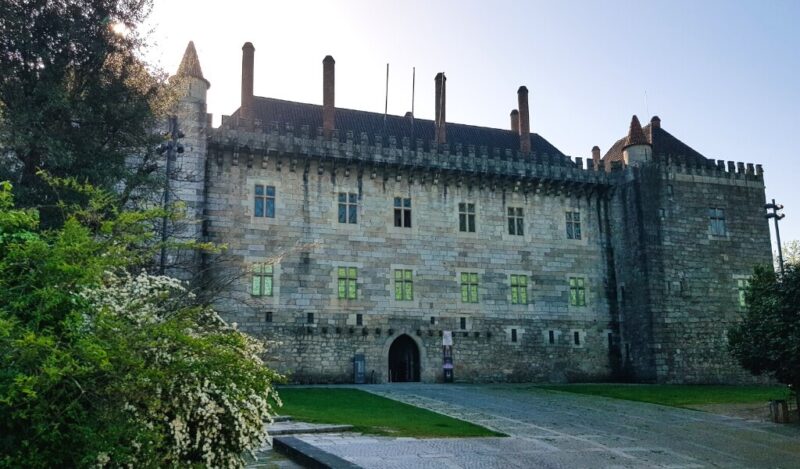
Palace Of The Dukes Of Braganza: Best Tips For Visiting In 2024

World Heritage In Castile And León (2024)

Machado De Castro National Museum: Best Tips For Visiting In 2024
What photography gear do i use.
- Camera Body: Fujifilm X-T4 Mirrorless
- Camera Lens: Fujinon XF 18-55 mm F2.8-4 R LM OIS
- Tripod: Manfrotto Compact Action
- Small Tripod: Manfrotto PIXI Mini
- Smartphone Adaptor: Manfrotto PIXI Clamp
- Memory Card: SanDisk 128GB Extreme PRO SDXC
Leave a Comment Cancel Reply
Your email address will not be published. Required fields are marked *
This site uses Akismet to reduce spam. Learn how your comment data is processed .
Privacy Overview

Monastery of Batalha UNESCO World Heritage
D. João, the Master of Avis and the future King of Portugal, defeated the Castilian army at the Battle of Aljubarrota. This victory brought an end to a dynastic crisis that had dragged on since 1383, when the King D. Fernando had died. His only daughter was married to the King of Castile, who laid claim to the throne of Portugal.
D. João dedicated the monastery to the Virgin Mary, whom he had called upon to beseech God to grant him victory. He gave the monastery to the Dominican Order, to which his confessor belonged. This was the beginning of a project whose construction work would last for almost two centuries and resulted in one of the most fascinating Gothic monuments in the Iberian Peninsula. Its great architectural value and historical significance led to the building being classified as World Heritage in 1983.
A visit to the monastery’s interior is, of course, mandatory, but, if possible, do not miss the great spectacle of the monastery’s night-time illumination, which greatly enhances its exuberant beauty and gives the carefully carved stonework a look of genuine magnificence that you will never forget.
Opening hours Everyday from 09:00 to 18:30 (last entrance at 18:00)
You might also like

Visit Batalha Monastery and surroundings | Tickets, photos, things to do
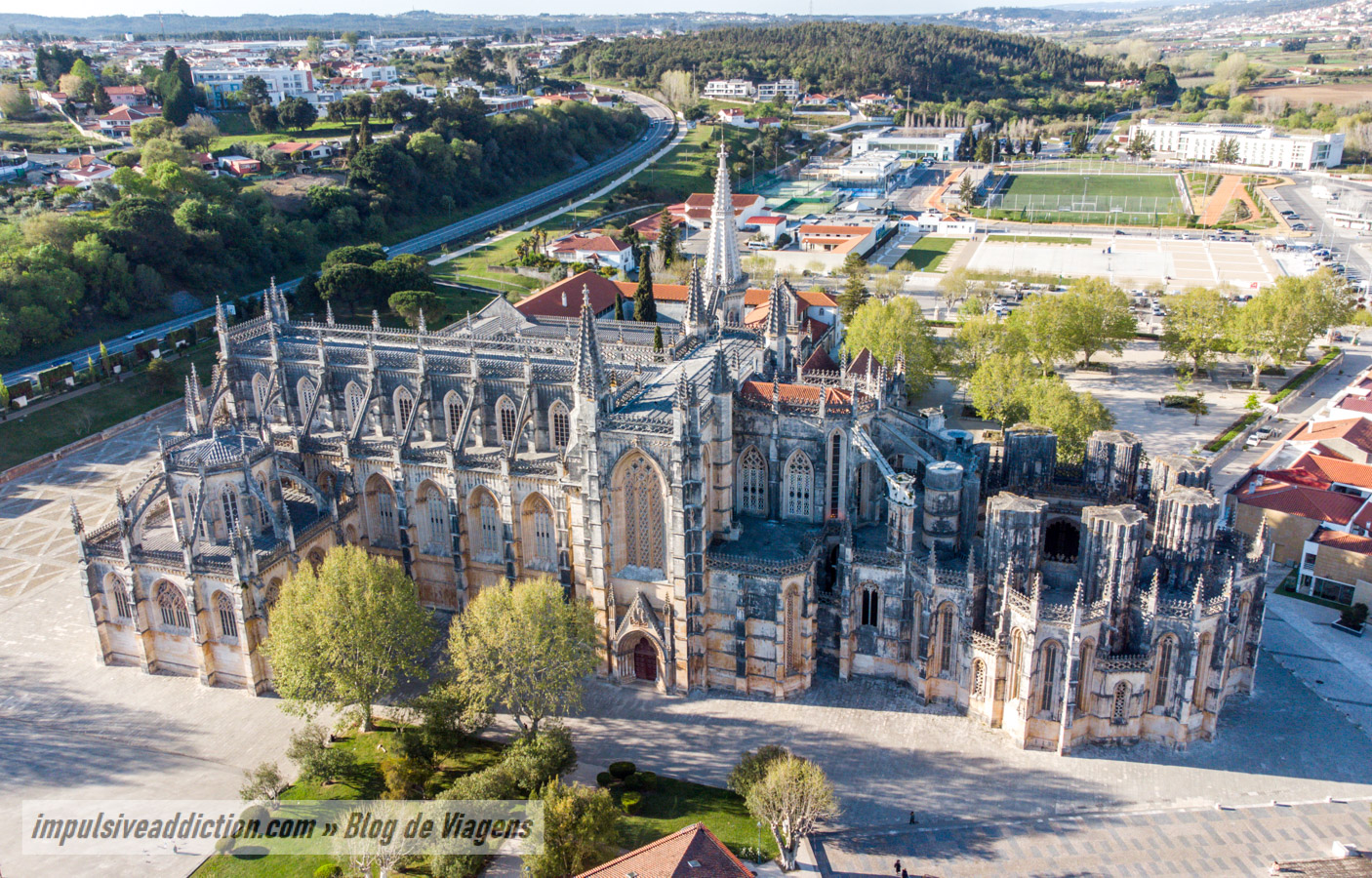
- August 23, 2023
Share this content!
Batalha has much more to visit than the Monastery, classified as a wonder of Portugal and a UNESCO World Heritage Site. The Monastery of Batalha may be the main invitation to visit the municipality, but you should also explore the surrounding area, visiting the tourist village of Pia do Urso, Reguengo do Fetal, or even the Coin caves.
To visit Batalha is to get to know a territory very close to the entrance to the extraordinary Natural Park of Serras de Aire and Candeeiros, so you’ll find some fabulous nature walks here.
Batalha is also very close to Leiria, Fátima and even the Portuguese coast, allowing you to connect with other interesting routes in central Portugal.
Have you been to Batalha? Did you know that one of the most important battles in Portuguese history, the Battle of Aljubarrota, took place here?
In this article there will be no shortage of tips for visiting the Monastery of Batalha. However, you’ll also find plenty of tips for visiting its excellent surroundings. Keep reading!
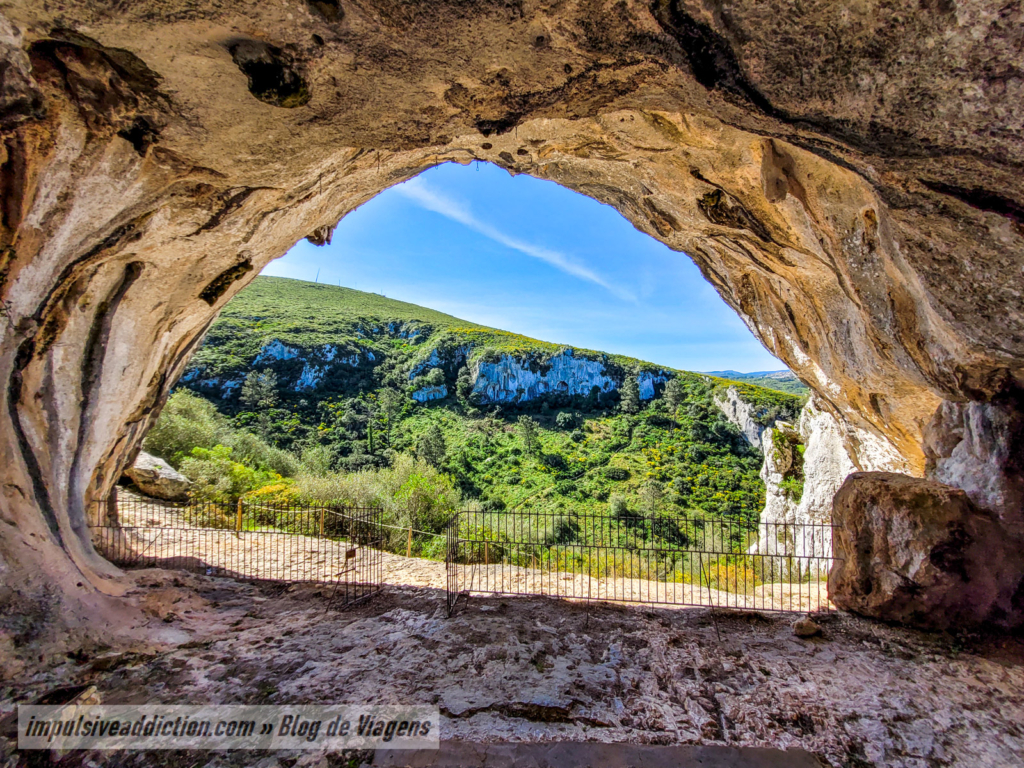
Article Content
Where is Batalha located, in Portugal?
Batalha is part of the district of Leiria, bordering the municipality of Leiria itself, as well as Ourém, Alcanena and Porto de Mós. It is very close to Fátima, which is very popular in Portugal for its sanctuary and devotion to Nossa Senhora.
Batalha may not be a municipality on the Portuguese coast, but it’s also very close to it, with Marinha Grande, Alcobaça and Nazaré so close by.
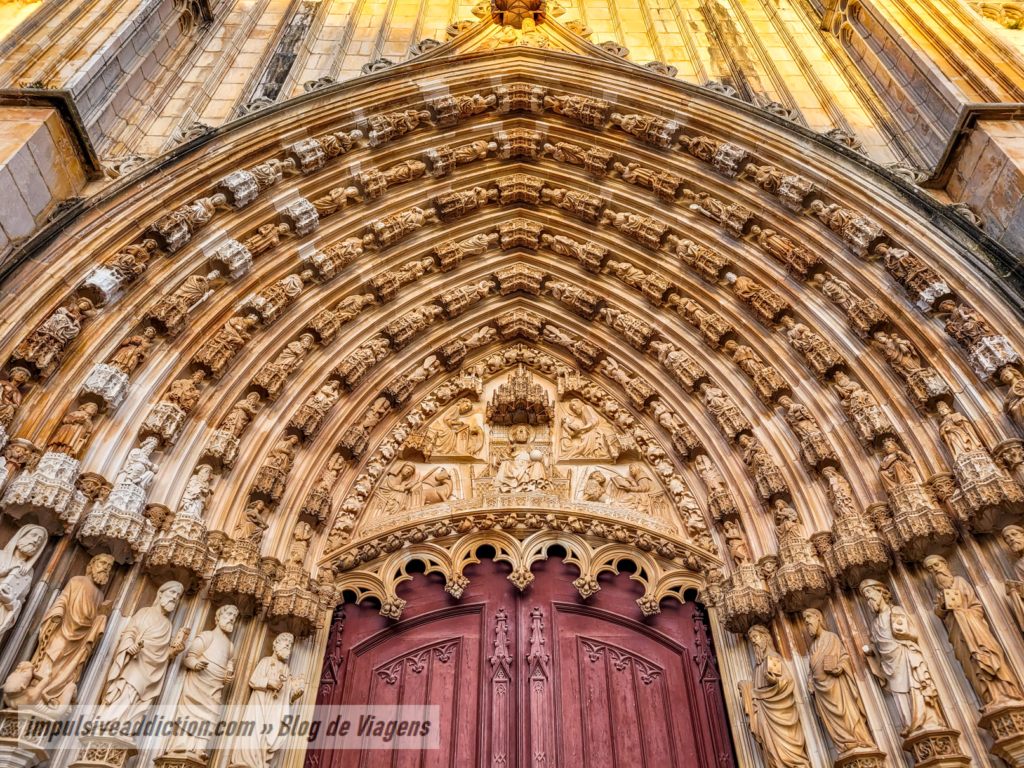
When to visit Batalha?
Batalha can be visited at any time of year, without exception. When hiking, you should of course avoid rainy or wetter periods, mainly for safety reasons.
In terms of annual festivities, take into account the following:
- The Festivities of Nossa Senhora do Fetal (or Procession of the Snails ): undoubtedly the most original of Batalha’s festivals, held in Reguengo do Fetal at the end of September and beginning of October. The image of the Saint is transported from the Parish Church to the Chapel of Senhora do Fetal in one week, returning eight days later. These processions are illuminated by thousands of snail shells, which makes them unique in the country.
- The 19th century market , also at the end of September, on a Sunday.
- FIABA – Batalha’s Crafts and Gastronomy Fair , at the end of May.
- Batalha’s main festivities , in the middle of August.
Travel Insurance + Car Rental
Having a car is a must for your itinerary in Central Portugal, especially if you want to visit many places from Lisbon to Porto. If you don’t have a car, rent one with Discover Cars , which allows you to analyze and compare prices between different rental companies until you find the best deal.
Likewise, travel insurance should be taken out without fail. We are all subject to bad luck and travel accidents. 😐 Opt for Travel insurance with World Nomads and be safe!
Gastronomy and Restaurants in Batalha
As far as the region’s gastronomy is concerned, here are some of the delicacies you shouldn’t ignore when visiting Batalha:
- Morcelas de Arroz .
- Tibornadas de Bacalhau .
- And Cavacas de Reguengo do Fetal , for dessert.
Reguengo do Fetal is, as you can see, one of the major centers of the municipality, where some of Batalha’s most ancient traditions come from, including its gastronomy.
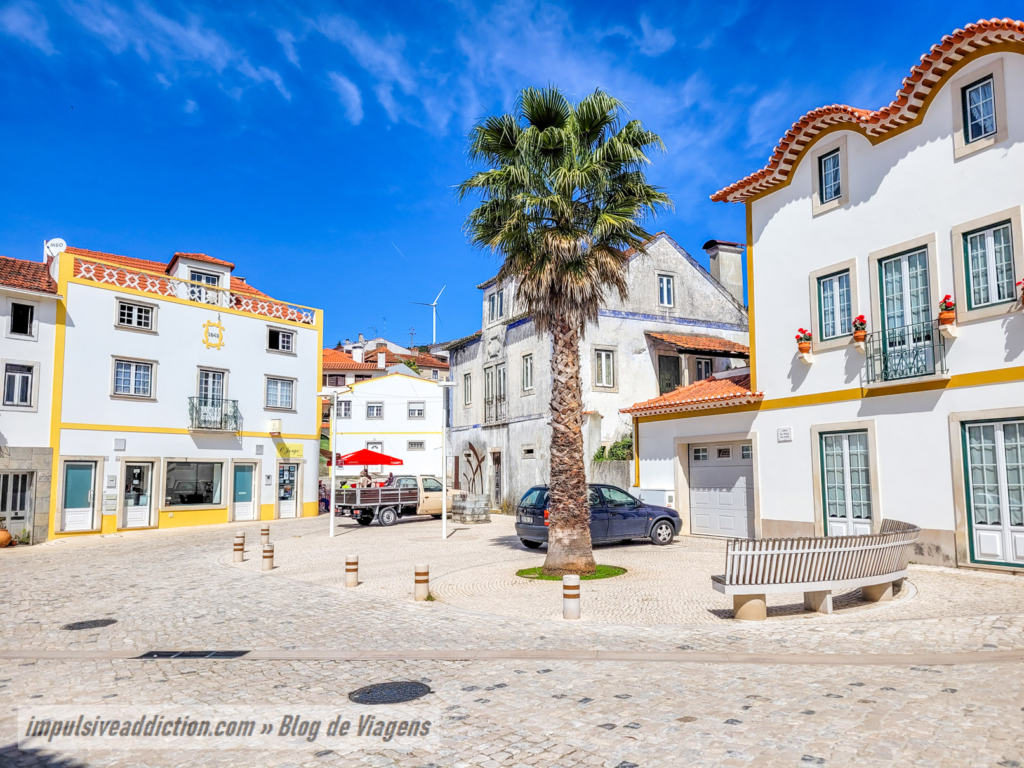
As for restaurants, try the following (but there are others!):
- Burro Velho Restaurant , right in the center of town.
- Mosteiro do Leitão , on the outskirts of the town.
- Restaurant Pérola do Fetal , in Reguengo do Fetal.
- Restaurant Piadussa , in Pia do Urso (São Mamede).
Accommodation tips to visit Batalha
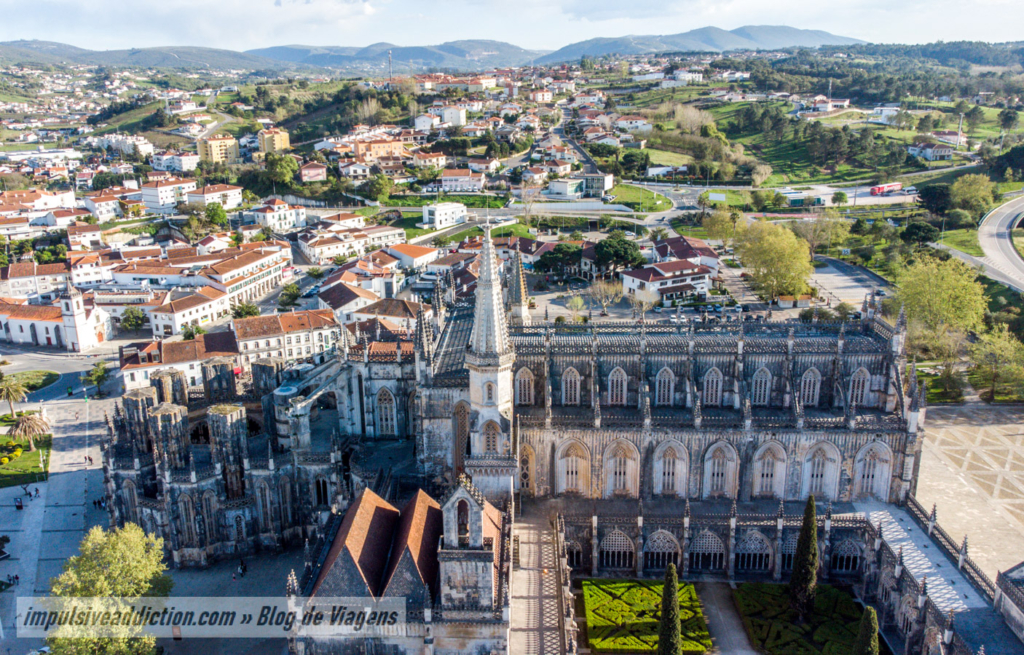
Things to do in Batalha | Portugal
Finally, I’ll tell you what to do, see and visit in Batalha. I’ll start with the historic center, where the grandiose Batalha Monastery is located, and then I’ll introduce you to the surrounding area, namely Reguengos de Fetal and São Mamede. Before that, here’s a map with all the sights I’m going to mention in this article.
Map | Things to do in Batalha
Visit the historic center of Batalha
The historic center of Batalha is home to the Monastery but not only. There are also beautiful gardens, a beautiful parish church and even urban art.
1. Batalha Monastery
The Monastery of Batalha is also called the Monastery of Santa Maria da Vitória, and was built at the request of King João I as payment for a promise to Our Lady, in thanks for the victory in the Battle of Aljubarrota (1385).
The Monastery was built in several phases, resulting in a monastic complex that currently has a church, two cloisters, the Founder’s Chapel and the Imperfect Chapels.
It belonged to the order of St. Dominic until the expulsion of the religious orders, and today it is owned by the Directorate General for Cultural Heritage. It is a national monument, one of the 7 wonders of Portugal and has been on UNESCO’s World Heritage List since 1983. It is considered by many to be the most beautiful and impressive monastery in Portugal.
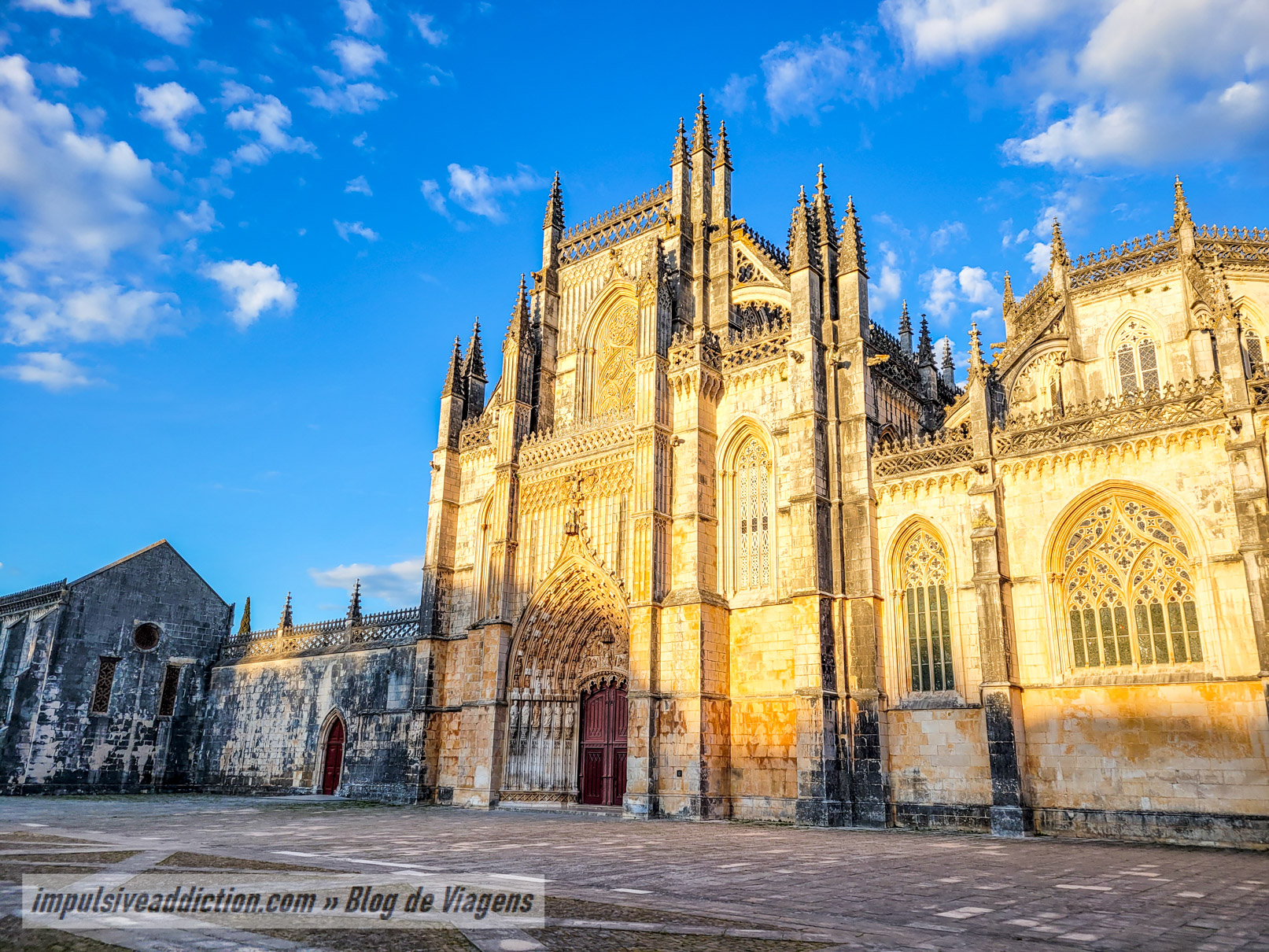
Batalha Monastery Main Portal
The Main Portal is one of the most magnificent works in Batalha Monastery, full of details to discover.
- The figures of the apostles (six on each side) stand out.
- Above the Apostles, the first two archivolts show virgins, martyrs, popes, bishops, deacons and monks.
- In the next two archivolts are the kings of Judah.
- In the two innermost archivolts are angels and seraphim.
- And on the tympanum appears the figure of God, seated on a throne, with the four evangelists around him (St. John, St. Mark, St. Luke and St. Matthew).
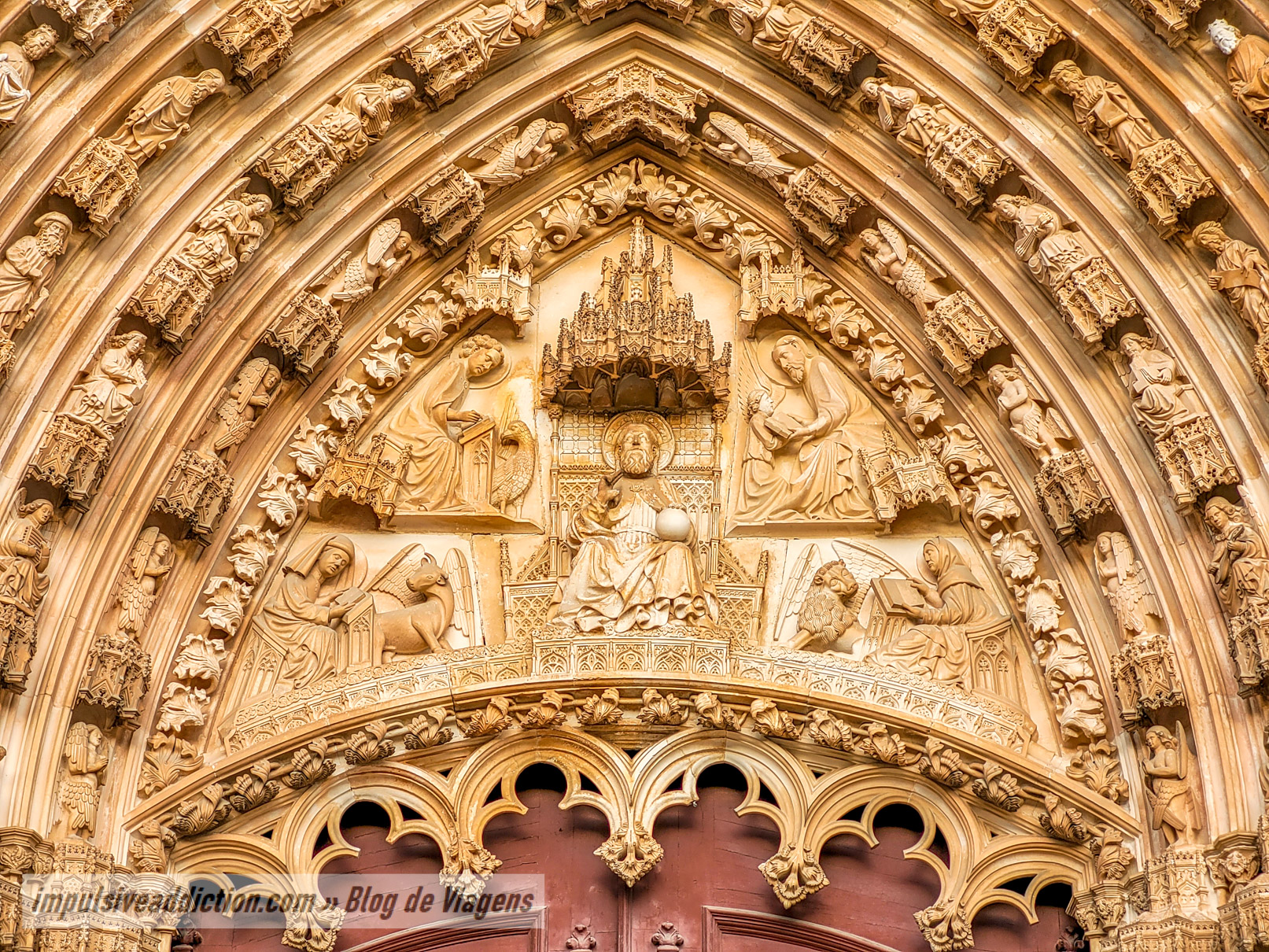
The Chapel of the Founder of the Monastery of Batalha
The Founder’s Chapel arose from King João I’s need to create a pantheon for the royal family. The enormous tomb ark in the center, where he and his wife, D. Filipa de Lencastre, rest, is undoubtedly a highlight. On the sides of the chapel are the tombs of his sons, namely Infante D. Pedro, D. Henrique, Infante D. João and D. Fernando.
From the 20th century, the three tombs commissioned by King Carlos I stand out:
- The tomb of King Afonso V, grandson of King João I.
- The tomb of King João II, son of King Afonso V.
- There is also the tomb of Prince D. Afonso, son of King João II.
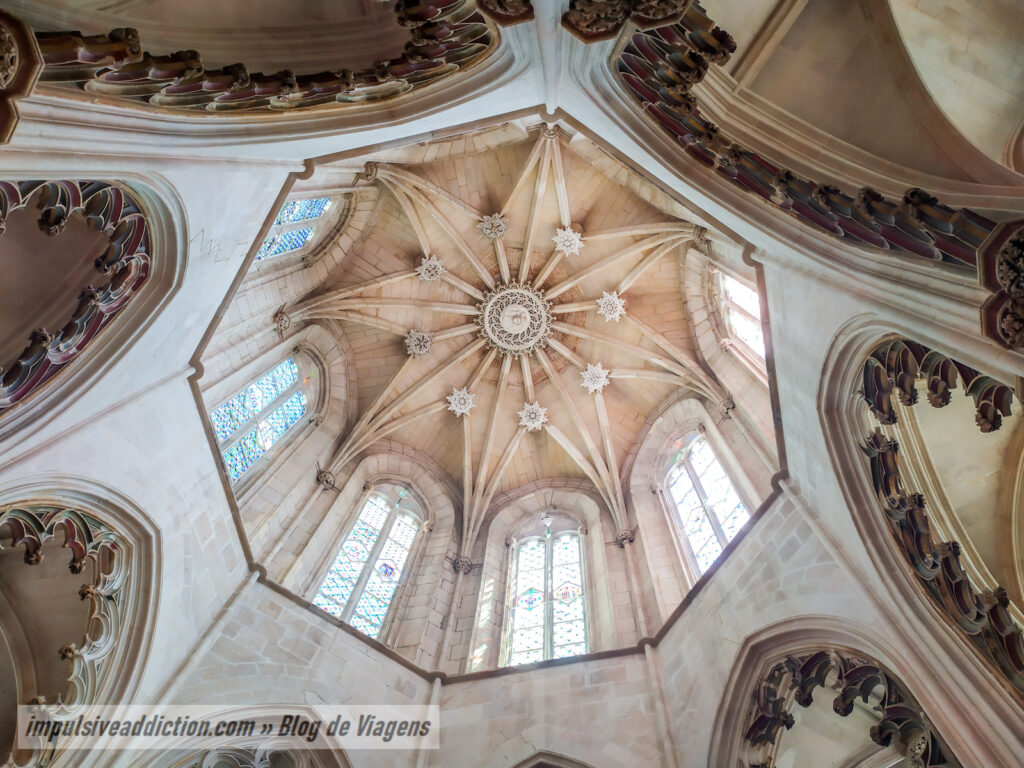
The Church of the Monastery of Batalha
The Church of the Monastery of Batalha is gigantic, about 80 meters long, 22 meters wide and almost 33 meters high. It is organized into three naves and its stained glass windows, some of which are very old, stand out.
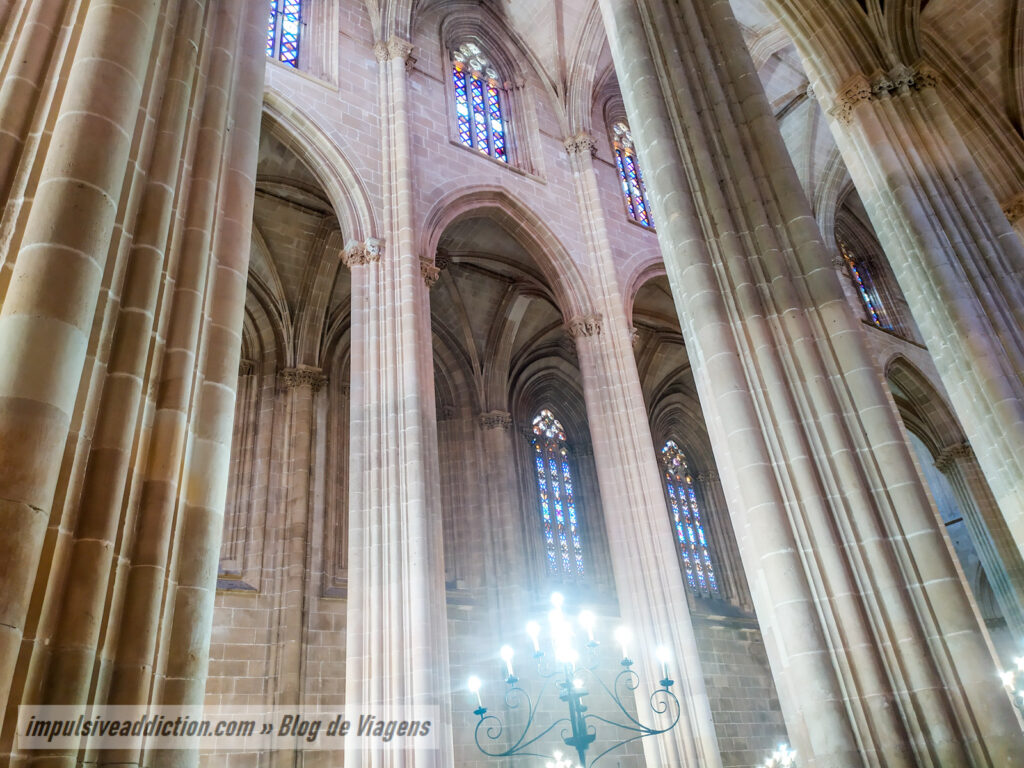
Cloisters of the Monastery of Batalha and Chapter House
As far as the cloisters are concerned, two of them from the 16th century no longer exist. The ones that remain contrast greatly with each other, as one is quite simple (Cloister of King Afonso V) while the other is brutally decorated and full of details (Royal Cloister).
I have no doubt that the latter will impress you, as will the Chapter House, in one of its galleries, where those killed in action during the First World War are honored. Here rest the remains of two soldiers who were never recognized.
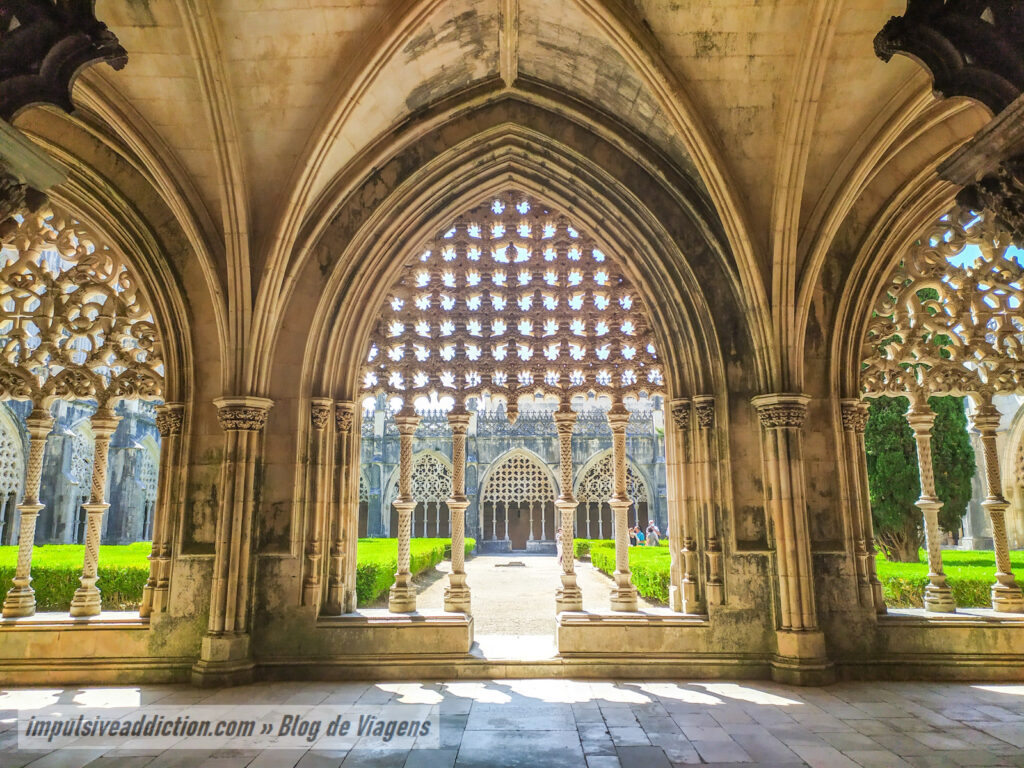
Imperfect Chapels of the Monastery of Batalha
The Imperfect Chapels have this name because they are unfinished. Their construction began in the 15th century, during the reign of King Duarte, with the aim of becoming a royal pantheon, just like the Founder’s Chapel. Future kings continued the construction, as in the case of King Manuel, during whose reign the magnificent Manueline portal was built.
The chapels were never completed, but the tomb of King Duarte and Queen Leonor was moved here in the 1940s, as was originally intended.
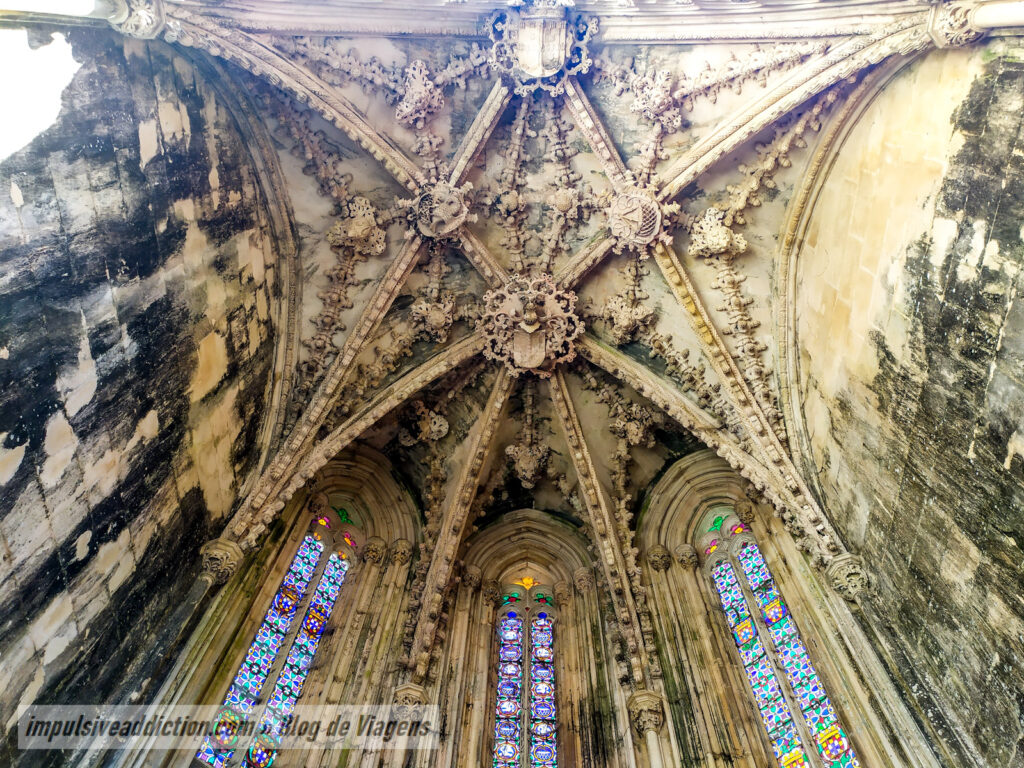
2. Equestrian statue of the Constable D. Nuno Álvares Pereira
In the main square of the Monastery of Batalha, it’s impossible to ignore the huge equestrian statue of D. Nuno Álvares Pereira, hero and strategist of the Battle of Aljubarrota. It dates from the 20th century and was completed in 1968. The Constable was canonized by Pope Benedict XVI in 2009.
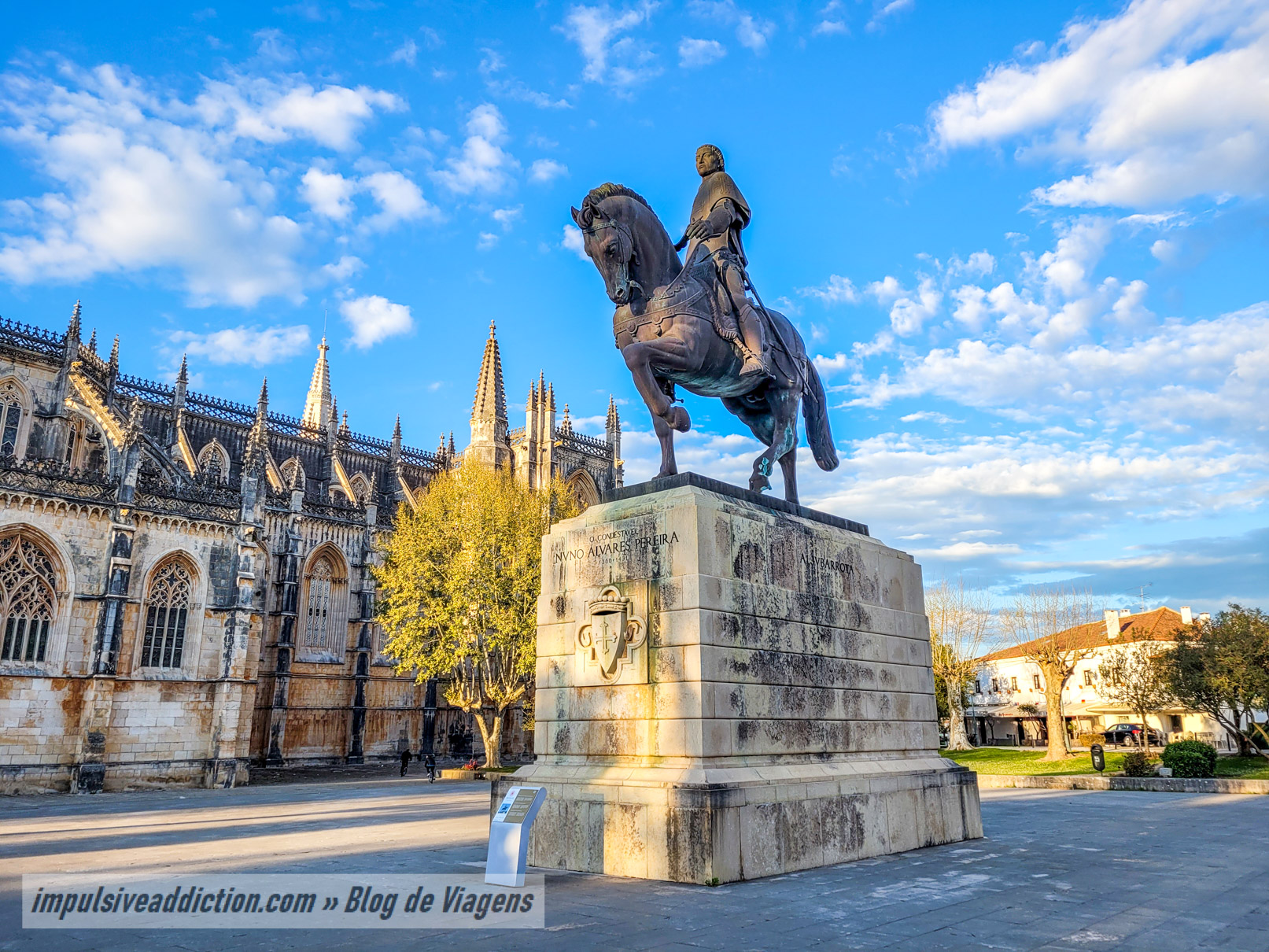
3. Letters “Batalha”
Go around the Monastery of Batalha to the Letters “Batalha”, for a typical photo with the monastery in the background. And I can’t help but draw your attention to the various squares around the Monastery, and even the gardens:
- Vitória Square
- Square D. João I
- The Garden of the Constable
- Mouzinho Albuquerque Square
- And Square Infante D. Henrique
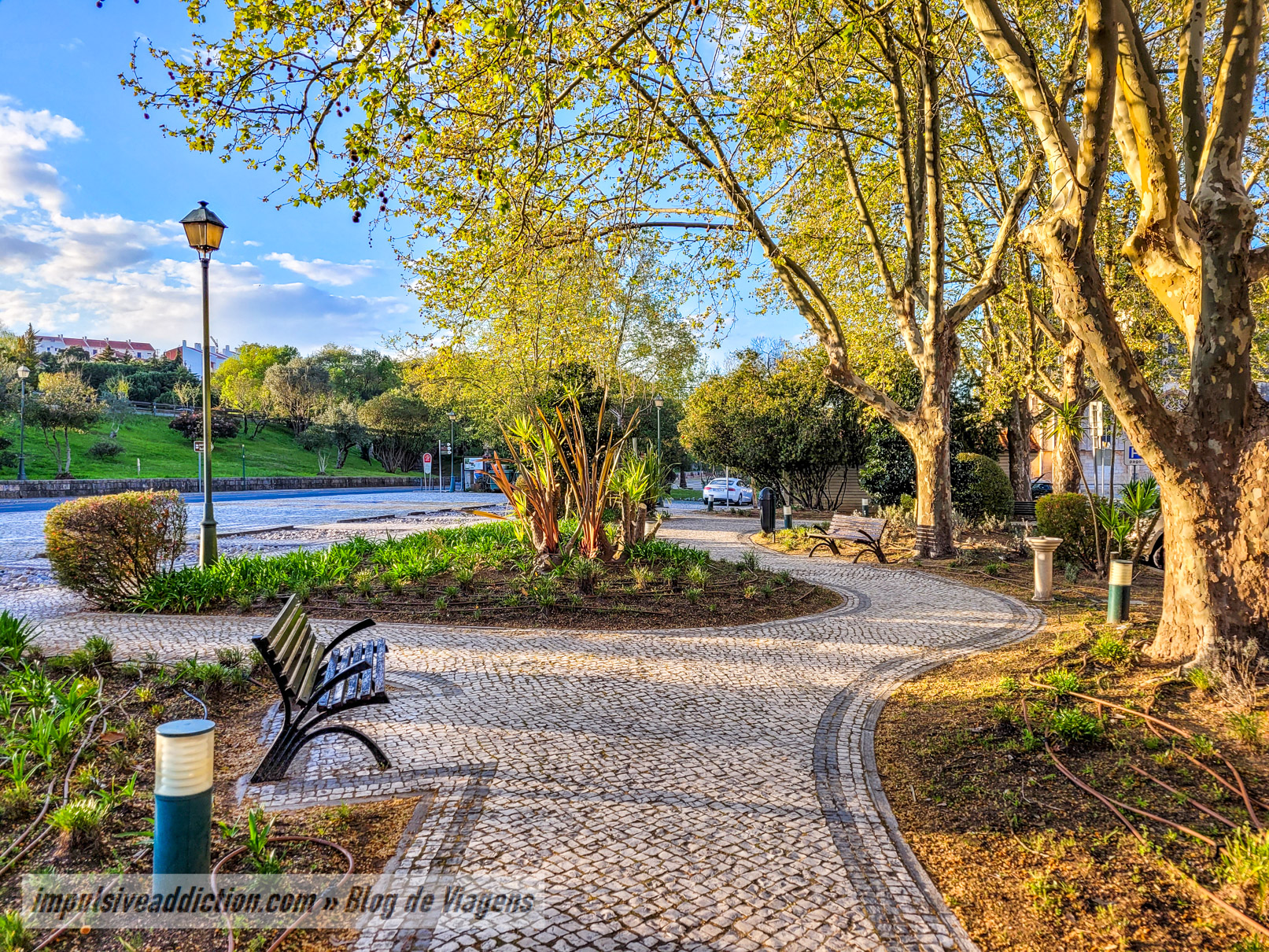
4. Chapel of Nossa Senhora do Caminho
The Chapel of Nossa Senhora do Caminho used to be attached to the conventual fence of the Monastery of Batalha, which no longer exists today. If you examine the chapel carefully, you’ll still see traces of the walls of that fence.
It is believed that the chapel dates back to the 17th century, when it was built in dedication to Our Lady of Consolation. It is said that it was erected because a particular image of Our Lady insisted on disappearing from the original site to the place where the chapel stands today.
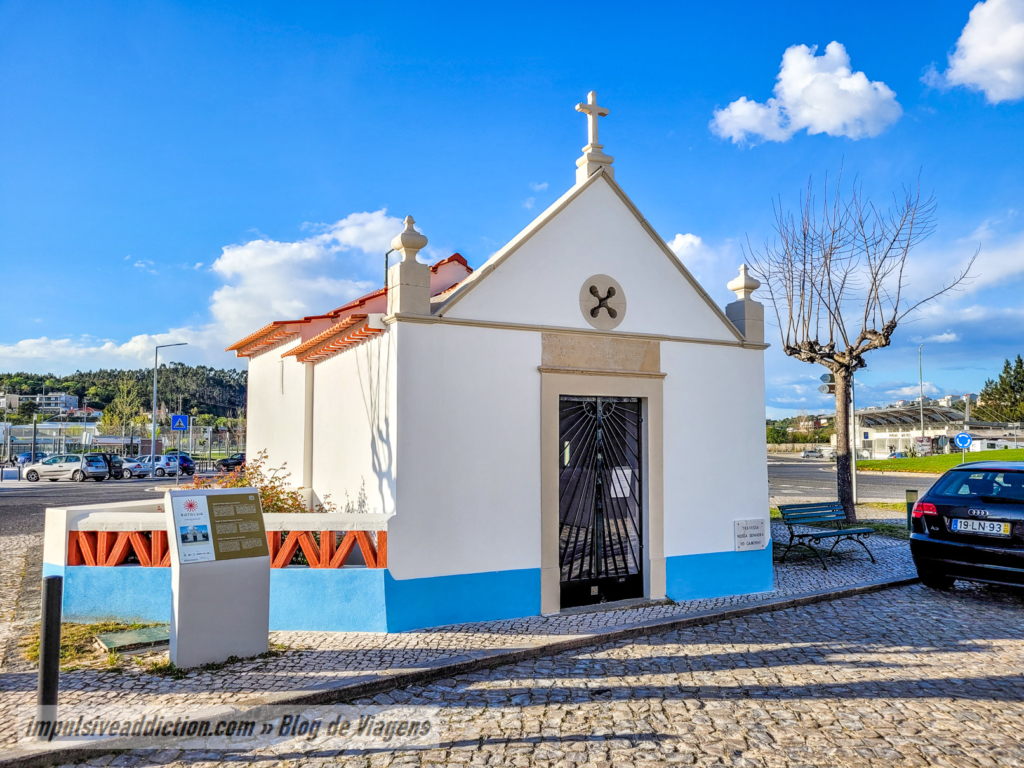
5. Gardens close to river Lena
The most beautiful gardens in the town of Batalha are next to River Lena, which a few kilometers further on flows into River Lis in Leiria. On one side of the river you have the Garden of Lena and on the other the Infantes Garden. Be sure to take a stroll there, crossing the bridges over the river.
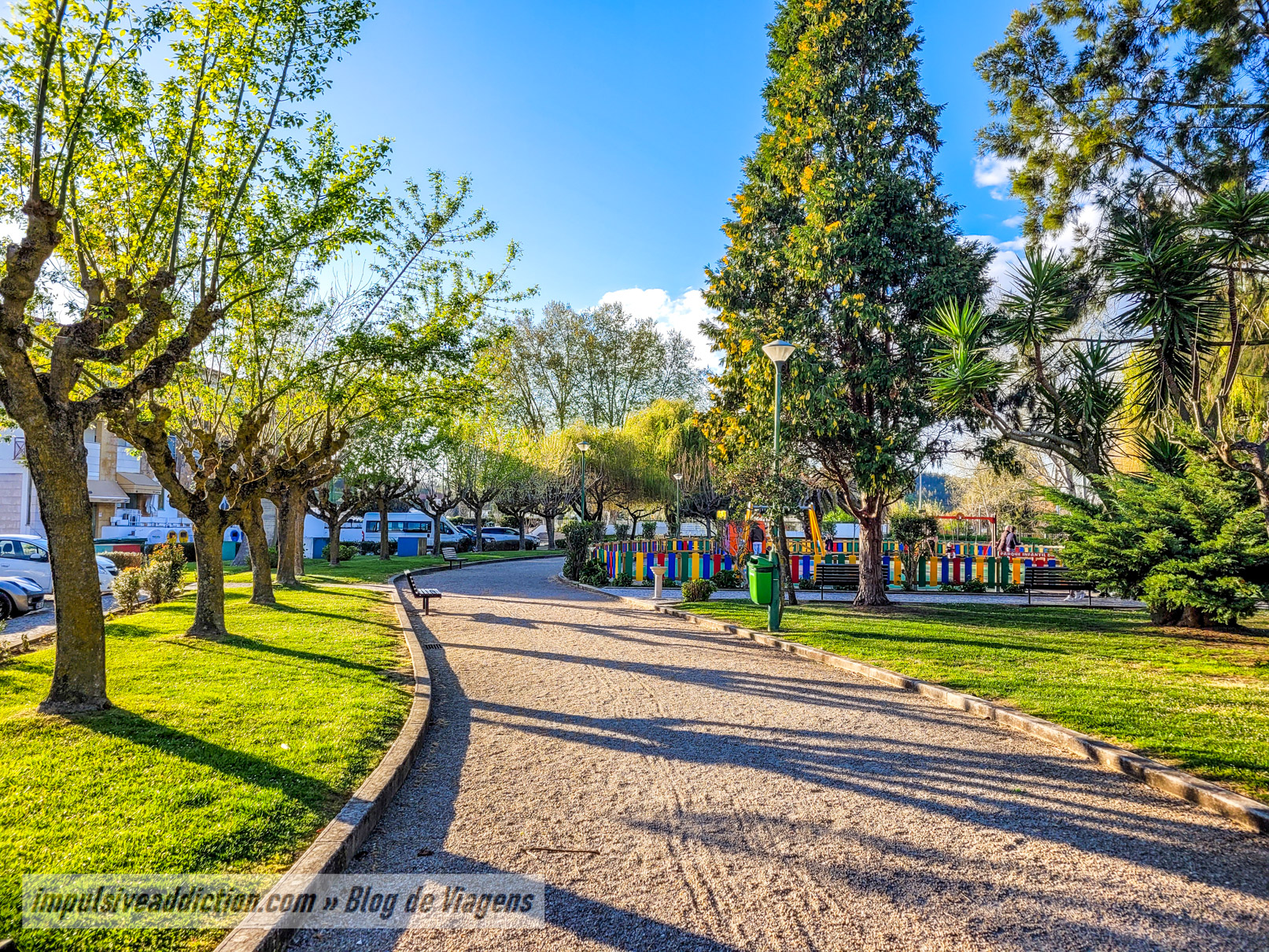
6. Pillory of Batalha
On your way to the pillory, you will pass Batalha Town Hall and the Auditorium. The Pillory is noteworthy for its elegant features and is a reminder of the charter granted to the town by King Manuel in 1500.
The pillory you see today is just a replica of the original, as it was vandalized and destroyed during the 19th century. It was originally located in front of the Imperfect Chapels of Batalha Monastery.
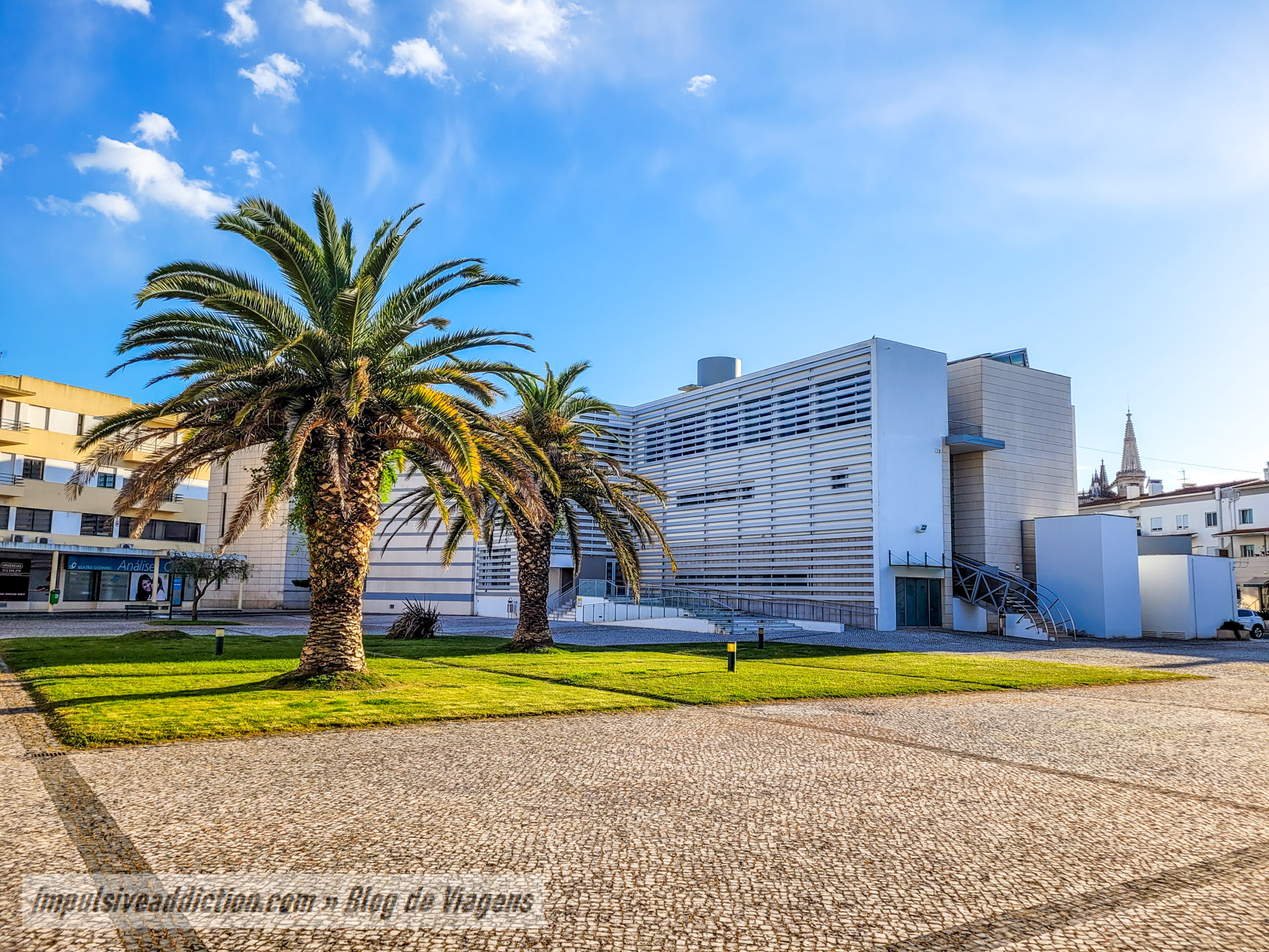
7. Mother Church of Batalha
The Mother Church of Batalha is also known as the Church of the Exaltation of the Holy Cross and was built in the 16th century on the initiative of King Manuel. Its beautiful Manueline portal undoubtedly stands out.
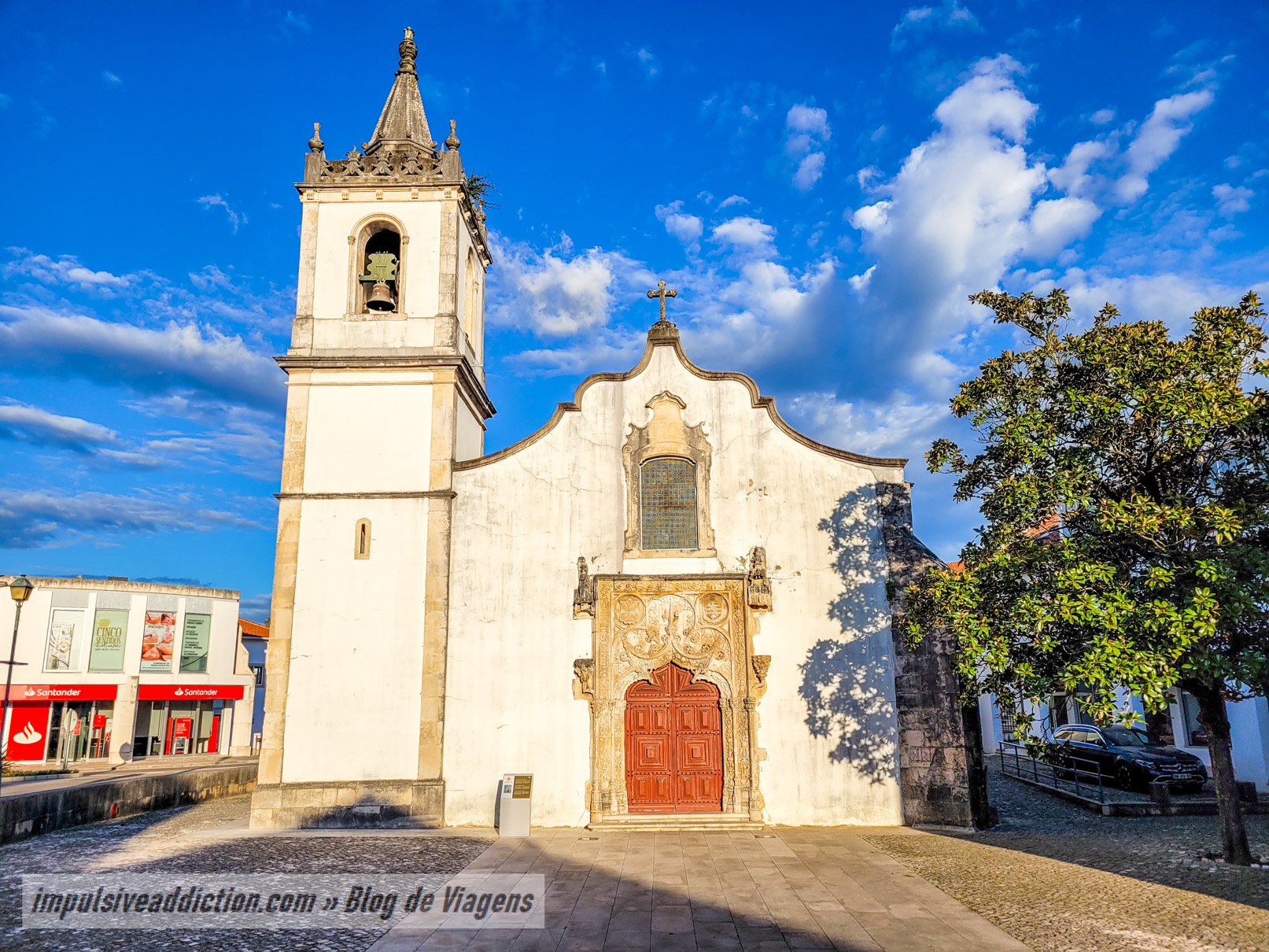
8. Batalha County Community Museum
Batalha Museum has exhibitions related to the region’s past, present and future. Of course, the great past stands out, and in the museum you can learn not only about the Battle of Aljubarrota and the construction phases of the Monastery, but also about what preceded it all, from several million years ago to the Paleolithic and Roman occupation of the Iberian Peninsula. You’ll find an interesting archaeological collection there.
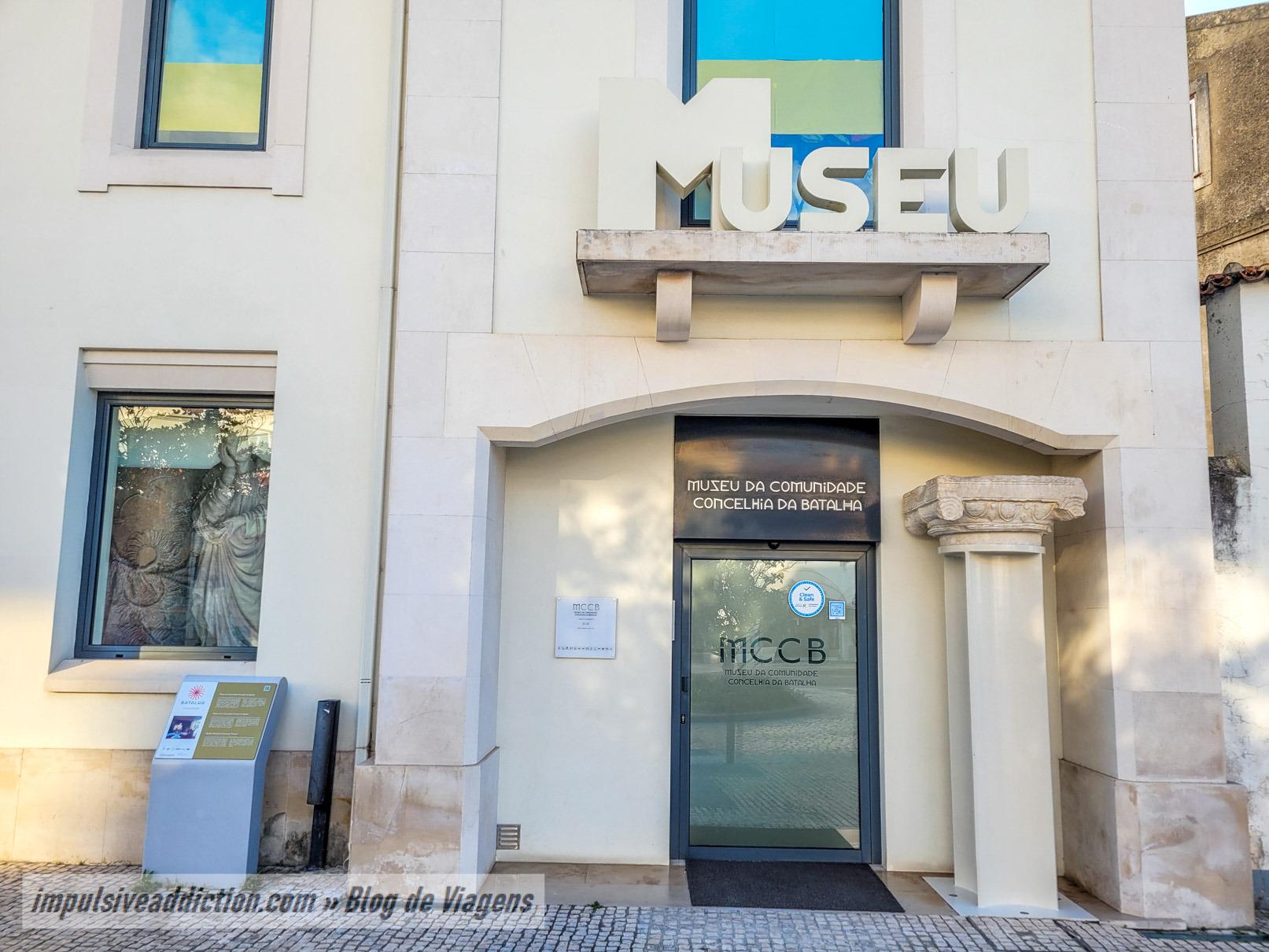
9. Tunnel “Remembering the Battle of Aljubarrota”
Don’t miss the tunnel “Remembering the Battle of Aljubarrota”, where murals depicting the main personalities of the time have been added.
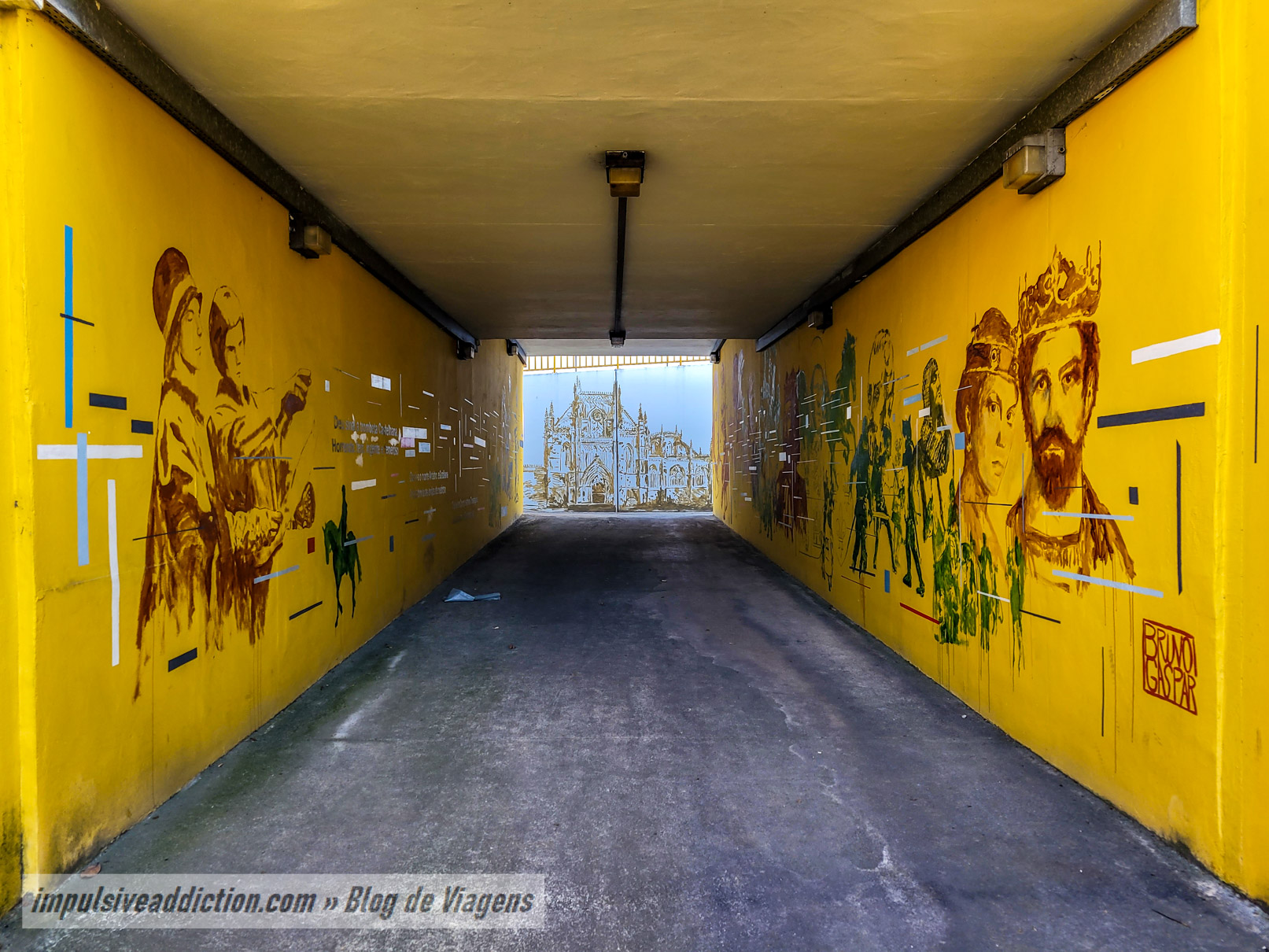
10. Boutaca bridge and Quinta do Fidalgo
On the outskirts of the town, but very close by and even accessible on foot, is the Boutaca bridge. It’s a 19th century viaduct in neo-Gothic style, which is why I’m mentioning it in this article. Nearby is the also beautiful Quinta do Fidalgo.
11. Interpretation Center of the Battle of Aljubarrota
Finally, I would like to highlight the Interpretation Center of the Battle of Aljubarrota , which is also located on the outskirts of the historic center, in the exact place where the battle once took place.
- You’ll have access to informative exhibitions about the Battle of Aljubarrota and the events that led to it.
- You’ll have access to aerial comparisons of the region’s past and present.
- You’ll be able to watch an awesome 30-minute movie about the battle, featuring well-known portuguese TV actors.
- And you’ll also have the chance to walk around the Battlefield itself, knowing where the armies were positioned.
Optionally, don’t miss the Interpretation Center of the 1st Position of the Battle of Aljubarrota, located where D. Nuno Álvares Pereira initially waited for the Castilian army, before moving on to the real battlefield.
The Battle of Aljubarrota took place in August 1385, with Portugal emerging victorious against Castile, despite being outnumbered. It was a real battle for Portugal’s independence, through which King João I managed to keep his throne. I won’t give you any more details, as I really recommend that you visit the center and watch the film that explains all the politics and strategy surrounding the battle very clearly.
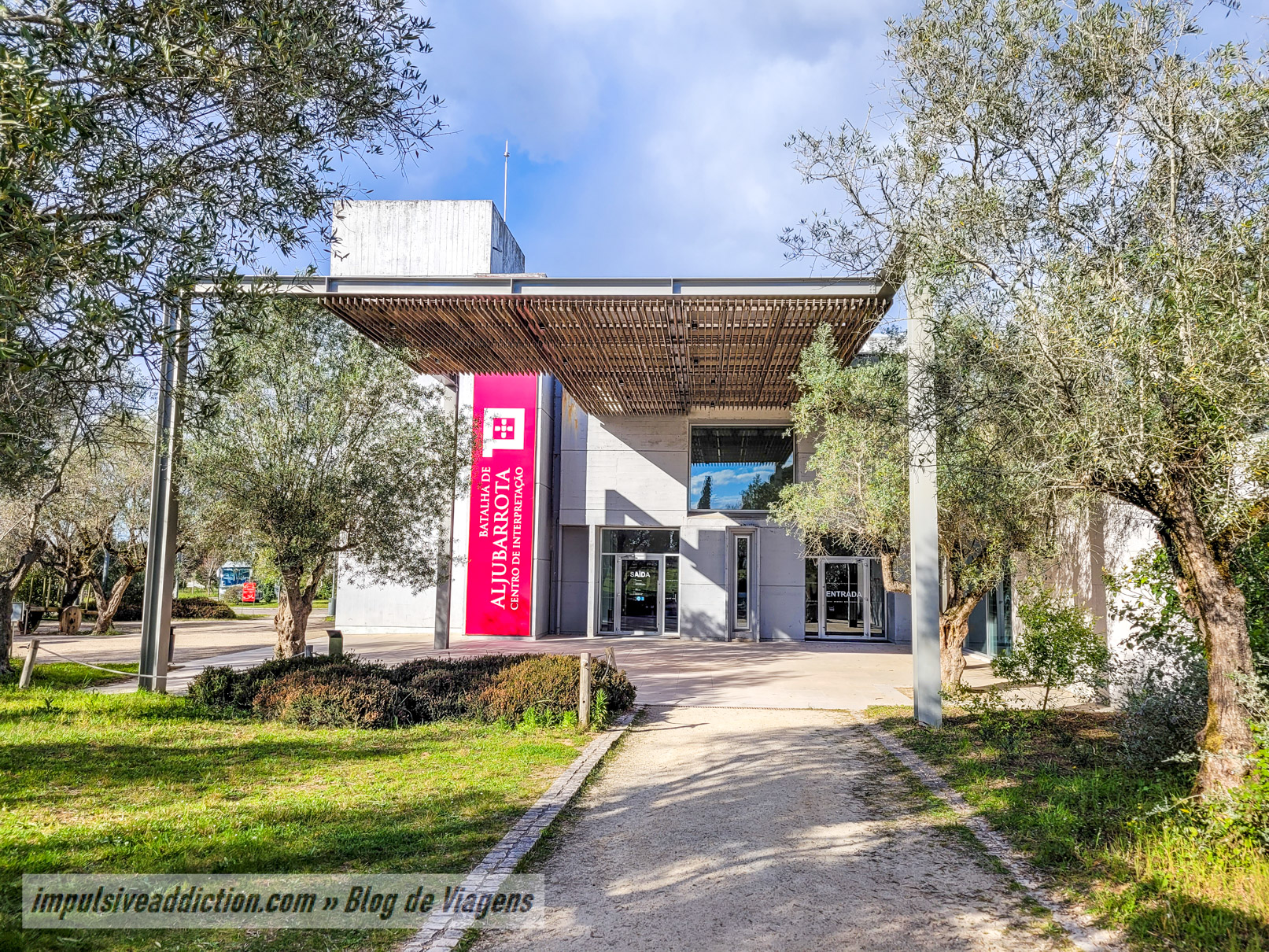
Visit Reguengo do Fetal
Reguengo do Fetal will surprise you with a fabulous viewpoint and swing, as well as a cool trail full of grottos to discover.
1. Buraco Roto Trail
Buraco Roto Trail is circular, about 8km long, and starts right in the center of the village of Reguengo do Fetal, near the Parish Church of Nossa Senhora dos Remédios. The main highlights are the grottos of Buraco Roto, Pia da Ovelha and Vale dos Ventos. Check it out in wikiloc .
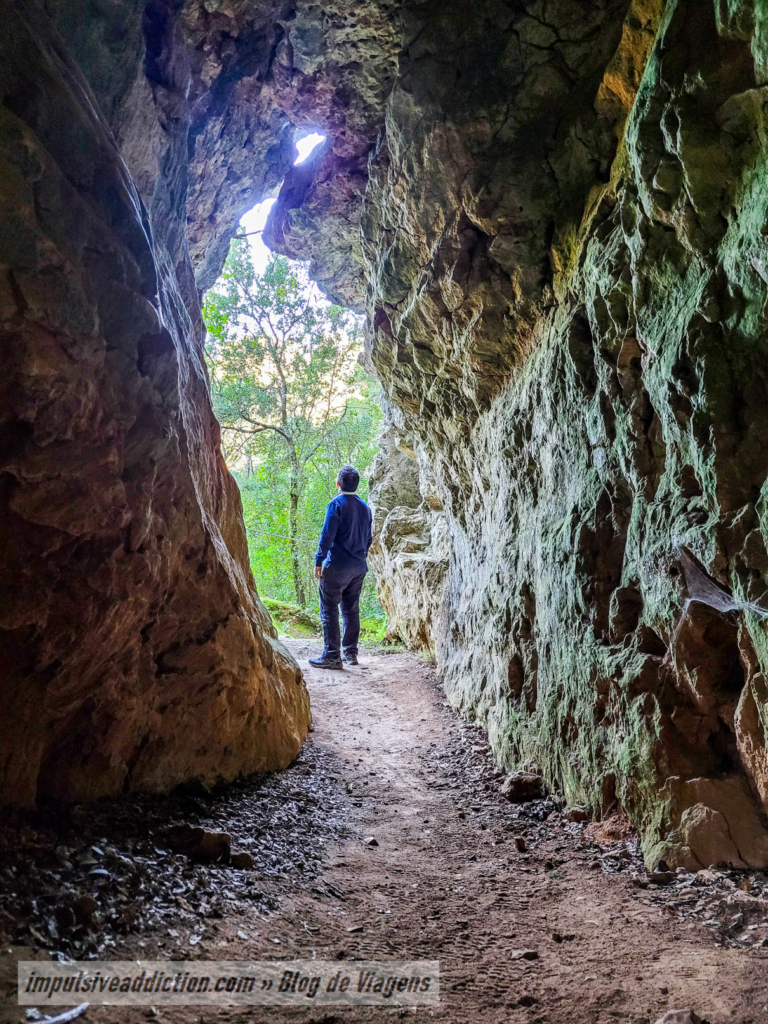
2. Swing of Torre Barrozinha
From this swing you’ll have an unobstructed view of the entire region that stretches from Reguengo do Fetal to Batalha.
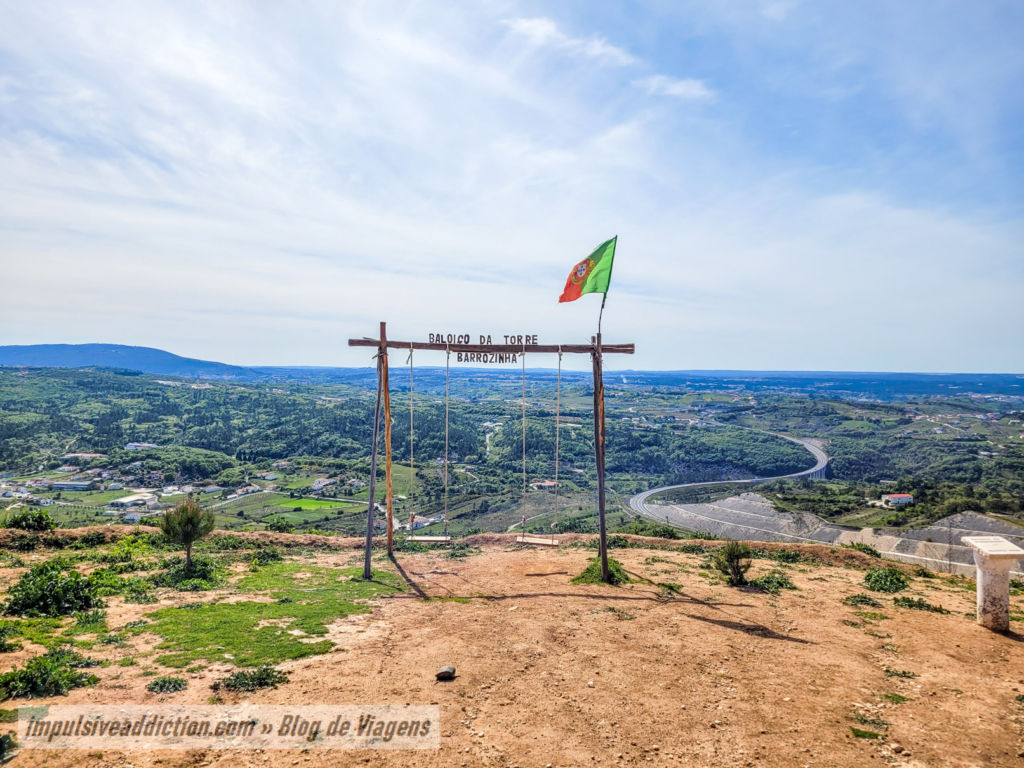
Visit São Mamede and Pia do Urso
In São Mamede you’ll have bigger caves to discover, typical of the region, and another fabulous trail to follow, full of windmills. 😉
1. Coin Caves
The Coin Caves are just 2km from Fátima and were discovered in 1971 by two hunters. Today they are 350 meters long, about 45 meters below the entrance level. Its limestone formations are fabulous, with numerous stalactites and stalagmites, for example.
I mention several other caves in my article dedicated to the best Caves of Serra de Aire. Check it for more detail information.
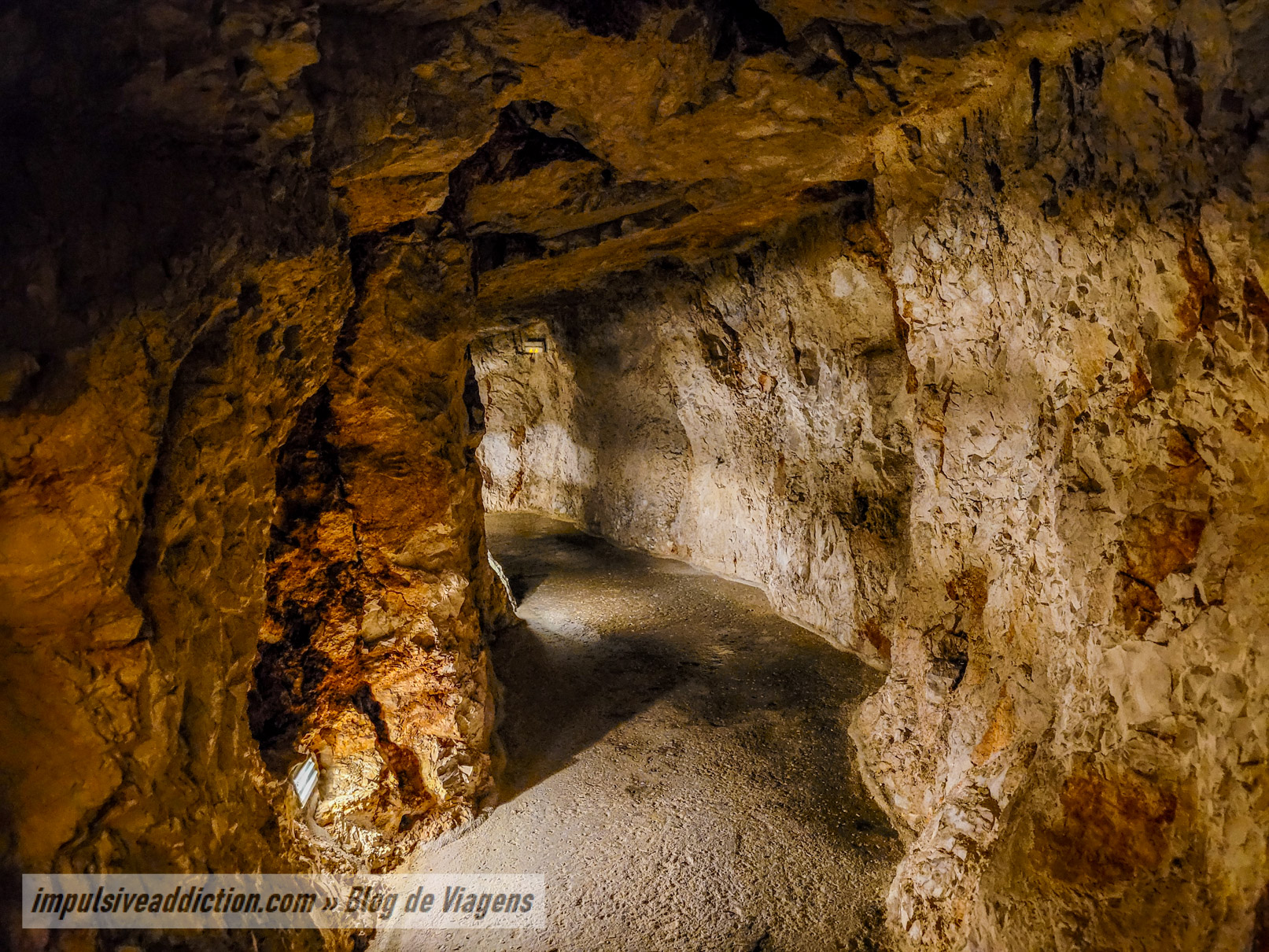
2. Mill Route and Pia do Urso Sensory Park
The Mill Route is a much easier trail than the previous one of Buraco Roto, and just as beautiful, with several restored mills, others in ruins, and even a tourist village on a par with those made of schist (in central Portugal). The trail begins and ends exactly in this village (Pia do Urso) and is about 7km long. Also noteworthy is the Pia do Urso Sensory Park, which is one of the final stages of the trail. Check the trail out on wikiloc .
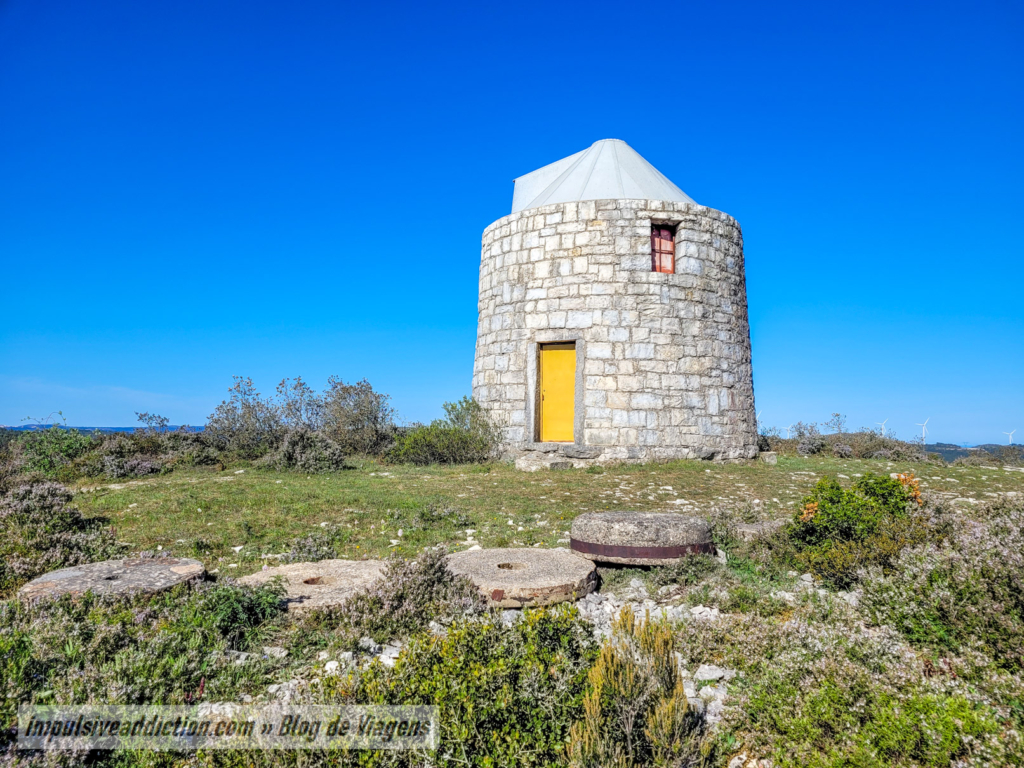
Other Itineraries and Travel Guides in Portugal
- N2 Portugal Road Trip Itinerary
- Madeira Itinerary and Travel Guide
- São Miguel Itinerary and Travel Guide (Azores)
- Terceira Itinerary and Travel Guide (Azores)
- Pico Itinerary in Azores
- Faial Itinerary in Azores
- Minho | Northern Portugal Itinerary
- Porto Itinerary and Travel Guide
- Things to do In Braga (Minho)
- Things to do in Guimarães (Minho)
- Things to do in Viana do Castelo (Minho)
- Peneda Gerês National Park Itinerary
- Douro Valley Itinerary
- Trás-os-Montes Itinerary
- Things to do in Bragança
- Montesinho Natural Park Itinerary
- Douro International Natural Park Itinerary
- Things to do in Aveiro
- Things to do in Coimbra
- Things to do in Leiria
- Things to do in Fatima
- Things to do in Nazaré
- Things to do in Peniche
- Things to do in Évora (Alentejo)
- Things to do in Beja (Alentejo)
- Algarve Road Trip Itinerary
- Things to do in Lagos (Algarve)
- Things to do in Portimão (Algarve)
- Things to do in Faro (Algarve)
- Things to do in Tavira (Algarve)
I hope you enjoyed this article about Batalha Monastery and surroundings. Have a nice stay in my country! 😉 Tell me about your travels in the comment section bellow.
Pedro Domingues
Leave a reply cancel reply.
Your email address will not be published. Required fields are marked *
Quero subscrever a newsletter!
Take A Walk Around Batalha Monastery
Explore and discover one of the best examples of architecture in portugal.
By Google Arts & Culture
Batalha Monastery commemorates the Portuguese victory over Castillans at the nearby Battle of Aljubarrota. It's Portugal's most important gothic building and one of the most significant in both the Iberian Peninsula and Europe. The building also gave birth to the Manueline style of architecture. The westport was one of the last parts to be finished and demonstrates the influence of the architect's early education in France. The tympanum, however, relies on Iberian tradition.
During the 50 years of construction, two different architects led the work. First there was the Portuguese Alfonso Domingues. He was followed by Huguet, who was almost certainly French. However the inner space is primarily the first architect's design and reflects the century old tradition of Gothic churches in Portugal. The only differences being the church's huge scale and the many vaults filling in space.
When the church was nearing its conclusion, King João I decided to have his family mausoleum built next to it. The Founder's Chapel designed by Huguet it's one of the very first flamboyant gothic buildings in the Iberian Peninsula, endowed with innovative and complex structural and decorative solutions.
The central star-shaped vault is a clear sign of the stay of the architect Huguet in the crown of Aragon and the kingdom of Navarre before reaching Batalha.
The Royal cloister was started by Afonso Domingues and it was finished by Huguet, who respected the first master's plans. During the reign of King Manuel I it was nobelated with exquisite carvings that filled the window base and counted among the earliest so called Manueline artworks.
The chapter house was started in the reign of João I but it was only finished in the time of his grandson Alfonso V. A legend tells that the vault fell twice with great detriment to its workers. A stained glass triptych depicting The Passion of Christ was installed in 1514.
Hand basin can be found near the refectory. We still use its original primitive water supply. Hand washing before meals was an important ritual, as well as serving the Fria's personal hygiene.
A new cloister was added to the monastery in the reign of Afonso V. It was built in a more sober style, that is shared by other royal and princely buildings at this period in Portugal.
Upstairs with the friar's and novice's cells, along with the library and archives, ground floor rooms included a ladder, a stock of the firewood, the olive oil store, the wine press, and workshops.
King Duarte, the son of the monasteries' founder, ordered his own funeral chapel to be built but died soon after. The building was continued by successors with many interruptions until was eventually abandoned in 1533 and left unfinished.
According to Mediterranean tradition, the roof is tear shaped. Take your own trip around the Royal cloister.
On the south side of the church, you can see flying buttresses, topped by gargoyles that throw rainwater from the highest roofs into the drainage system below.
Take a tour in the monastery
Batalha monastery, luminous altarpieces, batalha - in memory of a battle, at the gates of heaven.
Batalha Monastery: UNESCO World Heritage in Portugal
- Travel destinations
- Batalha , Center of Portugal , Europe , Leiria , Portugal
- Mónica Rodrigues Alves
- February 20, 2024
- No Comments

Article Index
The Batalha Monastery is a National Monument with the status of National Pantheon, located in the town of Batalha (Leiria district), in Central Portugal.
It was commissioned in 1386 by King Dom João I of Portugal, as a thanksgiving to the Virgin Mary for the victory in the Battle of Aljubarrota, but construction lasted nearly 200 years.
It is a magnificent example of Gothic architecture and Manueline style in Portuguese territory, and one of the most visited national monuments in Portugal.
Furthermore, this grand work of Portuguese Gothic is included in UNESCO’s World Heritage List and was elected in 2007 as one of the Seven Wonders of Portugal.
Do you think these reasons are enough to include the town of Batalha in your itinerary? Join me on this journey through the History of Portugal, as I believe you won’t regret it.

Visit the Batalha Monastery

First of all, it is important to keep in mind that what we call the Batalha Monastery is actually a monastic complex consisting of a church, the Unfinished Chapels, and two cloisters.
It is located on the left bank of the Lena River and is indeed a vast complex with several points of interest accessible to visitors.
So, when visiting the monastery, make sure to carefully observe the most important features of the monument. And if you want to know what they are, here they are:
- The Gothic portal and the Manueline window;
- The Church;
- The Founder’s Chapel;
- The Chapter House, where the Tomb of the Unknown Soldier is located;
- The Royal Cloister;
- The Lavabo;
- The Old Refectory, where the Museum of Offerings or the Room of the Unknown Soldier is located;
- The Dormitory;
- D. Afonso V’s Cloister;
- The Manueline Door;
- The Unfinished Chapels;
- The Tomb of D. Duarte I and Leonora of Aragon;
- The equestrian statue of the Constable Nuno Alvares Pereira.
Fun fact: Did you know that the Batalha Monastery is also known as the Monastery of Santa Maria da Vitória?
Highlights at the Batalha Monastery: The Unfinished Chapels (Capelas Imperfeitas)

The Imperfect Chapels (Capelas Inperfeitas) are also known as the Dom Duarte Pantheon.
They are called “imperfect” because of the unfinished appearance of the site, as they lack a roof.
In other words, this project was not completed due to the death of King Dom Duarte in 1437 and the master Huguet, who was responsible for the work, in 1438.
However, the fact that they are incomplete does not diminish their heritage value, and a visit to the Imperfect Chapels is essential for an overall view of the Batalha Monastery.
Very importantly, right at the entrance, you will pass through an elaborate portal, which deserves your extra attention due to its detailed execution.
Also, take a look at the tomb of King Dom Duarte (1391-1438) and Queen D. Leonor of Aragon (1402-1445).
Highlights at Batalha Monastery: The Founder’s Chapel (Capela do Fundador)

The Founder’s Chapel is one of the places that attracts the most interest from monastery visitors.
After all, it is in the Founder’s Chapel that the mausoleum of King Dom João I and Queen Philippa of Lancaster is located.
Best Accommodation in Batalha

As you may have noticed, you’ll need a few days to leisurely explore the Batalha Monastery, as well as all the tourist attractions in the region.
Therefore, my hotel suggestion in Batalha is the Hotel Villa Batalha (4 stars), which not only boasts a spectacular location in the center but also features a very good SPA.
On the other hand, if you prefer the convenience of an apartment, the Mosteiro View , also in the center, can be a good option.
If you usually travel with your pet, then Monte do Mosteiro CountryHouse is the most suitable choice for you.
Finally, if none of these suggestions appeal to you, you can always explore other options below.
Hotels in Batalha, Portugal.
What to see near the Batalha Monastery?
Visiting the alcobaça monastery.

The city of Alcobaça is located just 20 km from Batalha, so it’s an excellent opportunity to visit both places.
Don’t forget to include on your list of what to do in Alcobaça, besides a visit to the monastery, a mandatory stop at Pastelaria Alcôa to taste the typical sweets.
Visit Leira

Leiria is situated around 14 km from Batalha, making it an ideal addition to your itinerary.
Begin your exploration by wandering through the historic center of Leiria, nestled along the banks of the Liz River, and culminate your journey at the splendid Leiria Castle.
Moreover, Leiria holds the title of Creative City of Music, ensuring a plethora of music-related events and activities year-round. Be sure not to miss out!
Explore the Natural Park of Serras de Aire and Candeeiros

The Natural Park of Serras de Aire e Candeeiros is located about 18 km from Batalha, making it an excellent destination to add to your trip.
My suggestion is to journey to the center of the earth at the Mira de Aire Caves, explore the historic dinosaur footprints at the Natural Monument of Dinosaur Footprints, or even dedicate a full day to exploring the mountain trails.
Everything You Need to Know Before Visiting the Monastery of Batalha

Price to visit the Monastery of Batalha
If you want to know how much it costs to enter the Monastery of Batalha, please take note that the regular ticket costs 10 EUR, but children up to 12 years old have free admission.
Also, the admission to the Monastery of Batalha is free on Sundays and holidays for residents of the national territory.
Who lies in the Founder’s Chapel of the Monastery of Batalha?
Well, those interred in the Founder’s Chapel are King Dom João I, Queen Philippa of Lancaster, and most of their children, whom the poet Camões dubbed the “illustrious generation.”
Why is it called the Monastery of Batalha?
Portuguese students learn in school that the Monastery of Batalha was commissioned in 1386 by King D. João I, as a thanksgiving to the Virgin Mary for the victory against the Castilian rivals.
This battle (Batalha in Portuguese) took place in Aljubarrota, hence it became known as the Battle of Aljubarrota.
Who were the architects and master builders of the Batalha Monastery?

Since the construction of this monastery took almost 200 years, there were several architects and master builders responsible.
So, according to records, the following are counted (from the oldest to the most recent): Afonso Domingues, David Huguet, Martim Vasques, Fernão d’Évora, Mateus Fernandes, João de Castilho, Miguel de Arruda, Mouzinho de Albuquerque, and Lucas dos Santos Pereira.
Where is the Batalha Monastery located?

The Batalha Monastery is located in the town of Batalha, which belongs to the district of Leiria, in the Central region of Portugal.
So, to get there, we suggest you take a look at the following maps.
Map and How to get to Batalha Monastery
Batalha is about 150 km from Lisbon and 196 km from Porto.
Although there are bus connections, such as Flixbus , between Lisbon, Porto, and Batalha, the most convenient way to visit the region is by car.
So, if you need a rental car, my suggestion is Discovercars , which, in my opinion, offers the best prices and conditions.
Check how much it costs to rent a car in Batalha , Portugal.
From Lisbon
You May Also Like:
- Mafra, Portugal: 5 unforgettable places to visit in Mafra (UPDATED);
- The UNESCO Creative Cities in Central Portugal: Caldas da Rainha, Covilhã, Idanha-a-Nova, Leiria, and Óbidos;
- Dino Parque (Dino Park): The Dinosaur Theme Park in Portugal.
We are a Portuguese Family traveling around the world and sharing our journey and experiences at passaportenobolso.com . Here you can find plenty of family budget travel tips as well as practical information about numerous destinations in Europe, Africa, Asia and America. We have visited 30+ countries and we don’t plan on stopping anytime soon. Follow our adventures on YouTube / Instagram / Pinterest / Twitter / Facebook .
Plan your trip!
Book your trips with Passaporte no Bolso partners. The brands listed below are to be trusted, and for that reason, we recommend them!
Also, by using these links, we receive a small commission, which helps us keep the blog up to date. We appreciate the contribution!
- Hotels on Booking;
- Tours, tickets to museums, transfers to and from the airport and tourist attractions without queues and with occasional discounts on Get Your Guide;
- Tailor-made travel insurance (includes COVID-19 insurance), with service in Portuguese and other languages and with a 5% discount at IATI Seguros;
Don’t forget that we plan our trips and those of our friends so we can plan yours too! Please send us an email at [email protected].
This post may contain affiliate links.
Partilhar Artigo
Related posts.

Discovering Freixo de Espada à Cinta: What to See and Do

The Best of Mirandela: What to do, See and a One-Day Itinerary

Sanctuary of Our Lady of Peneda: what to see, do, and hotels
Leave a reply cancel reply.
Your email address will not be published. Required fields are marked *
This site uses Akismet to reduce spam. Learn how your comment data is processed .
Travel from a 👨👩👦👦 🇵🇹 exploring the 🌍! We share tips from +30 countries visited😉! We help travellers find the perfect trip❤️
[email protected]

Useful links
Subscribe to newsletter.
Subscribe to the newsletter and receive a must-have travel resource guide.
Copyright © 2015-2024 Passaporte no Bolso. All Rights Reserved
- Grand Canyon
- Gold Country
- California Coast
- Los Angeles
- Mammoth Lakes
- death valley
- Lassen Volcanic
- Sequoia & Kings Canyon Park
- Yosemite Park
- napa valley
- step Robles
- Santa Cruz Mountains
- Santa Ynez Valley
- Sonoma Valley
- San Francisco
- Silicon Valley
- Shasta & surroundings
- Valley of Fire Park
- Philadelphia
- Monument Valley
- Washington DC
- London outskirts
- Bournemouth
- Deal & surroundings
- Hastings & surroundings
- Salisbury & Stonehenge
- Sandringham
- Sheffield & surroundings
- Southampton
- Stratford-Upon-Avon
- Niagara Falls
- Ottawa & Gatineau
- Québec City
- Trois-Rivières
- Easter Island
- Mexico City
- Playa del Carmen & Cozumel
- Krabi & Phi Phi Islands
- Oberammergau
- Romantic Route
- Knokke-Heist
- Zaanse Schans
- Northern Ireland countryside
- Cinque Terre
- San Gimignano
- NEW ZEALAND
- HOTEL RESERVATION
- TICKETS AND EXCURSIONS
- TICKETS AND TOURS
- SPORTS EVENTS TICKETS
- AIRPORT TRANSFER
- INTERNATIONAL SIM CARD
- BAGGAGE SHIPPING
- TRAVEL INSURANCE
- TOURIST VISAS
- PURCHASE FOREIGN CURRENCY
- INTERNATIONAL PREPAID CARD
- TERMS OF USE

Batalha Monastery: World Heritage Site in Portugal

Find out all the details on how to visit the Monastery of Batalha, a Portuguese and world heritage site that has great importance in the history of Portugal.
THE MONASTERY OF BATTLE
The Monastery of Batalha is a Dominican monastery built at the request of King João I, from 1387, as a thank you to the Virgin Mary for the victory in the Battle of Aljubarrota. The monastery belonged to the Order of Saint Dominic and was built over two centuries, during the reign of 7 kings and was inaugurated in 1517, although the construction was officially completed in 1563 (but never completed).

After the extinction of religious orders in Portugal, orchestrated by the Marquis of Pombal, in 1834, the monastery was restored during the 19th century, undergoing profound transformations, including the destruction of two cloisters. It was at this time that the Monastery of Santa Maria da Vitória it became known as the Monastery of Batalha, in an attempt to remove the designations that recalled its religious past.

Since 1983, the building, in Manueline style, is listed as UNESCO World Heritage , and, in 2007, it was also elected one of the Seven Wonders of Portugal , in addition to being a National Pantheon , as several important names in Portuguese history are buried there. In the Monastery of Batalha are buried D. João I, Master of Avis (illegitimate son of King Pedro I with Teresa Lourenço), D. Filipa de Lencastre (wife of D. João I), the Infante D. Henrique, Infante D. João, D. Isabel, D. Duarte (sons of D. João I and D. Filipa), D. Fernando (father of D. João I), D. Afonso V (son of King Duarte I) and D. João II (son of Alfonso V).

A LITTLE HISTORY: THE BATTLE OF ALJUBARROTA
The Monastery of Batalha is named after the victory in Battle of Aljubarrota , which took place on August 14, 1385, when Portuguese troops, together with English allies, led by D. João I of Portugal, defeated the Castilian and allied army, commanded by João I of Castile. Even with a much smaller number of soldiers (6,500 versus 31,000), the Portuguese won this battle that consolidated D. João I as king of Portugal. The battle took place in St. George's Field , on the outskirts of the village of Aljubarrota and was one of the greatest battles of the Middle Ages. The battle was innovative in terms of military tactics and resolved the dispute between the Kingdom of Portugal and the Kingdom of Leon and Castile, opening space for the Avis Dynasty to start the Age of Discovery. Furthermore, in the diplomatic field, it allowed the alliance between Portugal and England, through the Luso-British Alliance, the longest military alliance between two countries that lasts to this day.
TOURS AND EXCURSIONS TO THE BATTLE MONASTERY
For those who want all the convenience of an excursion or guided tour, there are many of them! The most famous are those that leave Lisbon and include a visit to the Monastery of Batalha, including other places such as the Sanctuary of Fátima, Nazaré and the charming medieval town of Óbidos. The tours are very practical for those who do not want to rent a car or depend on public transport, have little time, and/or like to have a specialized guide explaining everything about the places visited. Check out some of the options below.
WHAT TO VISIT AT THE BATTLE MONASTERY
Below is a map with the main areas to visit in the Monastery of Batalha, including the church, the main areas of the monastery and also for the Capelas Imperfeitas, accessed separately. Then check out information about each of the areas that can be visited.

Batalha Monastery Map Legend:
- CHURCH ENTRANCE AND NAVE
- FOUNDER'S CHAPEL
- ROYAL CLOSURE
- CHAPTER ROOM
- ADEGA DOS FRADES
- MUSEUM OF OFFERINGS TO THE UNKNOWN SOLDIER (Former Dining Hall)
- SHOP (Old Kitchen)
- CLAUSTRO D. AFONSO V
- IMPERFECT CHAPELS
1. ENTRANCE AND NAVE OF THE CHURCH OF SANTA MARIA DA VITÓRIA
The main entrance to the church is made by a portico decorated by baladaquins (a type of canopy), and images of 6 Apostles on each side. Above the Apostles are images of virgins, martyrs, confessors, popes, bishops, deacons, monks and martyrs. There are so many details, statues and recesses that are worth observing before entering the beautiful nave of the church.

Santa Maria da Vitória is the official name of the Batalha Monastery church . It is more than 80 meters long, 22 meters wide and 32.5 meters high and always aimed to express the power of King D. João I through a monumental building.
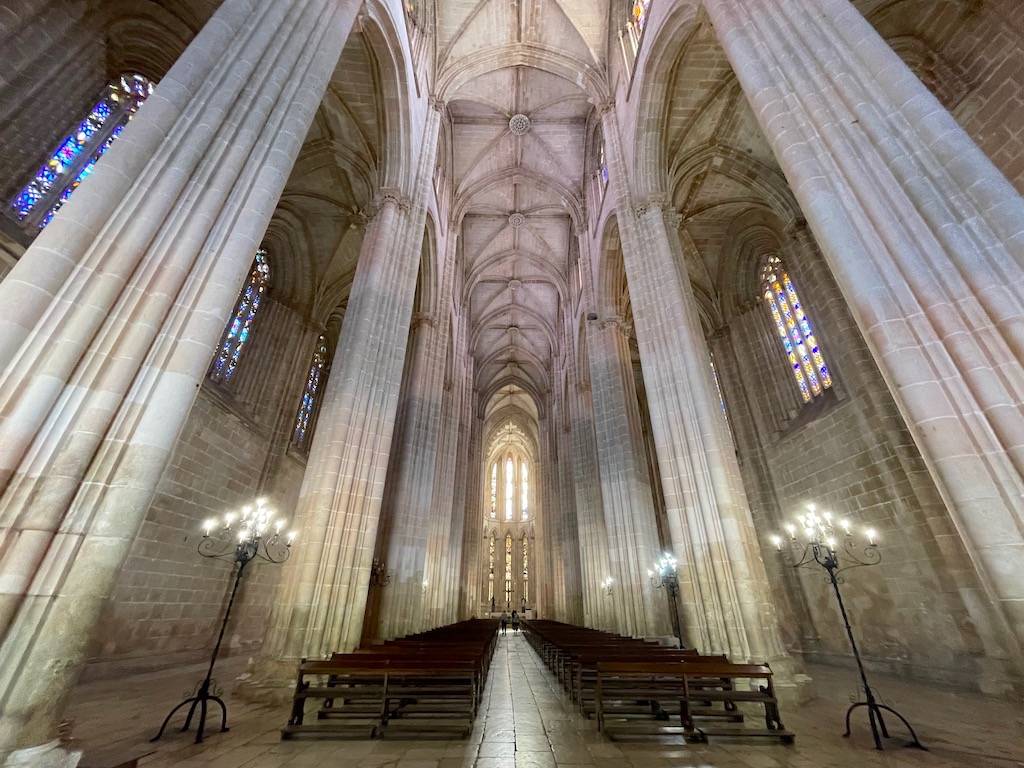
The church is made up of three ships , the two sides being narrower and with a lower ceiling than the main nave. The naves lead to the transept area, where a modern high altar is located in the center of the transept. Furthermore, it consists of five polygonal chapels , with a central chapel larger than the other four. THE chancel it has two floors and is illuminated by sunlight through its stained glass windows, some from the early 16th century. The vaults are decorated by ribs with ogives and chains.

TIP! To visit the nave of the church it is not necessary to have a ticket purchased at the ticket office on the left as you enter the nave. However, to access the other areas such as the Founder's Chapel, the Monastery itself and the Imperfect Chapels, it is necessary to show the ticket for an employee to validate.

2. FOUNDER'S CHAPEL
Located to the right of the nave entrance is the beautiful Founder's Chapel , one of the highlights of the visit. The chapel was completed in 1434 and is filled with architectural and artistic components. It was not foreseen in the monastery's initial plan, but was built by D. João I's decision to make a family pantheon.

The Founder's Chapel has a quadrangular plan and, in the center, there is an octagon covered with a beautiful star-shaped vault that serves as a canopy above the elegant tombs of King D. João I and Queen D. Filipa de Lancastre.
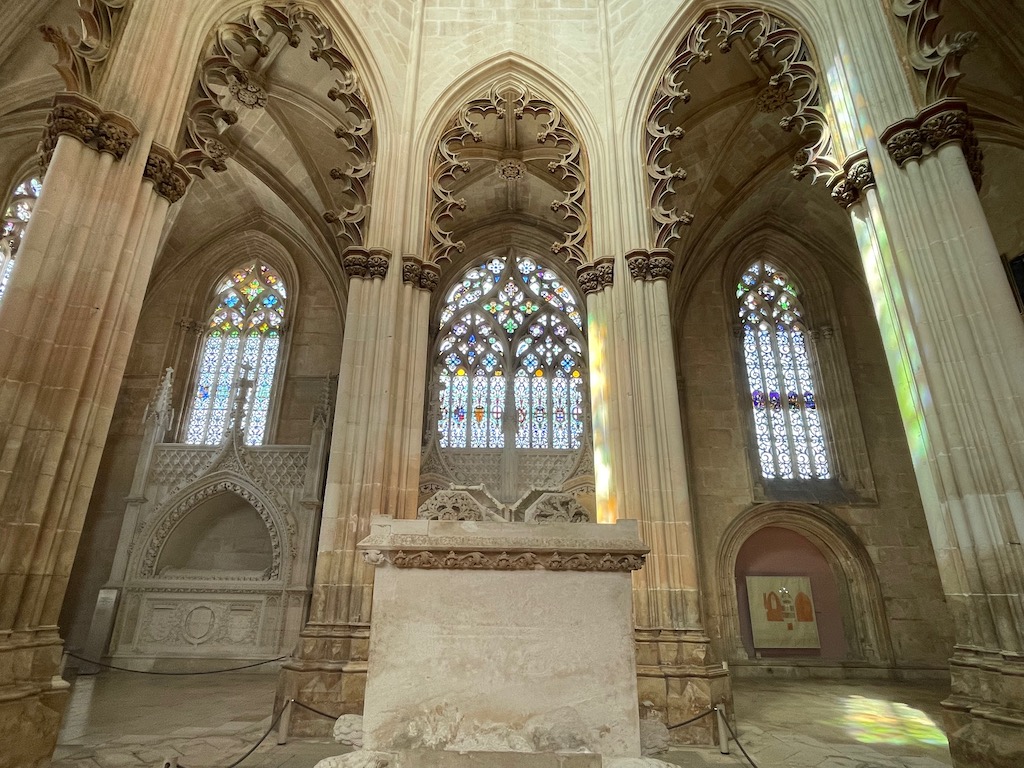
On the back wall, on the south side, are the tombs of the sons of kings dating back to the 15th century. From right to left: tomb of the Infante and Regent D. Pedro and his wife Isabel de Urgel, Duchess of Coimbra; of D. Henrique, the Navigator and Master of the Order of Christ; Infante D. João, master of the Order of Santiago and his wife D. Isabel; and of D. Fernando, master of the Order of Avis. At the beginning of the 20th century, King D. Carlos I, ordered three funerary chests that are located on the west side of the Chapel. In this place are buried, from left to right: the king D. Afonso V, grandson of D. João I; King D. João II, son of D. Afonso V; and Crown Prince D. Afonso, son of D. João II.

3. ROYAL CLOSURE
A door on the left side of the church (you need to show the ticket to access), gives access to the beautiful Royal Cloister of the Monastery of Batalha. Built between 1448 and 1477, the Royal Cloister was part of the initial project, along with the church, sacristy, chapter house, dormitory, refectory and kitchen.

Also called the Cloister of D. João I, it has a square plan with 50 meters on a side and ogival arcades. Its laced decor carved in Gothic style (including quatrefoils, fleurs-de-lis and rosettes) makes an incredible combination with the Manueline style in the arcaded screens with twisted columns. If you've had the opportunity to visit the Jerónimos Monastery , in Lisbon , you will find it very similar.

4. CHAPTER HOUSE
The door that gives access to this room is covered by a large pointed arch and has twin windows with hollow mirrors. THE Chapter House It is a quadrangular area with walls 19 meters long and covered by an eight-pointed star vault. This used to be an important place in the daily life of Dominican friars, who gathered to reflect and to discuss relevant issues of the day. On the east side, there is a beautiful window with three lights and a tall flag with stained glass dating from 1514 and representing three moments of the crucifixion of Christ. In 1921, the remains of two unknown soldiers from the First World War were brought to this space. The dome of the Chapter House is lit by the “Flame of the Homeland” and everything is guarded by Portuguese soldiers who are next to the tomb that honors the thousands of Portuguese who succumbed during the war.

5. ADEGA DOS FRIARS
The Adega dos Frades is an area with Gothic characteristics that, in the past, was used as a former dormitory for the friars. Later, the place started to function as a cellar and, therefore, it has that name. However, currently, the site is used as an Interpretation Center for the Monastery (temporarily closed).

The convent was built in a valley with dense vegetation and at the confluence of several water courses, facilitating the installation of a hydraulic system, which helped to supply the friars' bathrooms, kitchen and other environments. In the center of the royal cloister, there is a well with great water retention capacity that helped in the construction, in the 15th century, of an important water and sewage system, which until today remains partially intact and active.

Take the opportunity to admire the beautiful ornamental fountain on the northwest side of the cloister, which was also called the lavabo and was used for tonsure (religious ceremony is made in clergy with a specific haircut, reducing the hair to a small circle around the head), in addition to washing hands and face. It consists of a fountain and two smaller basins above, illuminated by the light that penetrates through the intricate tracery of the arches around it.
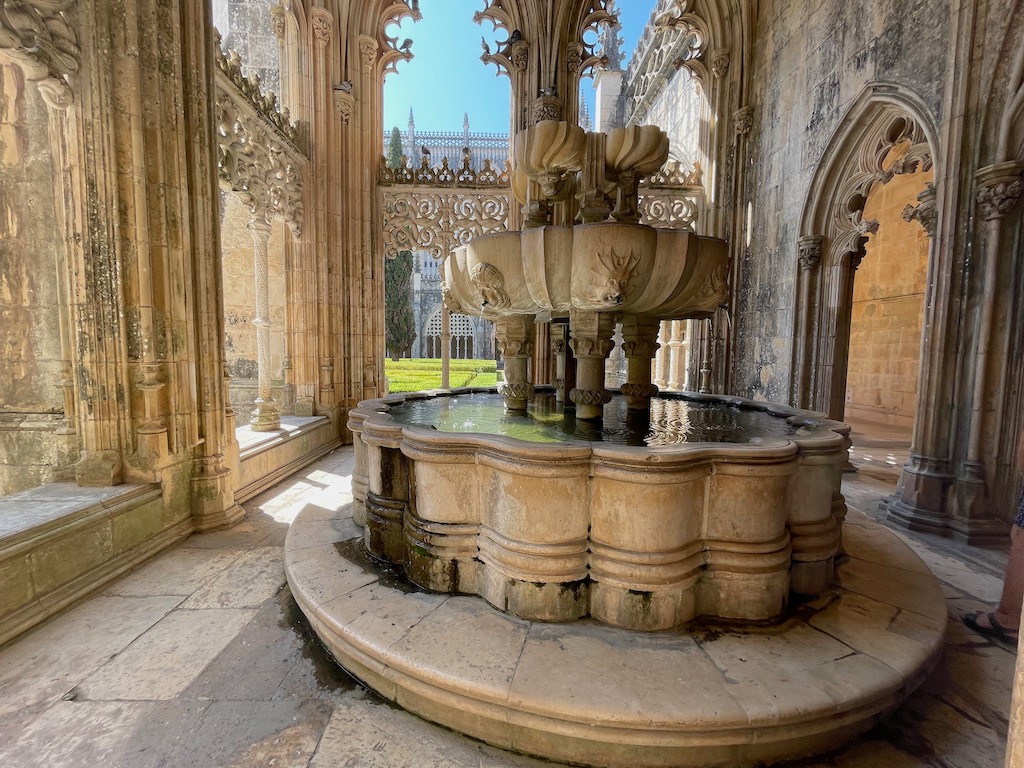
7. MUSEUM OF OFFERINGS TO THE UNKNOWN SOLDIER (Former Canteen)
The monastery's former refectory houses a museum honoring the Unknown Soldier in World War I (1914-1918). This museum belongs to the League of Combatants and displays interesting objects offered to the Unknown Soldier, as well as World War I trophies and military awards. It is worth remembering that Portugal entered the conflict in defense of its territories in Africa that were being threatened by Germany, annexing part of the Portuguese colonies of Angola and Mozambique.

8. STORE (Old Kitchen)
Inside the Monastery of Batalha is a gift shop located in the old kitchen. The store offers replicas of religious images, books, guides, postcards, crockery, jewelry, various publications and many gift items. Check out some of the products available in the store by visiting this link .

9. CLAUSTRO D. AFONSO V
The Cloister of D. Afonso V is simple and has two floors. Almost walking towards the exit, you will see a ladder to go up to the upper floor and reach the upper area. During the first expansion of the convent, at the end of the 15th century, one of the first two-story cloisters in Portugal was built.

It was built following criteria of structural simplicity and decorative austerity. It was built during the first expansion of the convent to accommodate the need for storage and latrines on the ground floor and cells, library and other rooms on the upper floor.

10. IMPERFECT CHAPELS
Leaving the church, you arrive at the Capelas Imperfeitas, whose official name is the Pantheon of D. Duarte. They were built in an octagonal shape and with 7 side chapels. The name “imperfect” is a reference to the fact that they are unfinished, as the central roof was never finished.
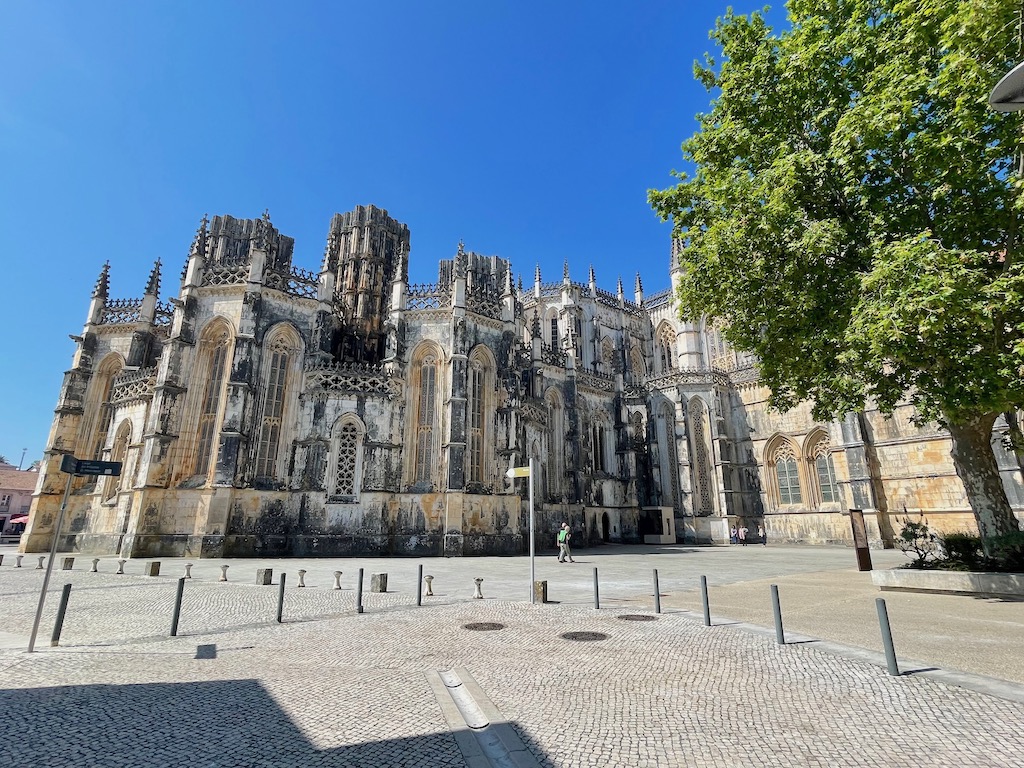
The construction of this structure began around 1434 at the request of King D. Duarte. However, everything changed from 1437 when the king and then the master architect Huguet died, making the completion of the chapel unfeasible.

During the reign of D. Manuel, the 7 chapels were completed and are decorated by carved vaults with coats of arms and emblems. It was only around 1940 that the double tomb of the axial chapel chapel of King D. Duarte and Queen D. Leonor.

OUR EXPERIENCE AT THE BATTLE MONASTERY
We arrived in Batalha on a sunny morning after a day in the beautiful city of Braga. We parked the car and headed towards the Monastery of Batalha, passing through Largo do Monastery of Batalha where the Equestrian Statue of Constable D. Nuno Álvares Pereira , which is on the side.
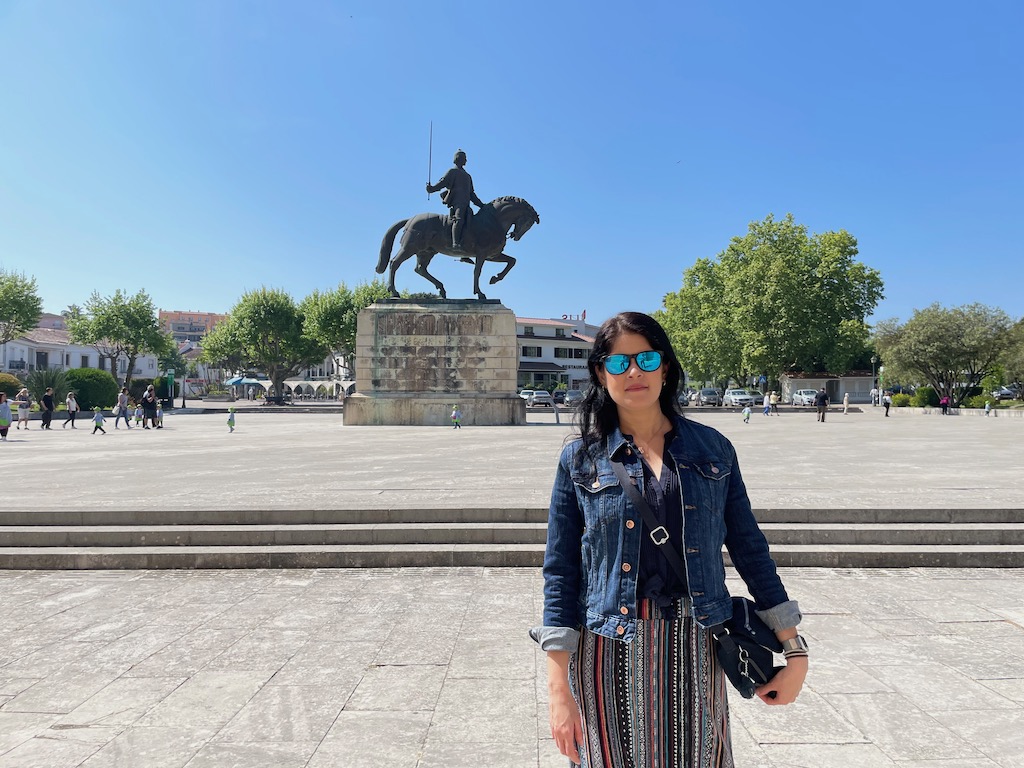
We had already contacted the director of the Monastery of Batalha, Joaquim Ruivo, who guaranteed us free entry for the visit. We went directly to the ticket office and there were our names and free entry to visit the complex.

The ticket needs to be shown on 3 occasions: to enter the Founder's Chapel, to access the Royal Cloister and to visit the Imperfect Chapels. So, keep your ticket for the entire tour. Following the visitation recommendations, we passed through the church's nave and went to the Founder's Chapel , where we were dazzled by the architecture, colorful stained glass windows and the ornate tombs of Portuguese personalities.

We continue to walk through the nave of the church, visiting the chapels and admiring the amplitude of the beautiful church, passing by the high main, until accessing the door that leads to the beautiful Royal Cloister .

Circling the cloister, one passes through the Chapter House , Adega dos Frades (was closed for maintenance), Source , Museum of Offerings to the Unknown Soldier and Store . Leaving the monastery, close to the entrance to the bathrooms, there is a staircase that leads to the Cloister of D. Afonso V , very simple and sober. Going down the stairs again, it's time to leave the monastery and go to the area of the Imperfect Chapels that are perfectly imperfect. What was supposed to be something unfinished, turned out to be a charm differentiating the Monastery of Batalha from other monasteries. The visit was incredible, full of history, beauty and art!

We thank the Directorate-General for Cultural Heritage of the Monastery of Santa Maria da Vitória – Batalha for tickets to visit the attraction. All opinions in this post were based on our experiences during the visit.
SEE ALSO: BATTLE OF ALJUBARROTA INTERPRETATION CENTER
Opened in 2008, the Interpretation Center of the Battle of Aljubarrota is a museum that aims to conduct field studies, preserve and display information about the Battle of Aljubarrota in 1385, as well as disseminate historical data about the 14th century. The Center is located in São Jorge, where the battle took place, just over 3.5 km south of the Monastery of Batalha and has an area of almost 2,000 m². The museum has an exhibition area dedicated to the Battle of Aljubarrota, an auditorium that shows a film that recreates the battle, as well as educational programs and an area for temporary exhibitions.
- Address: Av. Dom, Av. Nuno Álvares Pereira 120, 2480-062 Porto de Mos, Portugal
- Schedules: from tuesday to sunday from 1pm to 5pm | closed on mondays
- Entrance: 7 € | buy tickets in this link

IMPORTANT INFORMATION
Batalha monastery.
- Address: Largo Infante Dom Henrique, 2440-109 Batalha, Portugal
- mid-October to October 9:00am to 6:00pm (last entry at 5:30pm)
- April to mid-October 9am to 6:30pm (last entry at 6pm)
- Single Ticket: 6€ | free for children under 12
- World Heritage Ticket (Alcobaça, Batalha, Convent of Christ): €15 – valid for 7 days
Save these tips to Pinterest!

Read more about Portugal:
- Portugal: What to do in Porto – 2 or 3 days itinerary
- Portugal: How to get from Porto Airport to the center
- Port: Hotel One Shot Aliados Goldsmith 12
- Portugal: Guided Tour of the beautiful Palácio da Bolsa in Porto
- Restaurante Onze: Haute cuisine in Porto
- Porto: Restaurant Francesinhas Al Forno da Baixa
- Cálem: Tour in the most visited cellar in Port Wine
- Vices at the Table – Bad Habits: Pizza and culture in Porto
- Porto.CARD: Savings tip in the city of Porto
- Porto: Lello Bookstore, the most beautiful bookstore in the world
- Portugal: Ribeira Square Restaurant in Porto
- Kind Kitchen: Casual Vegan Food in Porto
- Portugal: Curiosities and Tours on the 6 Bridges of Porto
- Lisbon accommodation tip: Brown's Downtown Hotel
- Portugal: What to do in Lisbon – 3 days itinerary
- Portugal: Guide to where to eat in Lisbon (with map!)
- Lisbon: Dinner with Fado performances at Adega Machado
- Lisbon Card: Savings tip in the Portuguese capital
- Portugal: The historic Jerónimos Monastery in Lisbon
- Portugal: How to visit São Jorge Castle in Lisbon
- Portugal: Visiting the Belém Tower in Lisbon
- Portugal: How to get from Lisbon Airport to the center
- Portugal: Discover the National Pantheon in Lisbon
ARE YOU GOING TO TRAVEL? SCHEDULE YOUR TRIP HERE!
hotel reservation : use the booking.com to book your accommodation, car rental : get a quote at rentcars and check the price at the main rental companies in the world, tickets & tours : buy tickets to the world's top attractions online with get your guide , tickets & tours : buy tickets for tours and guided tours online at civitatis , sports events tickets : buy tickets to major us sporting events online with hellotickets , travel insurance : quote with the promo insurance for different plans and destinations. use code "viajonarios5" to guarantee 5% off, train in europe : buy your train tickets at the best prices at trainline , international cell phone chip with the easysim4u and leave with the chip working before travelling, purchase of foreign currency with the best exchange rates with exchange now , related articles more from the author.

Portugal Itinerary: Suggestion of 20 days of travel
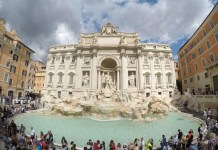
Italy: 5 free tours in Rome

Germany: How to get from Berlin airport to the center
Leave your comment cancel comment.
Save my name, email and website in this browser for the next time I comment.
Notify me of follow-up comments by email.
Notify me of new posts by email.
You are using an outdated browser. Please upgrade your browser to improve your experience.
- Sacred Destinations
Sacred Sites, Religious Places, Pilgrimages
- Destinations
Batalha Monastery
Founded in thanksgiving for a major military victory in 1385, Batalha Monastery (Mosteiro de Santa Maria da Vitória de Batalha) is a magnificent example of medieval Portuguese architecture.
History of Batalha Monastery
In 1385 , King João I vowed that if his outnumbered army defeated the Castilians at the important Battle of Aljubarrota, he would build a magnificent monastery dedicated to the Virgin Mary. The king was victorious, resulting in the independence of Portugal from Spain and the great Batalha Monastery.
King João I gave the monastery to the Dominicans and the splendid edifice was constructed over the next two centuries in the Gothic and Manueline styles. Along with all other monasteries in Portugal, Batalha was dissolved in 1834.
Batalha Monastery was added to UNESCO's World Heritage List in 1983 because it commemorates an important historical event and "here a highly original, national Gothic style evolved, profoundly influenced by Manueline art, as demonstrated by its masterpiece, the Royal Cloister."
What to See at Batalha Monastery
The west facade , covered in lacy stonework and filled with Gothic windows, overlooks a spacious plaza. The building is illuminated at night to spectacular effect. The octogonal building attached to the right of the church is the Founder's Chapel.
The west portal of the church is decorated with a riot of Gothic sculpture: the arc-shaped tympanum depicts Christ in Majesty with the Evangelists, while angels, saints and biblical figures look on from the six archivolts.
The doors are flanked by free-standing statues of the Twelve Apostles, each one with a unique appearance. The top of the facade contains the largest stained-glass window in Portuguese Gothic architecture.
There is plenty of room to walk around to the east end of the monastery, where there is a good view of the apse and Unfinished Chapels (on which more below). At the southeast corner is an equestrian statue of Nuno Alvares , who fought with João I in the battle of Aljubarrota. The modern monument was unveiled in 1968.
The three-aisle nave has the soaring vertical lines of the pure Gothic style. The monastery's windows are of exceptional beauty and, of course, best enjoyed on a sunny day. The stained-glass windows of the chancel - depicting the Visitation, the Adoration of the Magi, the Flight into Egypt and the Resurrection - have been carefully restored to their 16th-century Manueline form.
On the right just inside the entrance is the beautiful Founder's Chapel , completed by English architect Master Huguet in 1434. The octagonal structure is illuminated with tall stained glass windows and topped with an exquisite star vault.
It contains the tombs of King João I and his English queen, Philippa of Lancaster (daughter of John of Gaunt), whose stone effigies lie in repose with their hands entwined. The tomb of their famous son, Prince Henry the Navigator , is nearby.
The lovely Royal Cloister was built during the reign of João I, with embellishments in the Manueline style added to the interior arches later. It includes a square Chapter House (19 meters long on each side) with a huge Gothic vault that is remarkable for having no central supports.
Also notable is the finely sculpted Gothic lavabo (used for ritual washing) in front of the refectory. The Afonso V Cloister , by contrast, is remarkable for its simplicity and lack of ornamentation, reflecting the particular taste of its architect, Fernao de Evora.
At the east end, a richly ornamented portal leads to the seven Unfinished Chapels , built to house the tombs of the first kings of the Avis dynasty. Construction was abandoned when the workers were called away to Lisbon to build the Jeronimos Monastery for Manuel I.
Open to the sky, the chapels are one of the finest examples of the richly ornamental Manueline style. The huge coral-stone portal by Mateus Fernandes, in particular, is one of the great masterpieces of Manueline architecture.
The seven chapels radiate from an octogonal rotunda with massive stone pillars that would have support a great vault. Left unfinished, they provide an interesting glimpse into medieval construction.
In one of the chapels, the tomb effigy of D. Duarte lies hand-in-hand beside his wife, Leonor of Aragon. In the center of the rotunda are . The upper level is home to a beautiful Renaissance balcony.
Getting There
Batalha is located 118km (73 miles) N of Lisbon and not far from Fatima and Alcobaça .
From Lisbon, trains run to Valado dos Frades (€7.30 to €8.50 one-way) and buses continue from there to Batalha.
Six expresso buses run from Lisbon to Batalha daily (2 hours; €7.80 one-way). From Nazaré, seven buses go to Batalha daily (1 hour; €2.25 one-way), with a change at Alcobaça.
By car from Alcobaça , take the N8 northeast for about 20 minutes.
Most visitors to Batalha choose to stay in Fátima or Nazaré, which have more hotels and restaurants. However, there are some places to sleep and eat in Batalha.
Quick Facts on Batalha Monastery
- Mosteiro de Santa Maria da Vitória - Frommer's Portugal, 20th edition
- Batalha: Planning a Trip - Frommer's Portugal, 20th edition
- Monastery of Batalha - Portuguese Tourist Office
- Monastery of Batalha - UNESCO World Heritage
- Batalha Monastery Reviews - TripAdvisor
- Batalha, Monastery Santa Maria da Vitoria - Impressions of Portugal
More Information
- Photos of Batalha Monastery - here on Sacred Destinations
Map of Batalha Monastery
Below is a location map and aerial view of Batalha Monastery. Using the buttons on the left (or the wheel on your mouse), you can zoom in for a closer look, or zoom out to get your bearings. To move around, click and drag the map with your mouse.
Batalha Monastery
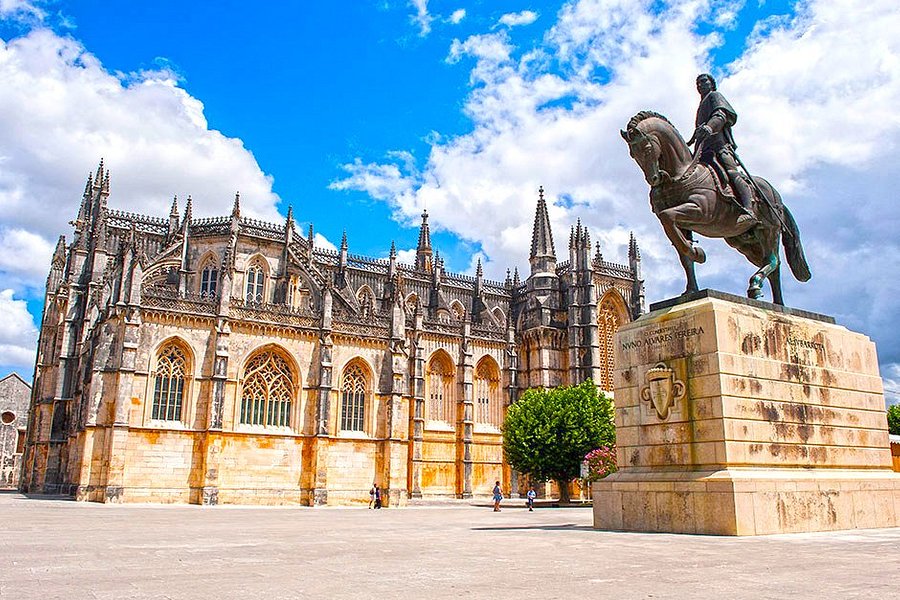
Most Recent: Reviews ordered by most recent publish date in descending order.
Detailed Reviews: Reviews ordered by recency and descriptiveness of user-identified themes such as wait time, length of visit, general tips, and location information.
Also popular with travelers


- North Region
- Viana do Castelo
- Douro Region
- Central Region
- Serra da Estrela
- Castelo Branco
- Lisbon Region
- Castelo de Vide
- Vila do Bispo
- Vila Real de Sto. A.
- Arch. of Madeira
- Porto Santo
- Means of Transport
- Natural Parks
- Theme Parks
- Zoos and Aquariums
- Nightlife Spots
- Centro Region
- Estoril Coast
- Castro Marim
- Vila Real de Sto A.
- All-inclusive Trips
- Portugal with Children
- Weekend in Portugal
- Weekend in Lisbon
- Weekend in Porto
- Organize your tour
- Porto Airport
- Lisbon Airport
- Faro Airport
- V.R de Sto. Antonio

Portugal Travel
Organization of Portuguese agencies

- Customized tours
- Archipelago of Madeira
- Prepare your holidays
- Accommodation
- What to See
- Zoos & Aquariums
- Privacy and Policy
Batalha Monastery, Portugal
Do not miss the chance to visit monastery of santa maria da vitoria or monastery of batalha during your visit to portugal..
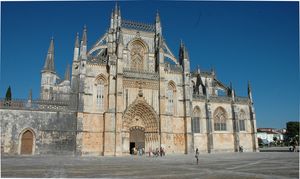
The Monastery of Santa Maria da Vitória , widely known as Batalha Monastery , is a majestic building, declared World Heritage by the UNESCO . Combining Manueline and Gothic styles, it was built in the 14th century to carry out the promise D. João I did to the Virgin in case they won the Castilians in the Battle of Aljubarrota , in 1385.

In this battle, 6,500 Portuguese defeated an army of 30,000 Castilians, leaded by Juan I of Castilla, who claimed João D’Avis’ throne for himself. Portuguese were commanded by Nuno Álvares Pereira and supported by hundreds of English soldiers. This general played a very important role during the Portuguese Crisis that took place between 1383 and 1385. Nowadays, it is possible to see a honorific equestrian statue of himself.
João prayed for Virgin Mary’s help, and vowed to build this monastery in exchange for victory. Three years later, he kept his promise and began with the construction of this monumental abbey.
In 1434, most of the blasing Gothic Monastery (the church, the Sala do Capítulo Hall, the Capela do Fundador (Founder’s Chapel), and the Royal Cloister) had been built. Despite this, the true jewels of the monuments are the Manueline details, thanks to the incorporations made in the 15th and 16th centuries. Its construction just stopped in the mid-16th century, when João III managed to stop building the Convent of Christ in Tomar .
The outside of this impressive building in ochre has numerous pinnacles, flying buttress, parapets and balustrades, as well as Gothic and blasing carved windows; and octagonal chapels and columns. The Occidental arcade has overlapping arches where angels, apostles, prophets, saints and Christ can be seen.
The interior has a simple Gothic vaulted style of big dimensions. It is illuminated by colourful stained glasses.
As soon as you cross the entrance, on the right, it is possible to find the Chapel of Fundador, an incredibly square tall hall covered by a star cupola illuminating the room.
Claustro Real (Royal Cloister):
Built by Afonso Domingues, it is a sober cloister Gothic in style, despite the added Manueline elements by Diogo de Boitaca. Each one of its arches is an elaborated Manueline carving ball. Three stunning cypresses located in the central patio, reproduce the shape of the Gothic towers of the Sala do Capítulo Hall.
Dom Afonso V Cloister:
Designed by the master Fernão de Évora, this cloister has a more sober Gothic style.
Sala do Capítulo Hall:
Dating back to the 15th century, it is located to the East of the Claustro Real (Royal Cluster). It has a gorgeous 16th century stained glass. Its enormous vault suspended 19-metres high, was considered so dangerous that for its construction only death row prisoners worked on it.
The hall hosts the tombs of unknown soldiers, which are flanked by a permanent honour guard.
Capelas Imperfeitas (Flawed Chapel):
These unfinished chapels without roof, are one of the most surprising things in Batalha. They just can be reached from the exterior of the monastery. It is octagonal and has seven chapels, commanded by Dom Duarte, son of D. João I, in 1437.
Afterwards, it was enlarged with extraordinary Manueline elements by the architect Mateus Fernandes. Although they were never completed, their exquisite decoration is amazing. It is worth to visit its 15-metres tall porch, with its flowers, snails, and different plant motifs carved in the stone. Dom Duarte and his wife’s tomb is located in front ot the door.
The old refectory and kitchen host the Museum of Oferendas ao Soldado Desconhecido .
More information:
Mosteiro da Batalha, Batalha.
Ticket price:
Single Ticket: 6 €.
Combined ticket for different monuments (Alcobaça, Batalha, Christ Convent): 15 €.
Free entrance all Sundays and Bank holidays until 14h00.
Available discounts for retirees, Youth Card, families and ex-combatants.
Opening hours:
From April to September from 9h00 to 18h00. From October to March from 9h00 to 17h00.
Closed on 1st January, 1st May, Good Friday, Easter Sunday and 25th December.
(+351) 244 765 497.
Recommended Excursions:
Mapa Interactivo:
What to see :
- Batalha Monastery
- Museum of Oferendas ao Soldado Desconhecido
- Batalha Mother Church
- Alta Estremadura Ethnographic Museum (Casa Madalena House)
- Grottoes of Moeda
- Pia do Urso Sensorial Ecopark
- Mira d'Aire Grottoes
- Santo António Grottoes
- Alvados Grottoes
- Serras d'Aire e Candeeiros Natural Park
More cities in the Lisbon Region:
- Estoril Coast / Oeiras
- Costa da Caparica
- Figueira da Foz
- Marinha Grande
- Porto de Mós
Why "Portugal Travel"?
Portugal Travel is an organization of Portuguese agencies whose objectives are:
- ✓ To make Portugal , its culture and its heritage known .
- ✓ To promote sustainable tourism .
In collaboration with:
Escola Superior de Hotelaria e Turismo do Estoril
Turismo de Portugal

Sign Up Today
Start your 14 day free trial today

The History Hit Miscellany of Facts, Figures and Fascinating Finds
Batalha Monastery
Batalha, Centro, Portugal
Batalha Monastery is a stunning Gothic creation originally built to celebrate a famous military victory.

Antara Bate
24 nov 2020, about batalha monastery.
Batalha Monastery is a stunningly ornate Gothic creation dating mostly to the reign of King Joao I. This king began building Batalha Monastery – the full name of which is Mosteiro Santa Maria da Vitória – in thanks to the Virgin Mary for victory at the battle of Aljubarrota in 1385. King Joao and his family would also be buried here. Successive kings such as Duarte and Manuel I continued to add to Batalha Monastery, making their mark on this important structure.
Batalha Monastery history
The Monastery of the Dominicans of Batalha was built to commemorate the victory of the Portuguese over the Castilians at the battle of Aljubarrota in 1385. It was to be the Portuguese monarchy’s main building project for the next two centuries. Over the course of the project, a highly original, national Gothic style evolved, profoundly influenced by Manueline art, as demonstrated by the Royal Cloister.
The Monastery is thought to have been designed by English architect Master Huguet. The chapel’s floor plan consists of an octagonal space inserted in a square, creating two separate volumes that combine most harmoniously. The ceiling consists of an eight-point star-shaped lantern. The most dramatic feature is to be found in the centre of the chapel: the enormous medieval tomb of Dom João I and his wife, Queen Philippa of Lancaster. Bays in the chapel walls contain the tombs of their sons, among them Prince Henry the Navigator.
The main entrance of the church is through the porch on the west facade. On both sides of this portal are sculptures of the twelve apostles standing on consoles. In the centre is a high relief statue of Christ in Majesty surrounded by the Evangelists, framed by six covings decorated with sculptures of biblical kings and queens, prophets and angels holding musical instruments from the Middle Ages.
As a monument charged with a symbolic value from its foundation, the Monastery of Batalha was, for more than two centuries, the great workshop of the Portuguese monarchy.
Whilst the monastery escaped the devastation of the 1755 earthquake it was badly damaged during the Peninsula War in 1810 when Napoleonic troops sacked the monastery. In the following years the building went into decline. King Fernando II initiated restoration works in 1840. This continued almost as long as the original build and saw Batalha added as a UNESCO World Heritage site in 1983.
Batalha Monastery today
The monastery blends a rich history with impressive architecture such as its vast vaulted ceilings, Batalha Monastery is listed as a UNESCO World Heritage site and also features as one of our top 10 tourist attractions in Portugal .
Getting to Batalha Monastery
Batalha is located 118km north of Lisbon, close to Fatima and Alcobaça. From Lisbon, trains run to Valado dos Frades and buses continue from there to Batalha. By car from Alcobaça, take the N8 northeast and the drive should be around 20 minutes.
Featured In

Historic Sites in Portugal
Discover some of the best historic sites in Portugal, from the famous Belém Tower to the Pena National Palace and more.

Related Articles

What Types of Helmets Did Vikings Wear?

Who Really Won the Battle of Bosworth?
Watch and listen.

Before Columbus: How the Vikings Came to America

Mongol Empire
You may also like.

The Duke of Wellington: Where History Happened

Important Maritime Museums to Visit Around the World

8 Amazing Castles for Your Wedding

The Best Roman Bath Ruins to Visit in Europe

6 Incredible Historical Locations from the James Bond Films

10 of the Best Historic Sites in Portugal

Hotel Palácio Estoril

Lisbon Roman Theatre Museum

Castelo de Almourol

Convent of the Capuchos

Castelo dos Mouros

Ajuda National Palace

Jerónimos Monastery

The Monasteries of Portugal: Alcobaca, Batalha, and Tomar: Exploring The Beautiful History Of Portuguese Monasteries
Can you visit the incredible cities of Alcobaca, Batalha, and Tomar in one day? Yes! We show you how to do it as a day trip from Lisbon Portugal
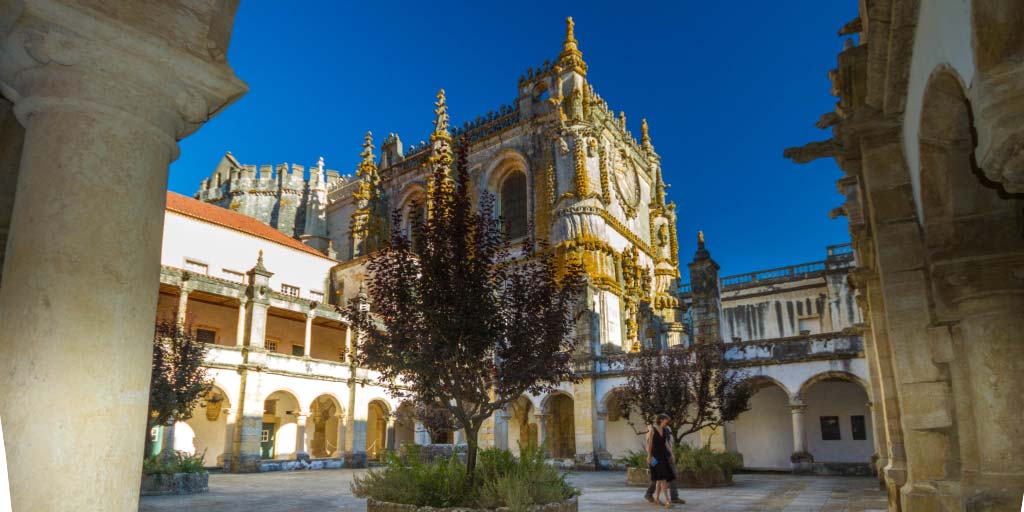
Portugal is ripe with history. This country, which birthed some of the world’s greatest explorers. Yet, nestled within this beautiful nation is where the true heart of Portugal lies. With over 80% of Portugal identifying as Catholic, there is no lack of important religious sites in Portugal. So, during our travels in Portugal , we made sure to take in some of the country’s most spectacular religious sites like Alcobaca, Batalha, and Tomar.
There was something magical about exploring the rich history of Portugal’s monasteries in Alcobaca, Batalha, and Tomar. Walking through incredible architecture was like stepping through a portal and into the rich history of Portugal during it’s most ambitious days. And what’s great about these sites is that it’s possible to visit Alcobaca, Batalha, and Tomar in one day on a day trip from Lisbon! And if you don’t want to drive yourself, you can join an organized tour from Lisbon that explores these three incredible sites.
Alcobaca, Batalha, and Tomar: The Great Monasteries of Portugal’s Heartland
In the heart of Portugal, north of Lisbon lies the Estremadura and Ribatejo regions of Portugal. The area is known for its historical villages , fertile farmland and of course, some of Portugal’s legendary castles ! We had so much to see in the region, including a separate day trip to Evora, Portugal .
But, with only a limited time in the country, we decided to head to the region to visit 3 highly accessible UNESCO World Heritage Sites , Alcobaca Monastery, Batalha Monastery, and the Convent of Christ in Tomar. And, even with a baby in tow, exploring the cloisters, heritage, and amazing churches of Alcobaca, Batalha, and Tomar was an amazing adventure.
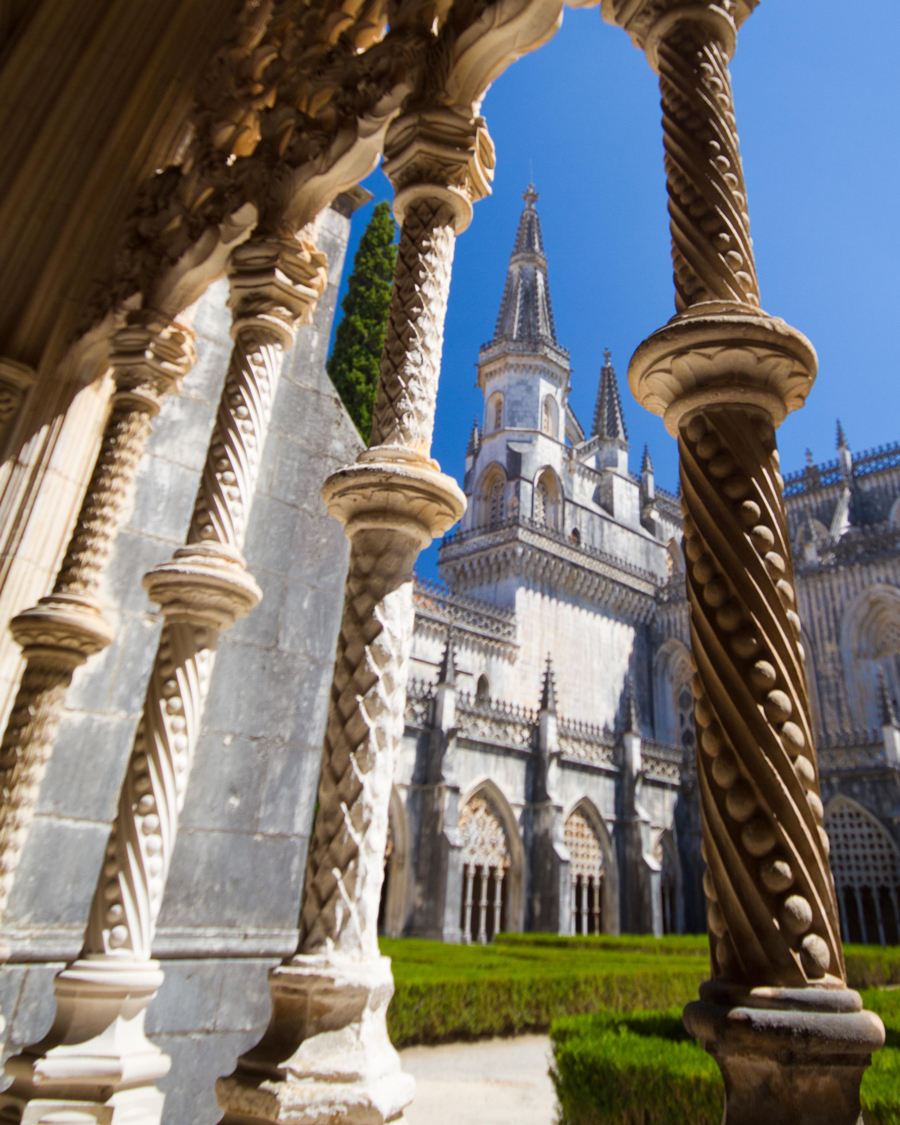
How To Get To From Lisbon To Alcobaca, Batalha, and Tomar?
Visiting the three monasteries of the Estramadura region is an easy day trip from Lisbon . It’s about a 1.5-hour drive from Lisbon to Alcobaca. Once you are there, the three cities of Alcobaca, Batalha, and Tomar are just 65 km (40 miles) from each other with Tomar being the farthest from Lisbon.
Visiting Alcobaca Monastery in Alcobaca Portugal
Alcobca Portugal is just 100 km north of Lisbon. The prime reason for our visit was to ogle the magnificent gothic monastery of Alcobaca. This gorgeous complex is often referred to as the Alcobaca Monastery, but its official name is Mosteiro de Santa Maria de Alcobaca .
Alcobaca Portugal is not a big town, so it’s very easy to navigate the region on foot. We drove to the town and parked our car near the central square. Surprisingly, for such a popular attraction in Portugal, finding parking wasn’t too difficult.
The Alcobaca church and monastery was commissioned by King Afonso, the first king of Portugal, in 1138 AD to commemorate his victory of Santarem from Moorish control. The structure was finally completed in 1223 AD.
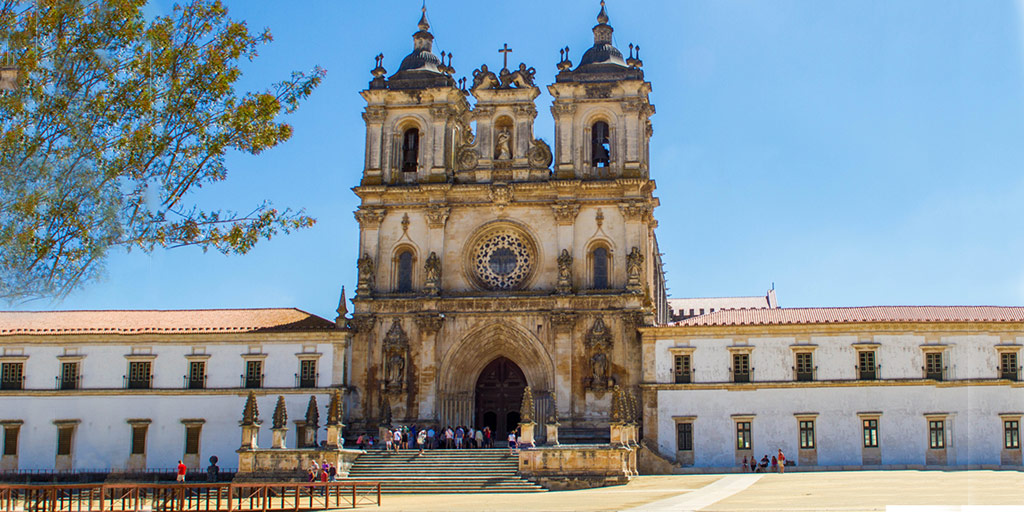
Pro-Tip: For those that do not want to drive or rent a car, it is possible to get to Alcobaca from Lisbon bus.
During the 17th and 18th centuries, the original Gothic facade was altered such that only the doorway and rose window were part of the original concept. Additionally, at this time, wings were added. Today it holds a UNESCO World Heritage Site designation and is Portugal’s largest Gothic church.
Inside the Alcobaca Church
There was no entrance fee for entering the Alcobaca church when we visited. As we merged with the crowds entering the church through the massive archway, the first thing I noticed was the very large pillars that lined the nave. At 106 m in length and 23 m in width, it is almost impossible to comprehend it’s size without actually walking it.
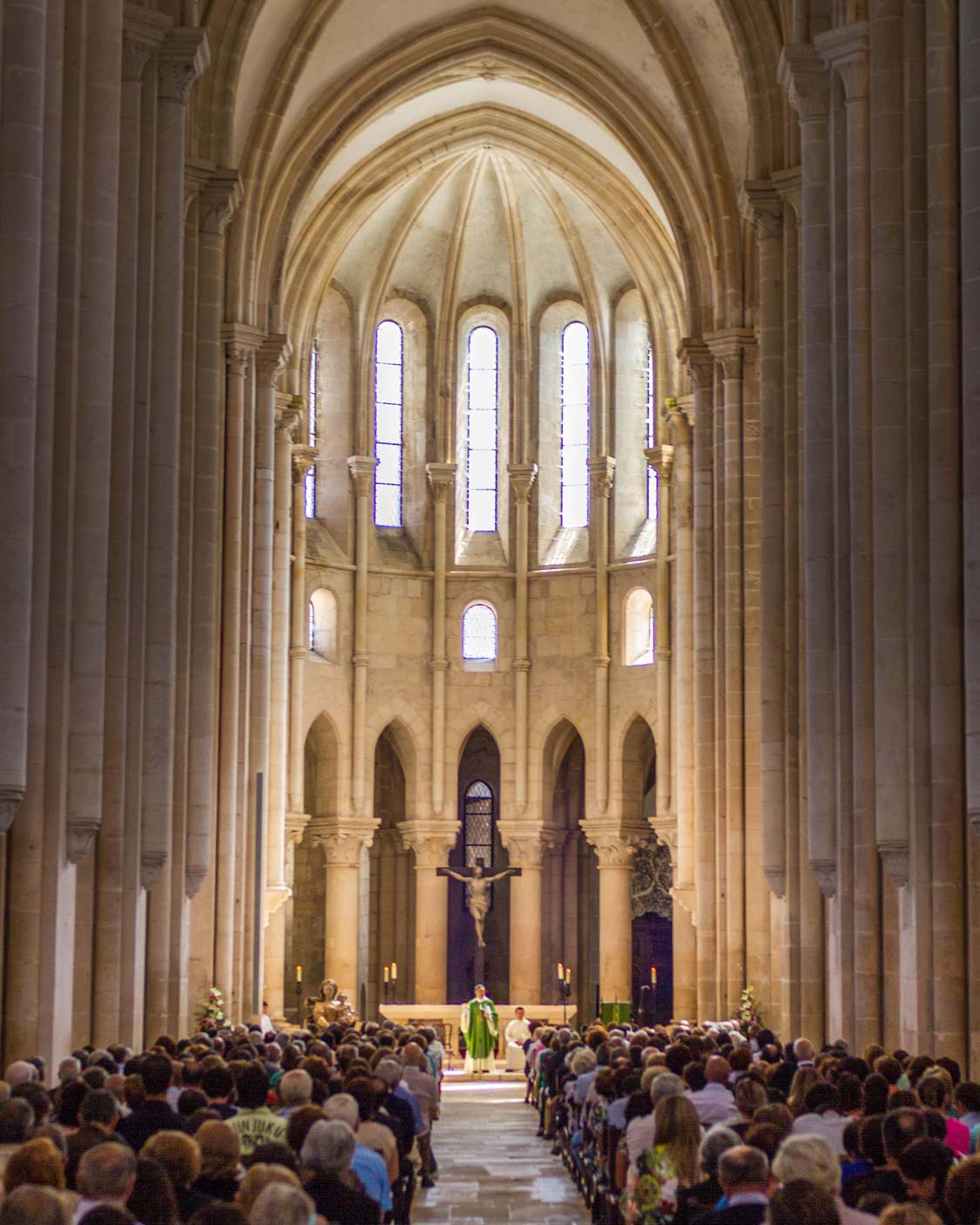
The Love Story Of Dom Pedro and Dona Ines
We headed further towards the back of the Alcobaca church and then I saw it. The Tombs of Dom Pedro and Dona Ines laying foot to foot. The love story of Dom Pedro and Dona Ines is a tragic one. They were lovers who married in secret. Dom Pedro’s father, who was the ruling king at the time, thought that Ines would not be a good choice politically and forbade the lovers’ relationship. In fact, he was so worried about their potential union and its effects on the crown, that he had her assassinated.
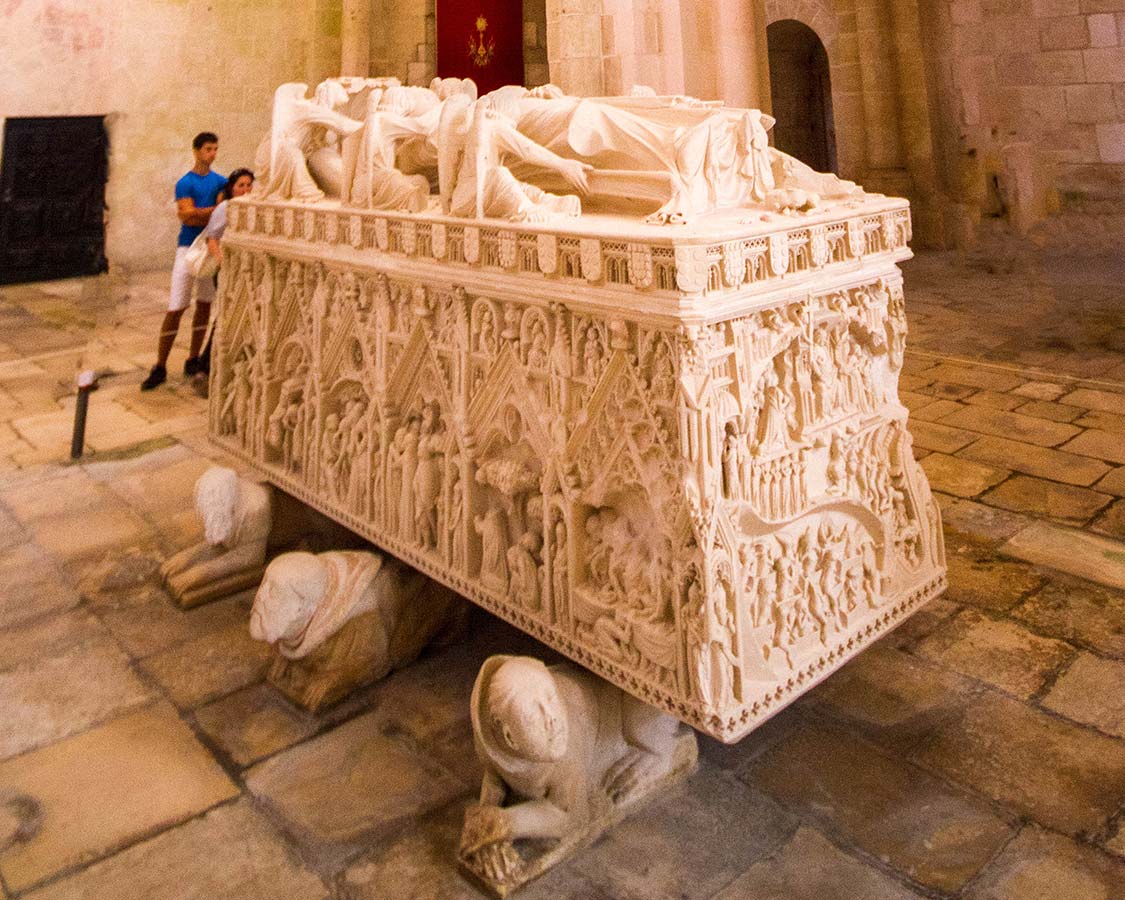
Just two years after her death, Dom Pedro became king of Portugal. One of his first acts was to exhume his dead lover and have her placed in an intricate tomb where everyone could honor her. According to legend, Dom Pedro chose at his time of death for them to be laid in such a way so that when they arose in the afterlife they would see each other.
The tombs were every bit as intricately carved as I had read. I could clearly discern the Last Judgement scene at the foot of Ines’ tomb and the Wheel of Fortune at the head of Dom Pedro’s tomb.
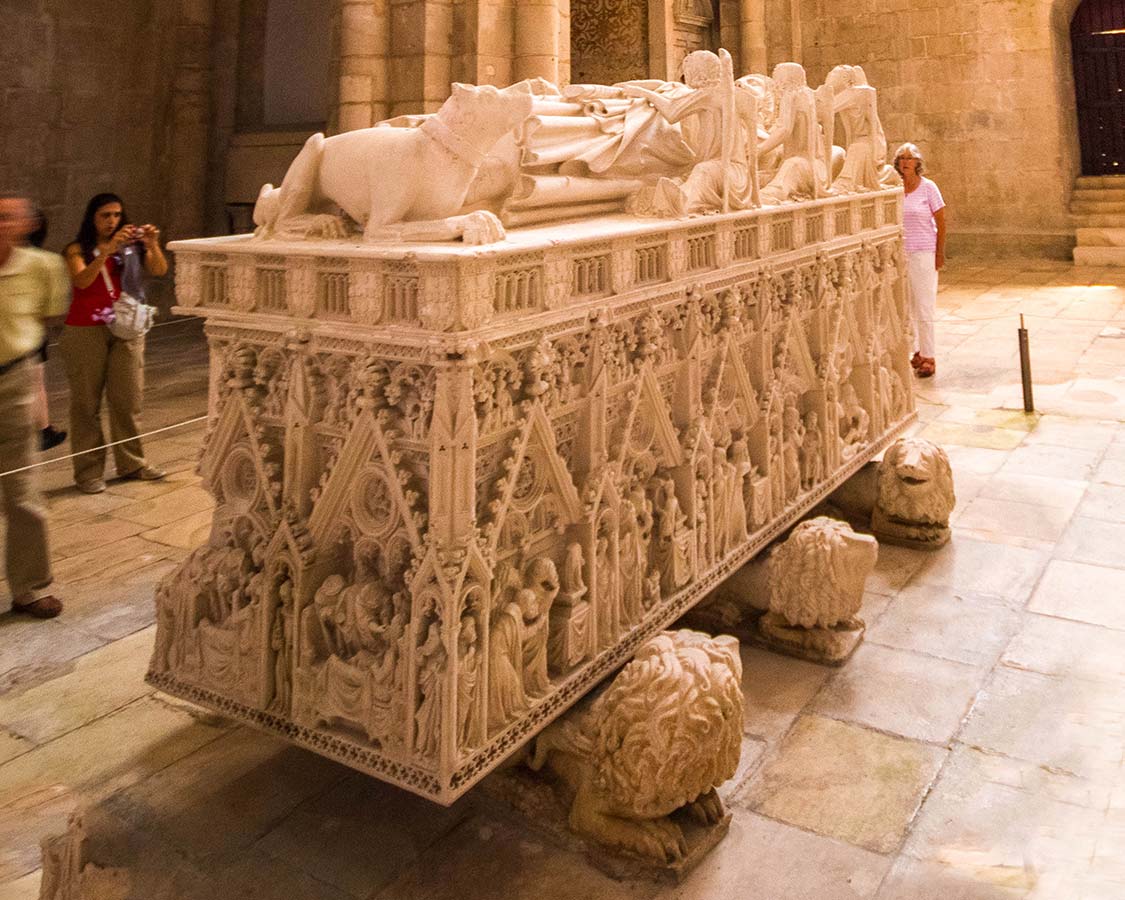
Exploring The Alcobaca Monastery
After paying our respects to Dom Pedro and Ines we wandered to the massive kitchen in the Alcobaca Monastery. It’s hard to imagine the need for such a large kitchen, but at its peak, there were almost 1000 monks in the Monastery! No wonder there were seven dormitories and a library on site. Adjacent to the kitchen is the refectory where the monks of Alcobaca sat in quiet reverence while they ate their meals.
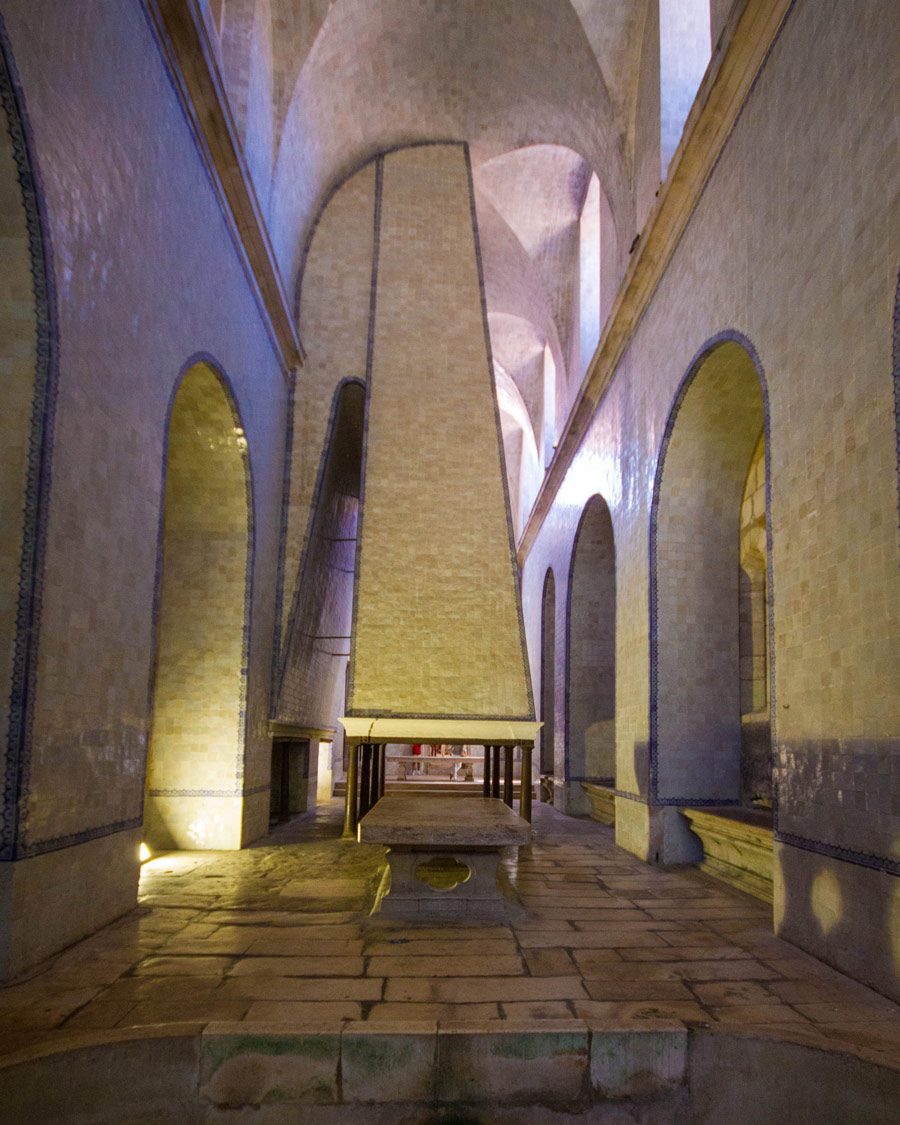
Cloister of Silence (Claustro do Silencio)
Next, we headed to the Cloister of Silence. The two-story cloister was every bit as beautiful in person as I had previously seen in pictures. We walked among the orange trees in the lower level to get a 360° view of the intricate design. From the lower level of the Cloister of Silence, we made our way to the upper level which offers incredible views of the Alcobaca Monastery cloister garden. The Manueline style really stood out as it is quite different from the rest of the Monastery.
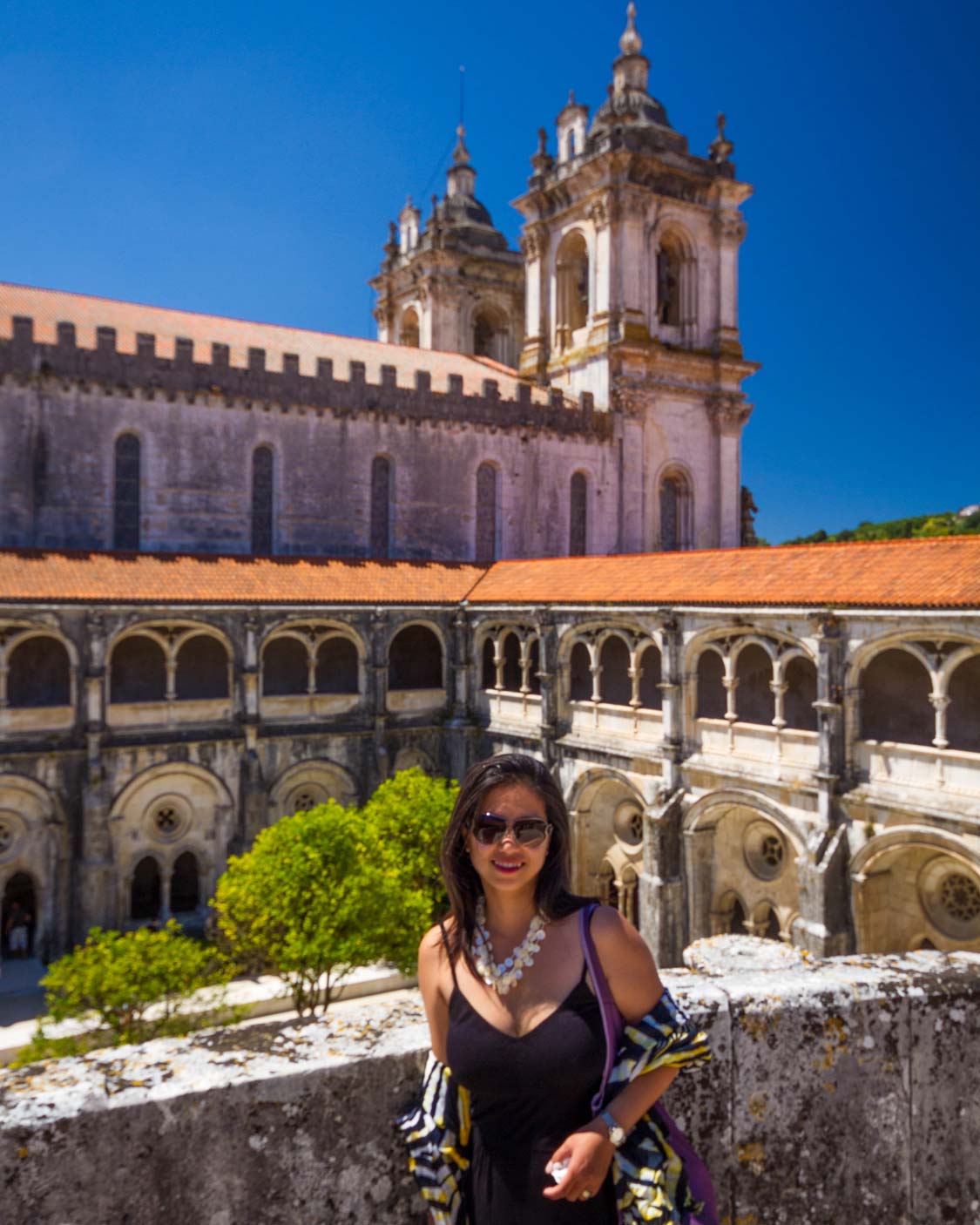
Exploring Batalha Monastery in Batalha Portugal
The second monastery to visit on our list was in the town Batalha, which is only 30 minutes and 24 km (15 miles) from Alcobaca by car. The Batalha Monastery (Monasterio de Santa Maria da Vitoria) has a dramatic and detailed exterior that really stands out amongst the modern architecture of Batalha Portugal. It was the perfect second stop on our tour of Alcobaca, Batalha, and Tomar.
The Batalha Monastery is a Dominican Abbey built beginning in 1386 over more than a hundred years. It was finally completed in 1517 . The monastery has a dramatic Gothic architecture with strong Manueline accents. The building has tremendous architectural value and its historical significance led to the building being classified as a UNESCO world heritage site in 1983.
It’s impossible to miss the Batalha Abbey as you come into town. It towers over the nearby buildings and it’s impressive facade absolutely dominates the surrounding skyline. The spires
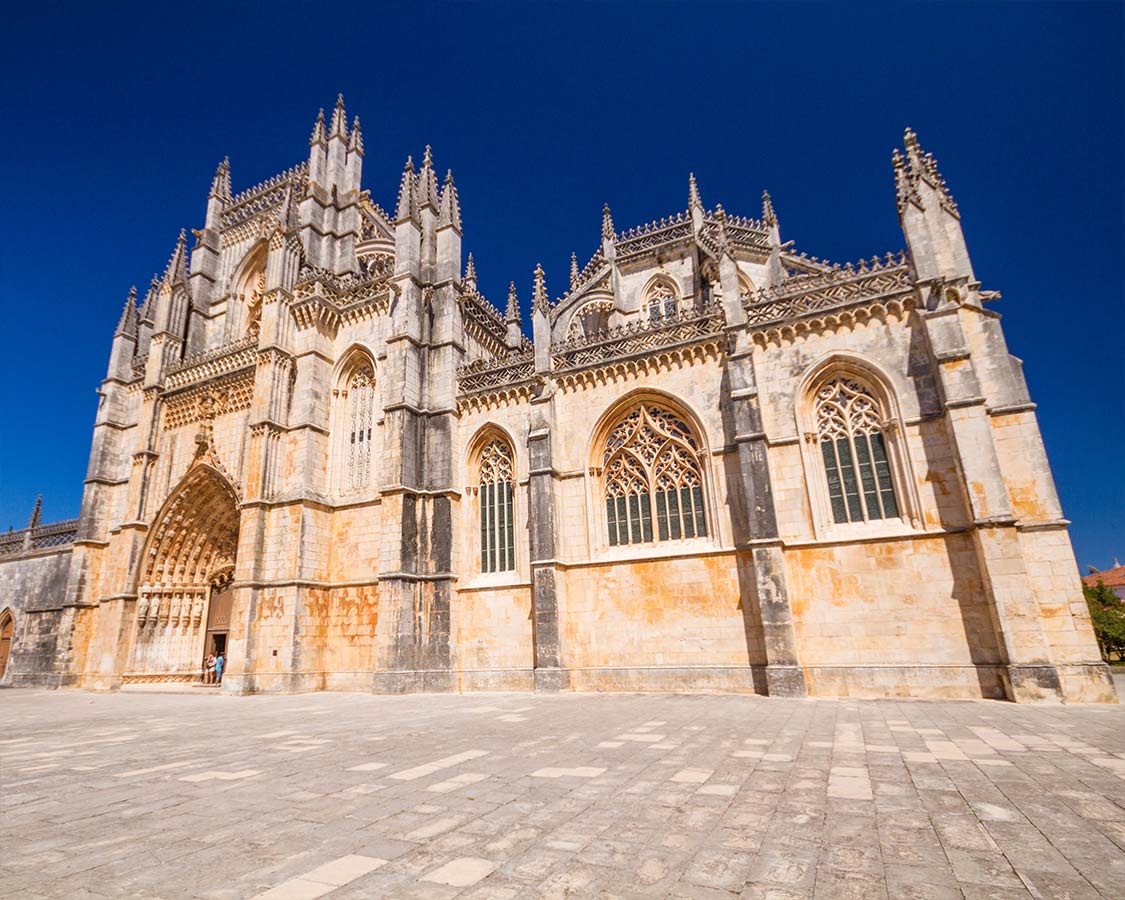
The exterior of Batalha Monastery makes it pretty obvious as to why the church took two centuries to be completed. The limestone building, now in an ochre hue due to the stains of time, has pinnacles, parapets, and flying buttresses. I could have stared at the intricately carved windows and doorway for hours.
Interior of Batalha Monastery
At first glance, the Monastery of Batalha looked very similar to the Monastery of Alcobaca. Both have vast but narrow naves and rather plain interiors dominated by massive Gothic pillars. And because we arrived in the late afternoon, the sun was perfectly shining through the rich stained glass windows. The bright colors of the Batalha Monastery glass gave the church a warm glow we did not see in Alcobaca.
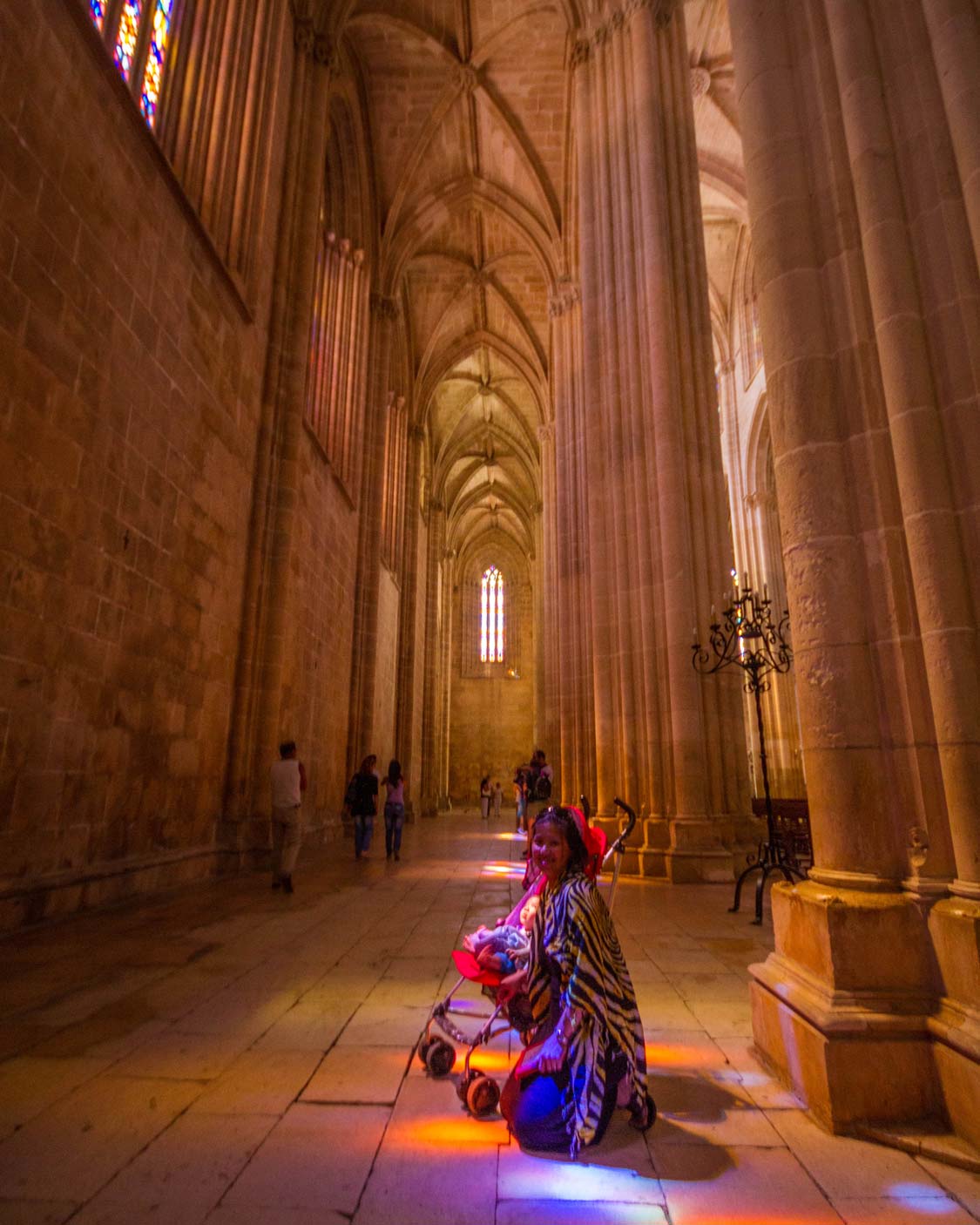
Claustro Real (Royal Pantheon)
The Royal Cloisters or the Royal Pantheon of the Batalha Monastery was one of the most dramatic parts of the complex. The cloister was originally designed in Gothic style by Afonso Domingues in the late 1380s. But the Manueline additions by Diogo de Boitac really gives the Claustro Real the dramatic style that has made it so popular.
And boy, did it ever take our breath away. It was made even more striking when compared to the very plain Claustro de Dom Afonso V which is also on part of the Batalha Monastery.
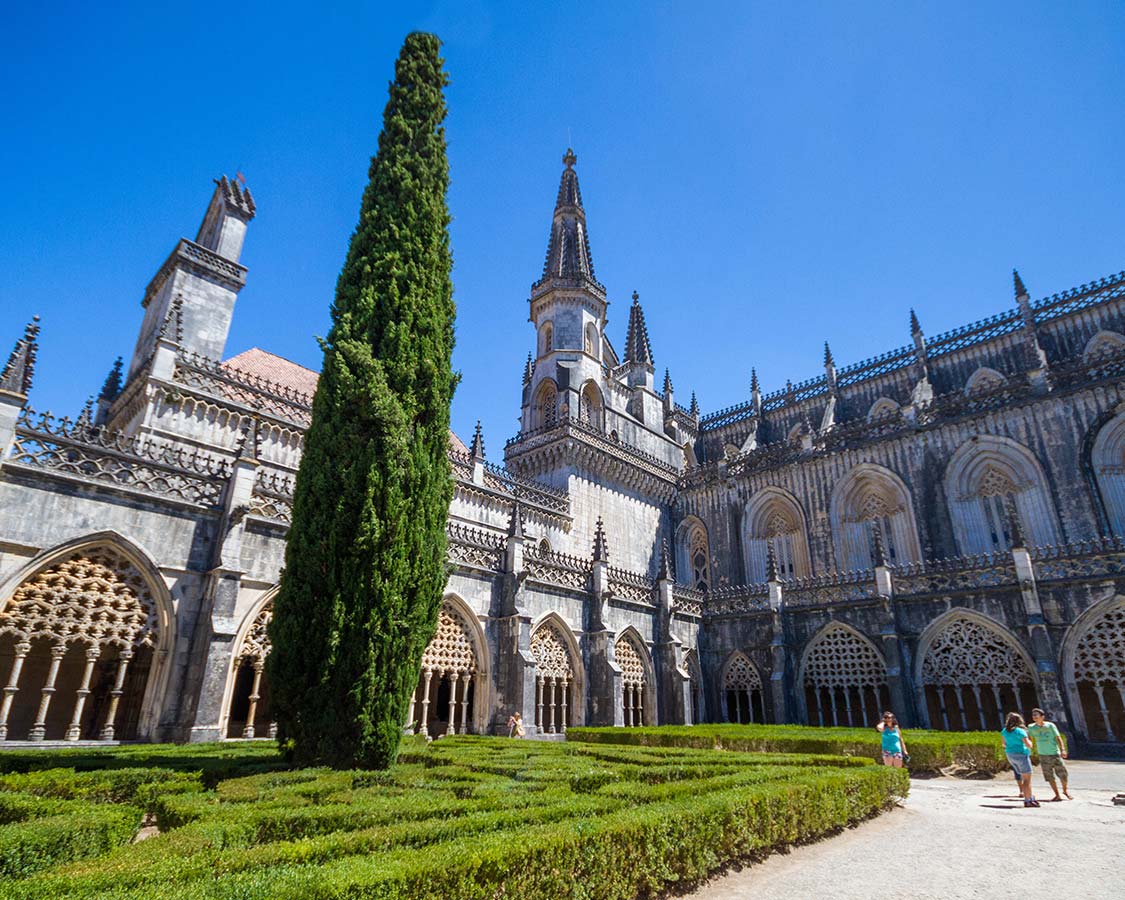
Capelas Imperfeitas (Unfinished Chapels)
One of the most incredible parts of the Batalha Monastery is the open-air unfinished Chapels in the eastern end of the Abbey. The Unfinished Chapel was our last stop within the Monastery of Batalha. To reach this octagonal mausoleum we actually had to exit the Abbey. As with other aspects of this site, it is the Manueline additions, this time by Mateus Fernandes, that truly makes the site extravagant.
There was absolutely no comparison between the unfinished chapels at the Batalha Monastery and the Unfinished church in Bermuda that we visited. The Batalha monastery wins the style awards hands down.
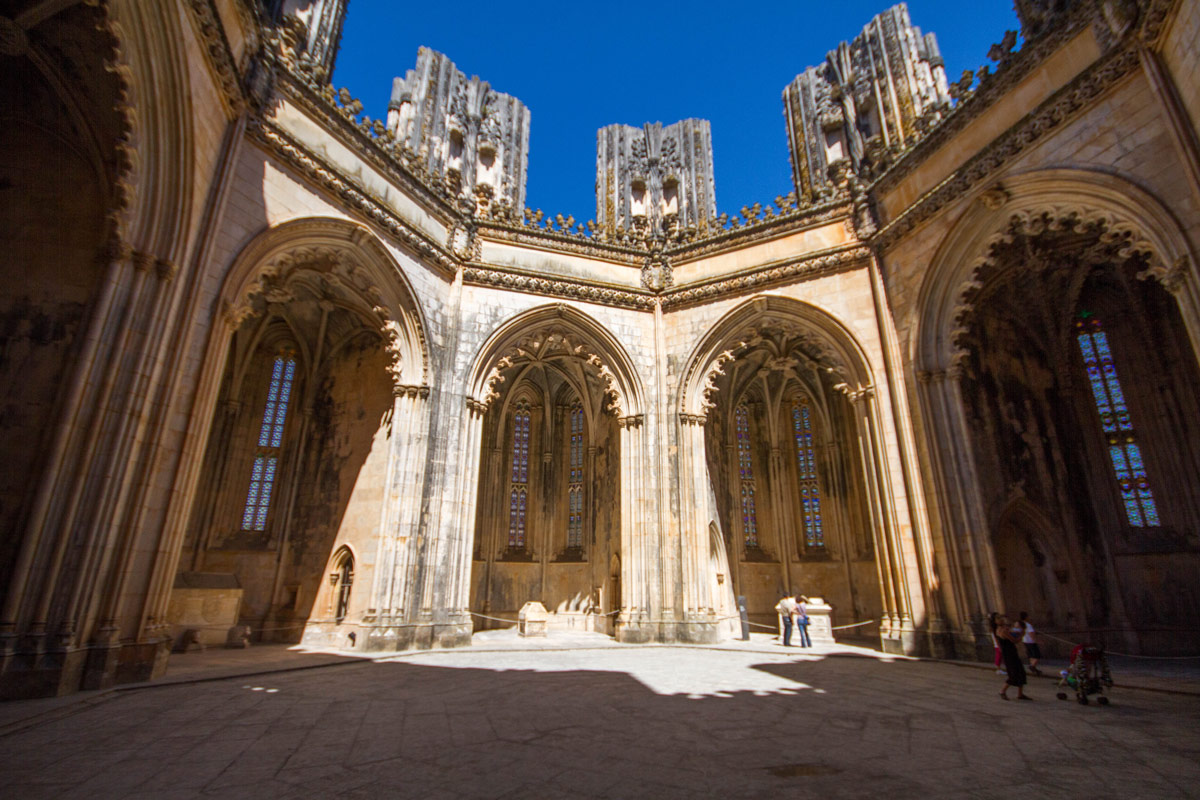
The Convent of Christ in Tomar Portugal (Convento do Cristo)
The third and final monastery on our list was in the town of Tomar Portugal, which is roughly 40 minutes east of Batalha on highway IC9. Placed on the UNESCO World Heritage List in 1983, the Convento do Cristo is impossible to miss when driving into the small city of Tomar. This Knights Templar headquarters is on a hill and rises above its wooded surroundings.
There is no mistaking the difference between Convento do Cristo in Tomar to the Alcobaca and Batalha. It’s the oldest of the three religious sites. The Tomar convent was begun in 1118 and completed in 1160, which compared to Alcobaca and Batalha, is lightning fast. And the position of the Convent of Christ in Tomar as a stronghold for the Knights Templar shows in its rugged appearance.
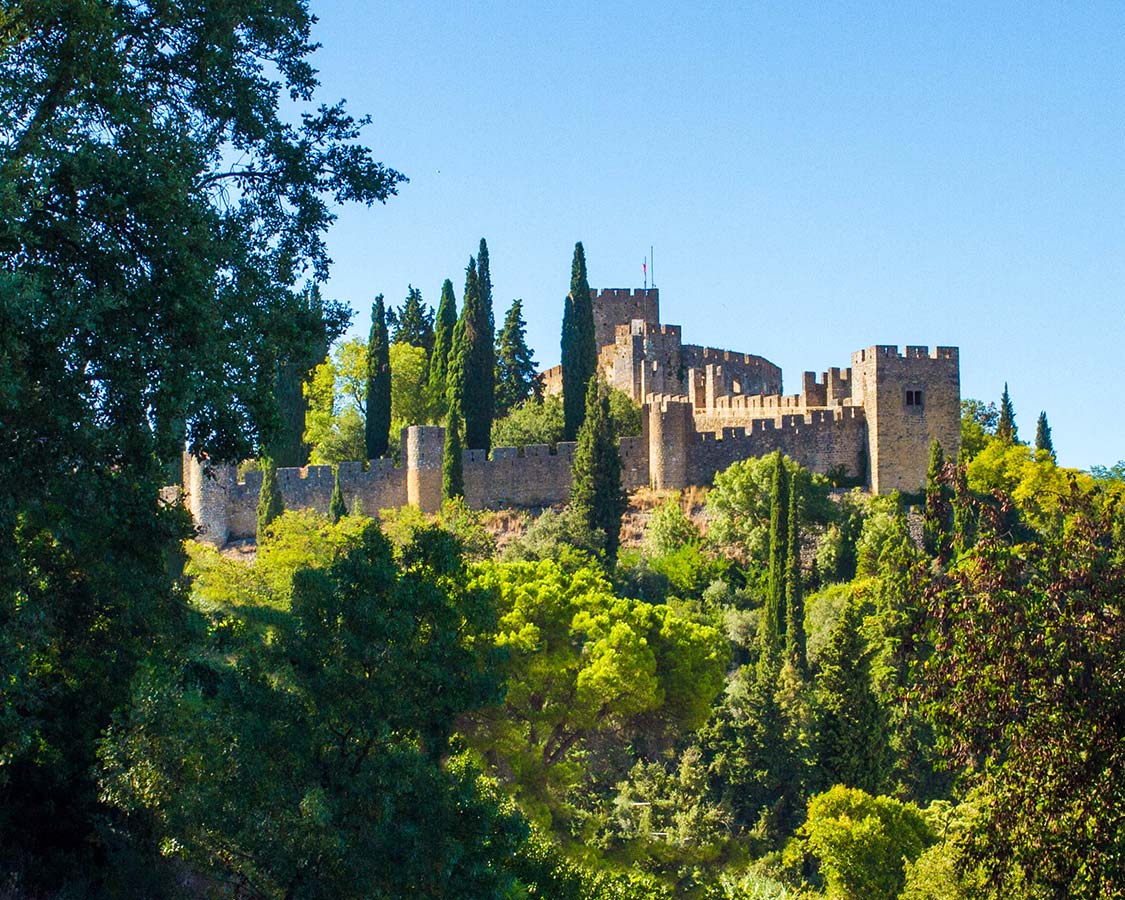
Charola (Rotunda Church) of Convento do Cristo
We started our tour of Tomars Convent of Christ at the Charola. The 16-sided Knights Templar church is sometimes called the Rotunda. Inside was an octagonal altar similar in design to the Holy Sepulchre altar in Jerusalem. Legend has it that the church was circular in design to enable the Knights to attend church while still on horseback. Whatever the reason, it remains one of the most striking altars I have ever seen . It was very ornate with paintings, frescoes, and gilded accents.
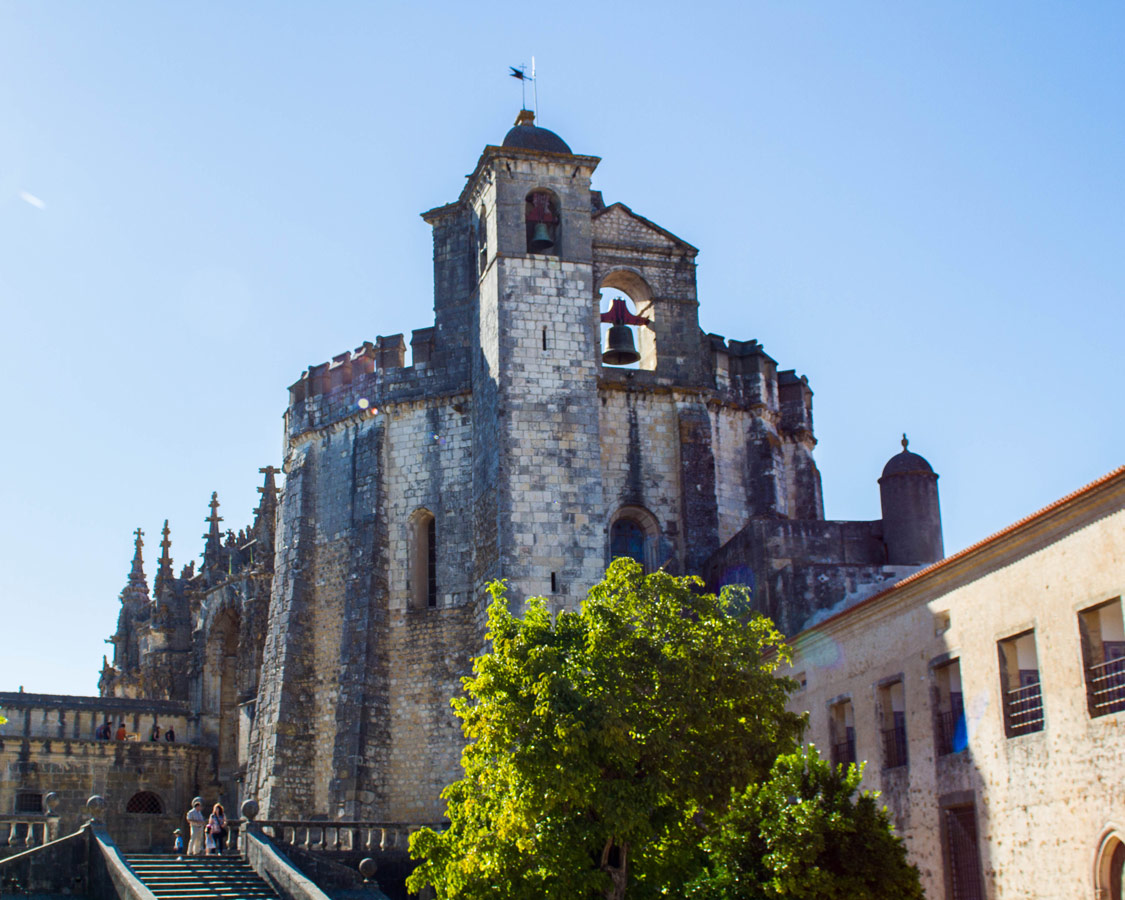
Manueline Church
Connected to the Charola by an archway is the Manueline Church of the Convent of Christ in Portugal. The Manueline church has two levels. And while the outside walls of the convent of Tomar are bleak and rugged, the Manueline Church is beautiful and ornate. A striking feature is the ornate ribbed vaulting on the ceiling in the upper choir. However, the most popular feature of the church is a detailed window found on the exterior better known as The Manueline window.
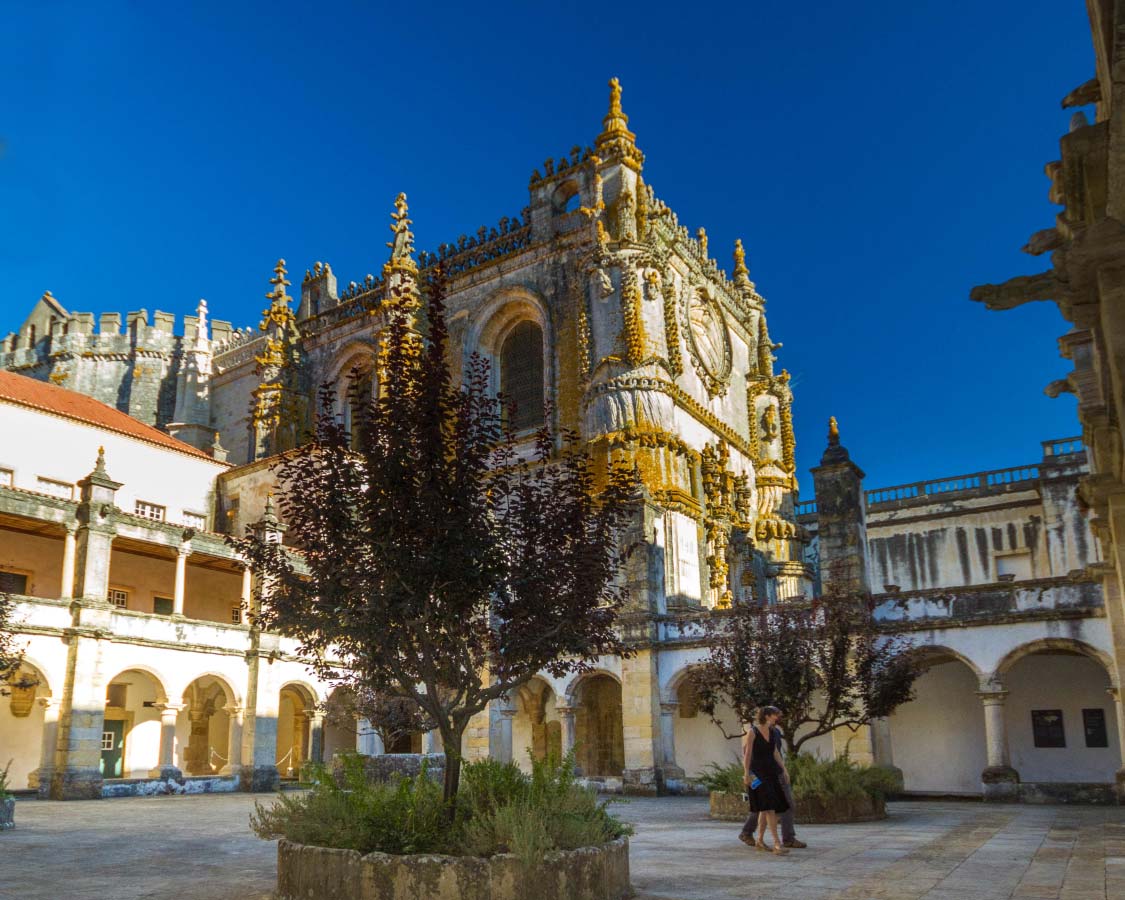
The Great Cloister of the Tomar Monasteries
From the church, we explored the many cloisters within the monastery. The Convento do Cristo has 8 cloisters. The most picturesque of the Tomar monasteries is the Great Cloister. The Great Cloister of Tomar has concealed spiral staircases that can be found in the corners leading to the Terrace of Wax .
The terrace, which runs along the upper levels, was so named as it is where honeycombs were left to dry. Some of the other most notable cloisters in the Tomar monastery were the Cloister of the Crows, Bread Cloister, Cemetery Cloister, and The Washing Cloister.
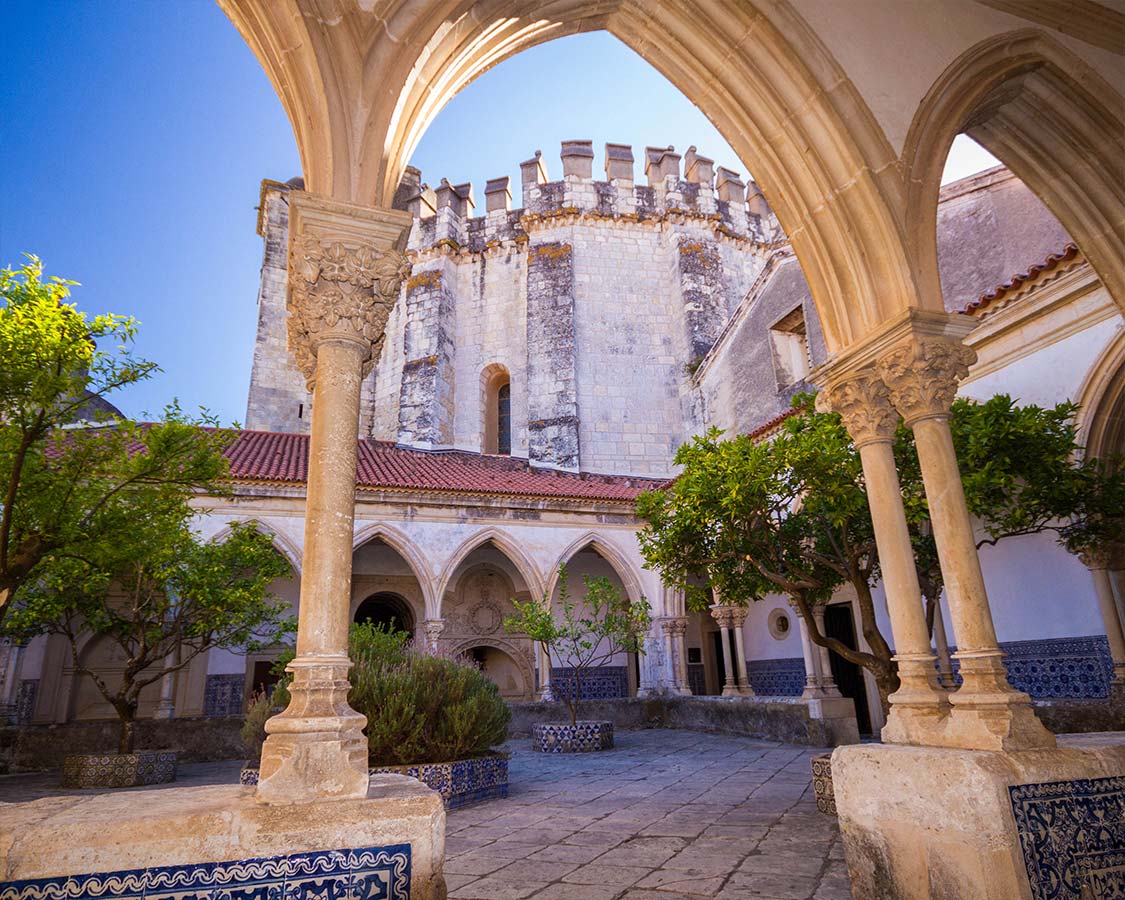
Tomar Portugal Knights Templar Castle
At the end of our self-guided tour of Alcobaca, Batalha, and Tomar, we visited the Knights Templar Castle in Portugal. Built in 1160, the former royal quarters now lay in ruins. But, the castle keep is still very much intact.
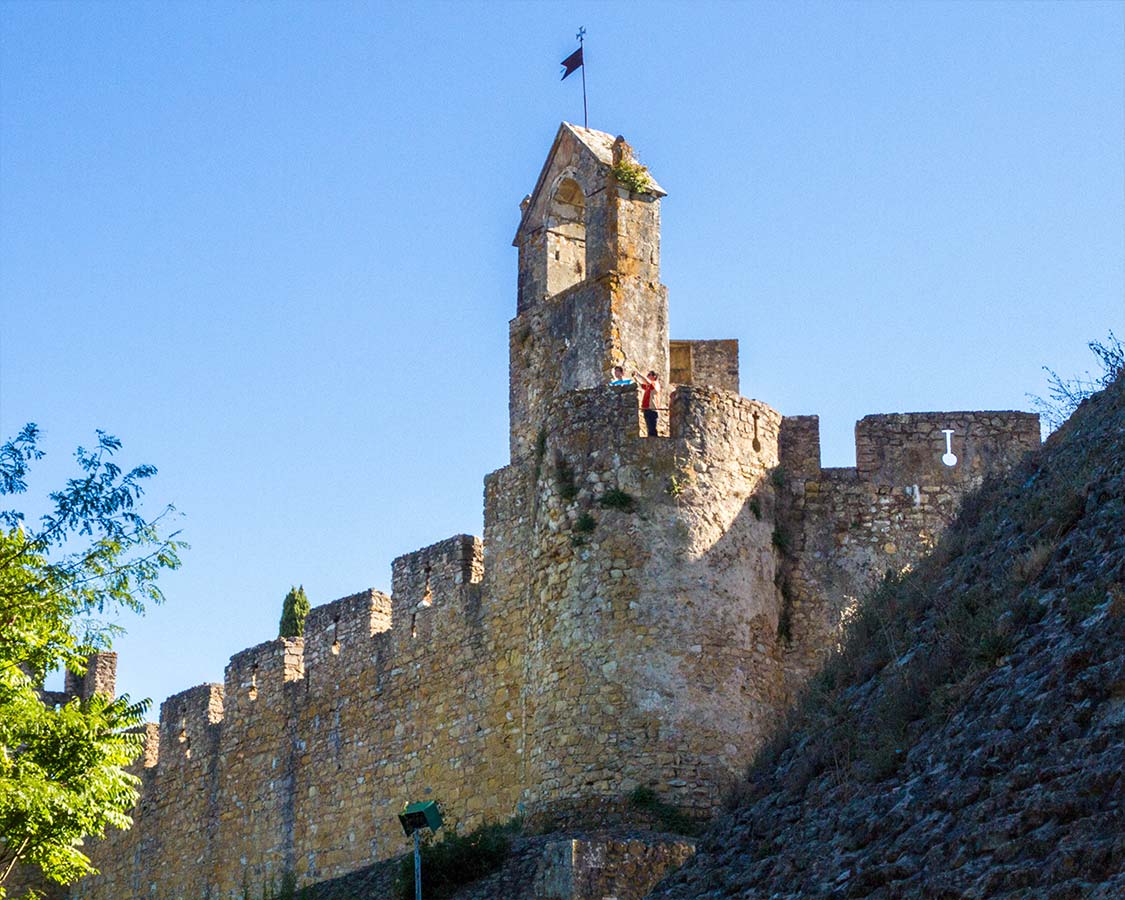
Tips for Visiting the Monasteries of Alcobaca, Batalha and Tomar
For interesting day trips from Lisbon definitely consider visiting the towns of Alcobaca, Batalha, and Tomar to experience 3 architecturally inspiring sites. Although it is possible to visit all three sites in one day, we don’t suggest it. Instead, pick two sites and leave the third site for the next day. You can also expand your tour of Portugal’s heartland by also visiting the miraculous area around Fatima and Obidos and the prehistoric fields of dinosaur footprints in Ourem .
But our biggest tip for exploring Alcobaca, Batalha, and Tomar is to look around. Explore these incredible places because they all have surprises hidden in areas you might never suspect. Look under stairs and around corners to see what amazing secrets the monasteries of Portugal have in store. And don’t forget to look up too. The ceilings in the Portuguese monasteries are incredible!
A Bonus Castle Near Lisbon Castelo de Almoural
After we visited Tomar monastery we began our drive back to Lisbon. Soon, the GPS prompted us to a castle that was nearby (Many GPS’ have a feature that indicates when points of interest are nearby, and we are always checking what they are). After visiting the incredible castles of Sintra , we definitely wanted to see more of Portugal’s castles. So, we stopped to visit the Castelo de Almourol .
The castle is on an island and unfortunately, the last boat to Castle de Almoural had just made its last run for the day. But, the views from the shore as Castle de Almoural was lit by the late-day sun made the stop more than worthwhile.
We later found out that the castle truly ancient. It was originally built in the 1st century BC. While the exact origin of Castle de Almoural is uncertain, it has evidence of Romans, Knights Templar, and medieval influences. We were so glad to have stopped by. What a great way to end our day. What are your favorite sites in Portugal?
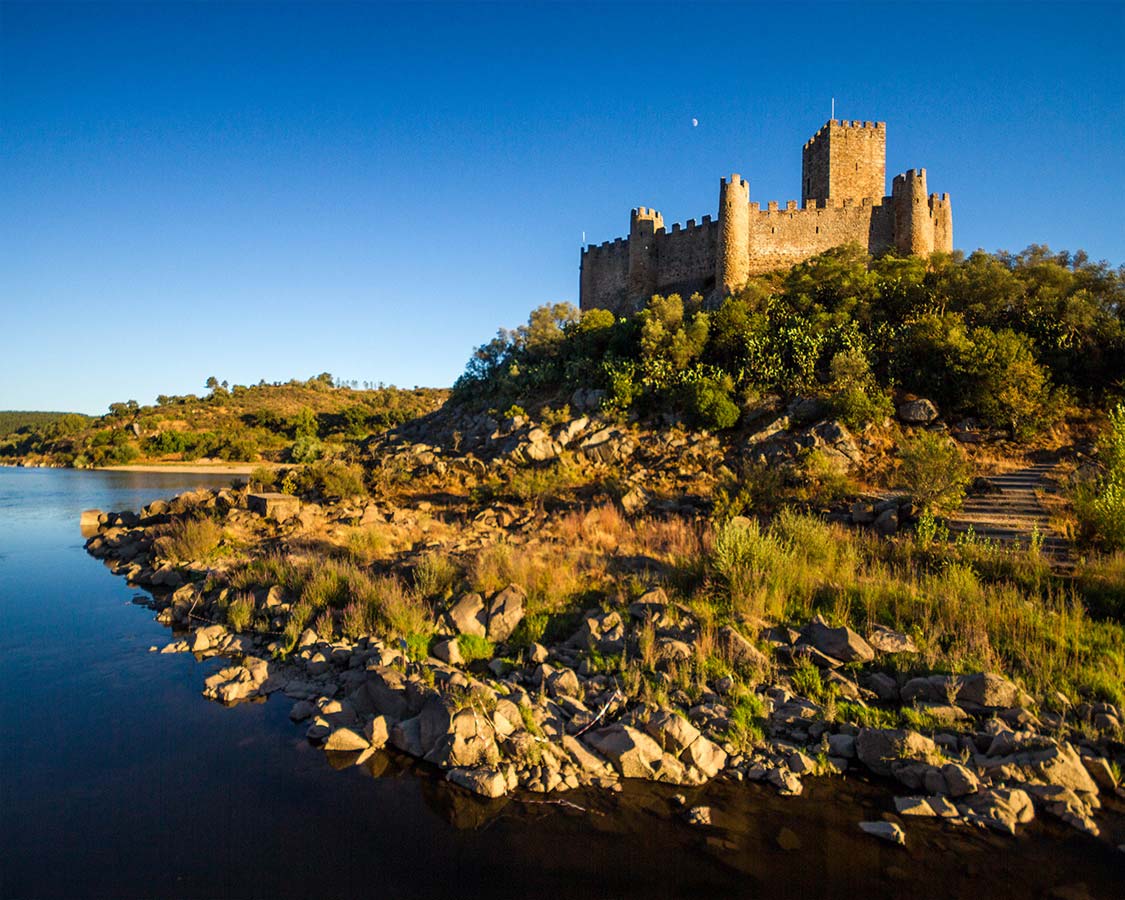
How Much Does It Cost To Visit Alcobaca, Batalha and Tomar
The Alcobaca, Batalha, and Tomar religious are each separate attractions in Portugal. There is a €6 entrance fee for adults. Children 12 and under are free. You can also purchase a Heritage Trail pass is valid for 7 days and includes entrance to each of the three religious sites. The Heritage Trail pass is €15.
There was no parking fee’s in either Alcobaca, Batalha, and Tomar, so visiting the three sites by car was very practical. However, if you don’t have access to a car, there are tours that start in Lisbon and visit Alcobaca, Batalha, and Tomar. These tours often include a visit to the Portuguese pilgrimage site Fatima as well.
Have you explored the Monasteries of Portugal’s Heartland? If you’ve visited Alcobaca, Batalha, or Tomar, tell us about your experience in the comments. Or swing by our Facebook page and post a photo. We would love to share in your adventure!
Visiting The Monasteries Of Portugal With Kids
Visiting the Monasteries of Portugal with Kids is amazing. There are so many areas of these historic buildings to explore that it’s easy to make exploring them a game. Kids will love all the hidden stairs and passageways. If you are visiting Portugal with a baby as we were, most places are stroller friendly. Although, if you want to take in the upper levels, it’s good to be aware that there are no ramps. We found using a child-carrier to be helpful in many of the cities and Portuguese monasteries.
Wandering Wagars is a participant in the Amazon Services LLC Associates Program, an affiliate advertising program designed to provide a means for sites to earn advertising fees by advertising and linking to amazon.com, amazon.co.uk, amazon.ca. Amazon and the Amazon logo are trademarks of Amazon.com, Inc. or its affiliates.
You May Also Like To Read:
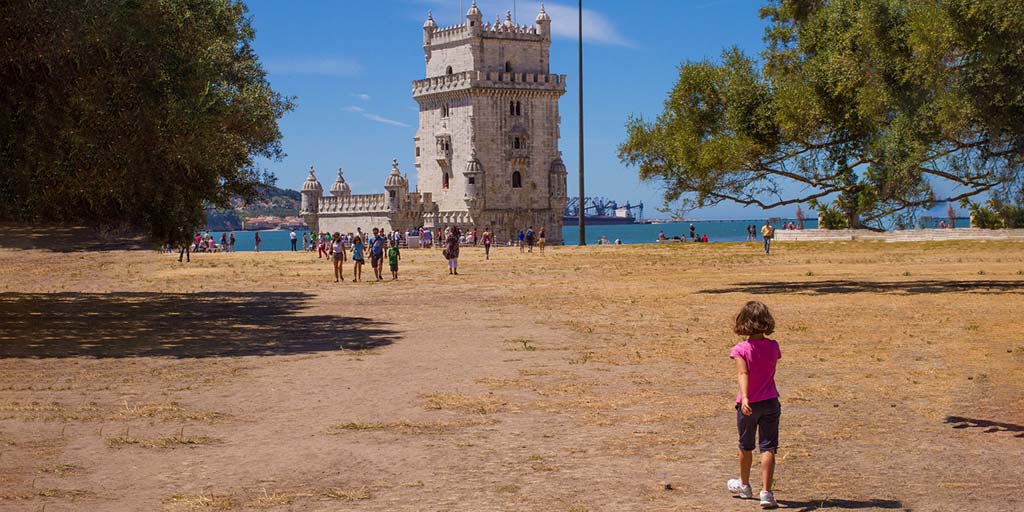
Pin This Post For Later:
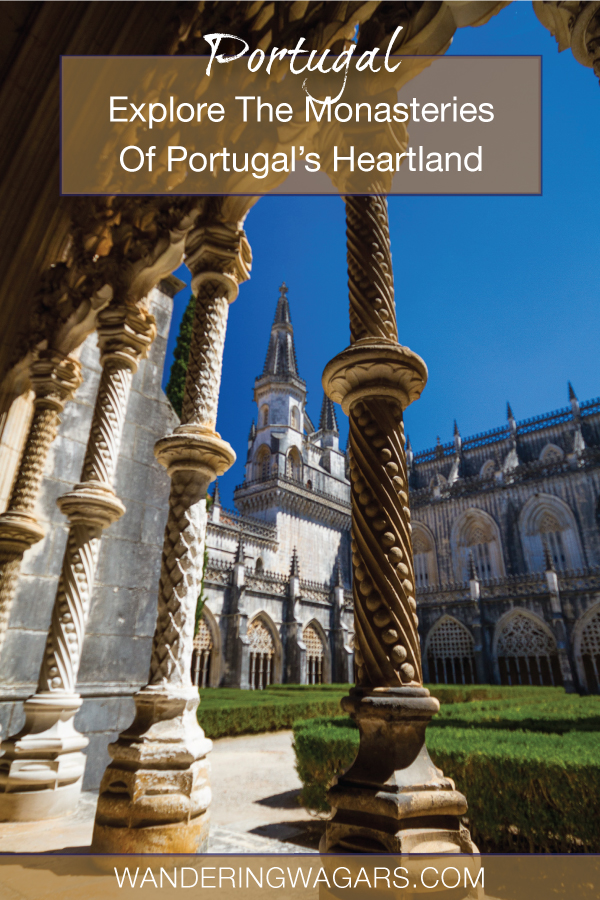
Sunday 7th of April 2019
Thank you for that. Portugal is our favorite place to visit now. It’s hard to try to see as much when we only travel about a week at a time because of work. Now I’m undecided. Lol. Love your pictures and posts! Keep it coming! PS. Wish we were as brave as you guys when the kids were young. We totally forgot about our bucket lists and just got started fairly recently. We did family travel but not as adventurous as you guys. So awesome!
Awesome visits! We did a Viator day trip to Batalha and Alcobaca, Cascais and Sintra and stayed in Fatima but I don’t think we saw all the things you showed here for these two monastery towns. I gather that you are self guided. How do you do it?! We are going back to Lisbon in June and I am planning our itinerary, looking at Evora - how I came upon your blog. Was planning to go to Porto and do the towns along the way but now I’m thinking to forego Porto and north.
Kevin Wagar
Hi Victoria! Thank you so much for the kind words. We did do a self-guided tour. It was our first trip with our 4-month old son and we thought that having a car for feeding and naps would be beneficial. We were right. It also gave us the ability to explore at our own pace and move off-the-beaten-path a bit. I'll be totally honest, I wish we had had the chance to visit Porto. We're looking for a chance to go back and see what we missed.
Mimi and Mitch
Wednesday 26th of April 2017
We had absolutely no idea that Portugal had those kind of churches and buildings. I can see how people would spend hours and travel all over the land visiting them! To see castles where the Knights Templar were known to be must have been such a cool experience.
Tuesday 25th of April 2017
Gorgeous photos!
Reshma Narasing
Wow, all the three monuments look so stunning. I was saddened by the tragedy of Dom Pedro and Ines - their domes look so magnificent. Had never such intricately carved domes before, even in pictures! Thanks for sharing these brilliant architectural sites of Portugal.
Privacy Overview

Meaningful and Spiritual Travel Experiences Worldwide

3 Incredible Monasteries in Portugal : Batalha, Alcobaça, Tomar
Last Updated on: 14th May 2024, 11:50 am
Amazing Monasteries in Portugal: Batalha, Alcobaça, Tomar
Portugal is a church and monastery-lover’s dream. From the beautiful tiled churches which are the best things to see in Porto, Portugal in the North to monasteries throughout the center of Portugal, it’s my favorite monasteries in Europe!
There are three UNESCO World Heritage Listed monasteries in Central Portugal, all within easy driving distance of one another. Further, the monasteries of Alcobaça, Batalha, and Tomar are stunningly beautiful and are all different from each other. Each monastery in Central Portugal has extraordinary architecture and stories. Along with the abandoned Monastery of Santa Clara a Velha in Coimbra , Portugal is one of the best destinations in the world for spiritual and religious travelers.
If you love monasteries , you must put the monasteries in Portugal at the top of our must-see list! Here is a guide to the three UNESCO World Heritage-listed monasteries in Central Portugal that will take your breath away!

How to Get to UNESCO Monasteries in Portugal
Because public transportation between the monasteries in Central Portugal is difficult, it really is best to rent a car .
The truth be told: when I went, I was terrified of driving by myself in Portugal for the first time. But, I knew I would regret it forever if I didn’t see these Monasteries in Central Portugal: so I did it.
It turned out that driving in Portugal is very easy .
I drove a car after spending a delightful time in the beautiful city of Coimbra, Portugal.
And in just two days and one night, you can see all three World Heritage Monasteries in Portugal : Alcobaça, Batalha, and the Convent of Christ in Tomar!
If you just want to see the Convent of Christ, or Convento de Christo in Tomar, you can take the train from Lisbon to Tomar and make a day trip .
It’s also possible to take some coach tours to see the monasteries in Portugal. Many of them will also stop at the wonderful Shrine of Fatima , another must for Spiritual travelers in Portugal.
Start in Coimbra, Central Portugal
Coimbra in Central Portugal is the perfect place to begin a road trip to the UNESCO World Heritage monasteries of Central Portugal.
Coimbra is a quaint university town in Central Portugal with lots to do! Most guides recommend spending only 1 day in Coimbra . I spent almost three days there and wished I had more time!
Highlights of Coimbra
- UNESCO World Heritage Listed Coimbra University with an incredible library — complete with Bats that eat any bugs that could threaten the books. JK Rowling got a lot of inspiration for Harry Potter from visiting here – and I can see why!
- Monastery of Santa Clara-a-Velha is an 11th-century monastery that was flooded and destroyed. You can wander within to your heart’s content. I was the only person there and spending a morning among the ruins was one of the most spiritual experiences of my life.
- A beautiful Romanesque Cathedral with dreamy cloisters .
- An amazing Natural History Museum .
I loved my stay at Solar Antigua Luxury because it was in the very center of Combira and I could easily walk everywhere I wanted to go. Also, the breakfast came in the sweetest basket and the amenities were top-notch. If you are traveling with a family, the owners have a holiday apartment as well that looks dreamy.
I rented a car in Coimbra on my last day.
I left in time to get to Batalha Monastery in the early afternoon. As a first-time driver in Europe, I was nervous about renting a car in a big city and having to navigate city driving. Luckily, from Coimbra , I only had about 2 minutes of city driving before an easy roundabout and clear, safe, well-marked country highway began.

History of Monasteries in Portugal
Not only are the Monasteries in Portugal simply gorgeous and inspiring to visit, but I really enjoyed learning about the history of monasteries in Portugal .
Portugal used to be a haven for Roman Catholic monasteries. Many orders flourished in Portugal: the Cistercians, the Benedictines, and more.
Unfortunately, Portugal went through a brutal civil war in the 1800s. At the conclusion of the war, Portugal terminated the State sanction for its monasteries and disbanded over 500 of them. The lands and possessions of those monasteries were nationalized.
This explains why there are so many abandoned monasteries in Portugal , and very (very) few living and working monasteries. Many of the monasteries were well-preserved, such as Batalha, Alcobaça, and the Convent of Christ in Tomar. Many others have been turned into monastery hotels in Portugal.
In many ways, I wish there were more working monasteries in Portugal to visit. Still, I’m grateful that some of the most magnificent monasteries in Portugal have been so well-preserved.

Entrance Tickets to UNESCO Monasteries in Portugal
An important tip for visiting the UNESCO World Heritage Monasteries of Central Portugal: Each monastery costs 6 Euro to visit. The churches themselves are free. However, you can buy a ‘passport’ for all 3 monasteries that costs 15 Euro. The ticket-takers will stamp it at each entrance. It’s great fun to collect all three stamps! Find out more about Tickets to UNESCO sites in Portugal at the Patrimonia Cultural website (English available).
Visiting the Monastery of Batalha
Hours: Open daily 16th of October through 31st of March , 9:00 am – 6:00 pm. 1st April to 15th October , 09.00 a.m. to 6.30 p.m. (last admission 30 minutes before closing) Closed: 1 January, Easter Sunday, 1 May and 25 December
Batalha Monastery , or the Mosteiro de Batalha, is one of the best-preserved monasteries in Portugal. Yet, Batalha monastery is still very atmospheric…and almost a touch creepy when you think about all the tombs there and how long it has been abandoned.
Batalha Monastery was commissioned by one of Portugal’s kings, King João. The monastery was to celebrate a victory in a huge battle that took place in 1385. Hence — the name, Batalha, which means “Battle”!
One style of architecture you will hear a lot about in Portugal is “Manueline” . This is a richly intricate style of architecture that is most obvious in the intricate and ‘frilly’ Cloister Windows of monasteries like Batalha or the famous Jeronimos Monastery in Belem, Lisbon.
Batalha Monastery was built right in the middle of the transition from Gothic architecture to Manueline . As a result, Batalha has all of the flying buttresses and vaulted ceilings loved in Gothic Architecture. Added to that, there is an intricacy and the flourish of Manueline lattice-work, especially obvious in the cloisters.

Touring Batalha Monastery
The church is massive, with impossibly-high stained glass throughout . In the ticketed section, you can visit two sets of cloisters, both of which are un-missable.
Inside Batalha is a special room with a memorial for an Unknown Soldier . This room is guarded by military officials, but you are welcome to pay your respects.
Don’t miss the beautiful fountain in the Manueline cloister , and the older cloister which harkens back to the traditional Gothic style. Batalha offers a wonderful chance to understand these styles of architecture.
Lastly, Batalha has a unique unfinished chapel.
This was my favorite part of Batalha, hands down. This chapel is a Manueline chapel meant to be a resting place for the king, but unfortunately, he died before it was finished, and then the architect died. It is open to the elements, and birds fly through. The stone is gorgeous and there are some beautifully carved tombstones and remnants of stained glass throughout.

Where to Stay in Batalha, Portugal
Since I chose to stay in Alcobaça so I could visit the Alcobaça Monastery first thing in the morning, I didn’t stay in Batalha.
If you want to stay in Batalha, there are many highly-rated hotels there:
Mid-Range Hotels
The Hotel Lis Batalha Mestre Afonso Domingues is right near the monastery and has a restaurant on-site. As you’ll see, the hotel has great reviews, rates under $100 when I checked, and looks adorable. Right in the heart of Batalha, if you want to park and walk to the Monastery of Batalha, this would be a great choice.
Budget Option
The Lagar do Sapateiro is a farm stay, which definitely intrigues me! This is 3.4 miles from Batalha, and has a budget room under $50. I would absolutely pick this one if I were visiting Batalha with a rental car again! How cute is this place?! The breakfast is rated as “Excellent”.

Visiting the Monastery of Alcobaça
Hours: October – March Open Daily 9-6 pm, April – September Open Daily 9-7 pm (last ticket sold 30 minutes before closing!) Closed on: 1 January, Easter Sunday, 1 May, 20 August and 25 December.
The monastery of Alcobaça (Al-co-ba-sah) is only about 11 miles or 18 km from the monastery of Batalha. Since they are so close together, there is a bus that travels between them once daily.
When driving, it only takes around 30-40 minutes to drive between them. The countryside is gorgeous and I highly recommend doing this drive while there is some morning or evening light to truly appreciate it.
The Monastery of Alcobaça is in the town of Alcobaça. The town has some fabulous seafood restaurants and cafés. The entire town is very walkable! I found a hotel with parking for the car that was less than a 5-minute walk from the monastery (which also serves as the town center).

Touring Alcobaça Monastery
Alcobaça Monastery in Portugal was built in 1153. The monastery was built by the very first Portuguese King. One of the many reasons Alcobaça Monastery is unique is because it was the first Gothic church and monastery in Portugal. Alcobaça was built earlier than Batalha monastery and is in the crux between Romanesque architecture (generally a bit heavier) and Gothic architecture.
At its height, Alcobaça Monastery was a center of power within Portugal and beyond. The Scriptorium, where Monks copied and decorated books by hand, was famous. Sadly, during an invasion in 1810 many of the books were stolen and destroyed.
Along with the beautiful Cloisters of Silence you can visit the Chapter House, the kitchens (with really cool chimneys) and many other highlights of the Monastery.
The he most famous part of Alcobaça is the area that holds the Royal Tombs .
Alcobaça Monastery is the center of a famous, tragic, and slightly creepy love story in Portugal : Pedro and Ines . The story goes that the married Pedro fell madly in love with Ines. Unfortunately, he wasn’t allowed to be with her, and then Pedro’s father had Ines killed. Pedro later became king, and apparently had Ines’s body dressed up as a bride so he could finally marry her – yikes! Pedro and Ines are buried together at Alcobaça. Their tombs are beautiful and have scenes from their lives carved in the sides.

Where to Stay in Alcobaça, Portugal
The Chalet Fonta Nova is a beautiful, affordable boutique hotel right near the Alcobaça monastery. The hotel offers free covered parking and has beautiful rooms. I felt like a Portuguese Queen staying there!
The Chalet Fonta Nova also had one of the best hotel breakfasts I’ve ever had! Everything was really fresh and delicious. The Chalet Fonta Nova definitely feels like a luxury hotel and has beautiful gardens and huge windows. I highly recommend it!

Visiting the Convento de Christo in Tomar
Hours of Convent of Christ, Tomar: October to May , 9:00 to 5:30pm June to September, 9:00am – 6:30 pm (last entry 30 minutes before closing). Closed : January 1st, 1st March, Easter Sunday, May 1st and December 24th and 25th
The Convent of Christ, or Convento de Christo, in Tomar , Portugal may be the best of the monasteries in Portugal . The Convent of Christ was listed as a UNESCO World Heritage monastery in 1983.
This is especially one of the best monasteries in Portugal if you are visiting with kids and you happen to love touring castles as much as monasteries.
The Convent of Christ in Tomar is a 12th century Templar stronghold , which makes it a Castle and Monastery in one.
One of the really cool parts of visiting Tomar, Portugal is that there are actually four monasteries there. The town is based on a cross-shape with a monastery in each corner. The Convento de Christo in Tomar is the Western-most monastery.

Touring the Convent of Christ, Tomar Portugal
As soon as you enter the Convento de Christo, you can admire the ramparts of the castle . You can walk along the ramparts and in the gardens of the Castle. After enjoying the Templar architecture , you enter the Convent.
Once inside the Convent you can tour eight different cloisters , each unique and with a different architectural style. The Great Cloister is the most magnificent, with spiral staircases in each corner you can climb to a second level.
The church of the Convent of Christ is Manueline. Inside the Church is a unique charola. This octagonal altar is richly decorated because of the wealth of the Templars in the 12th century. The c harola is stunning . You can walk around it to see all of the paintings inside. Outside, you can admire the Manueline windows in the Chapter House.

Where to Stay in Tomar, Portugal
Hint: If you need a place to store your luggage in Tomar while you are visiting for a day trip, there is a hotel right across from the train station that will kindly do so for you. The Hotel Travador stored my luggage in a closet while I spent the day in Tomar. Consider showing your gratitude with a tip.
There are lots of highly-rated hotels in Tomar .
I did not stay in Tomar, but went on to Lisbon from the train station conveniently in the heart of Tomar.
I regret that! Tomar is such a beautiful town!
I really wish I had stayed at least one night in Tomar after visiting the Convento de Christo. The river running through the town is beautiful. I had one of the best meals in my whole time in Portugal in a little café by the river.
Mid-Range Hotel
The Casa des Oficios hotel in Tomar is centrally located and has great reviews. Rooms when I checked (July 2020) seem to run between $100-140 USD a night. The hotel looks amazing with traditional Portuguese tile, exposed brick, and even a library! Breakfast is included in the rate at Casa des Oficios hotel in Tomar.
Budget Hostels
There are a few backpacker hostels in Tomar. Both offer private rooms if you prefer that, at around $50 a night when I checked in July 2020. The Residencial Avenida Hostel is right around the corner from the Train Station and people rave about the owner, Antonio. Hostel 2300 Tomar offers all the typical hostel amenities, a self-service breakfast, and comfortable beds. Both of these hostels are frequented by Pilgrims walking the Caminho Portugues — so you might meet some very cool people there!

Top 23 Must-See Churches in Armenia and Monasteries in Armenia

11 Magnificent Antigua Guatemala Churches and Convents
You may also like.

What To Do in Milan in One Day

The Top 34 Most Famous Cathedrals in Europe

22 of the Most Beautiful Cathedrals in the World
11 comments.
I very much enjoyed learning about and seeing the photos of the monestaries. Thye all look beautiful. I’ve only been to Portugal once and am planning to go back. I’ll keep your post in mind.
Sarah Wilson
I used to live just down the road from Alcobaca – I love Portugal’s Romeo and Juliet’s love story, but yes, its a bit creepy. There was a coffee shop just opposite the monastery that did the most amazing pastel de nata – could just do with one of those now. Thanks for bringing back great memories.
Such great inspiration (however, not that I need any when it comes to visiting historical sites and soaking up the history). I greatly appreciate learning about historic locations and you’ve certainly provided great photos of the monestaries. I’ve only been to Lisbon and will look forward to an opportunity to return to Portugal when the time presents.
I’ve visited Portugal some time ago and absolutely loved it. I’ve visited the monastery in Coimbra and also one in Belém which was just breathtaking. This heritage is just fantastic.
I would never have realised there were so many monasteries in Portugal and all so beautiful. I especially like the one that is a castle and monastery, Convento de Christo.
I lived in the Algarve for 4 years, but never really explored the north. The monastries look beautiful and I particularily like the Alcobaça one with its tragic story of Pedro and Ines. Hope to get to see them one day.
Yukti Agrawal
I was planning for Portugal for this summer break but cancelled my visit after this pandemic. But in near future when travel resumes then I will truly visit this wonderful place. Good to know that there are so many monasteries here and all look worth visiting. I loved arched alley of the church at Alcobaça.
I loved all the monasteries in Portugal but I have to say Tomar was perhaps my favorite. I just felt like I was transported to the time of the templars as we wandered around…so beautiful!
Linda (LD Holland)
We saw a lot of churches and monesteries in Portugal. But missed the ones that you have detailed. We saw the outside of the one in Belem but did not have time to get inside. Definitely another way to enjoy the beautiful architecture in Portugal.
I enjoyed reading through your blog and learnt a lot. It is always an awesome experience walking through the monasteries, being astounded by the huge structures and architecture, and the peace and quiet that accompanies those visits. Also, it was interesting to learn about bats that eat any bugs that could threaten the books at the Coimbra University library! 🙂
Cledwyn Stafford
Fantastic, as a Franciscan friar this was most helpful. thankyou
Leave a Reply Cancel reply
Your email address will not be published. Required fields are marked *
Yes, add me to your newsletter with exclusive photos and spiritual travel narratives!
Pin It on Pinterest

IMAGES
VIDEO
COMMENTS
Batalha Monastery. Address. Largo Infante Dom Henrique, 2440-109 Batalha, Portugal. Phone +351 244 765 497. Web Visit website. The Batalha Monastery ("the monastery of the battle") in central Portugal is one of those rare gems that, despite being a UNESCO World Heritage Site, doesn't attract huge numbers of visitors.
Visit tips. Batalha Monastery Opening Hours: 9am to 5:30pm (Oct to Mar) - 9am to 6:30pm (Apr to Sept) - Closed on some public holidays. It is free to enter the main church but this is not the interesting part…. Batalha Monastery price - 6€ entrance ticket.
The Monastery of the Dominicans of Batalha was built to commemorate the victory of the Portuguese over the Castilians at the battle of Aljubarrota in 1385. It was to be the Portuguese monarchy's main building project for the next two centuries. Here a highly original, national Gothic style evolved, profoundly influenced by Manueline art, as ...
The Batalha Monastery, or Mosteiro da Batalha, stands as the focal point of Batalha and a symbol of Portugal's historical pride and architectural brilliance. ... It remains a must-see destination for anyone interested in architecture, history, or simply experiencing one of Portugal's most remarkable cultural treasures. Igreja Matriz da Batalha.
The great Dominican monastery of Santa Maria da Vitória in the small town of Batalha, central Portugal, isn't just a national shrine but one of the finest examples of Gothic architecture in Europe. Rising high from the valley floor, the monument is a riot of pinnacles, gargoyles, rose windows, buttresses and balustrades wrought in a fine, smooth limestone that time has mellowed to a honey ...
Top Things to See and Do in Batalha. The town of Batalha is dominated by the monastery. So no surprises its many features make the list of top things to see and do. However, the small streets surrounding the monastery ooze small town charm, and you'll even find a few other historical curiosities.
Monastery of Santa Maria da Vitória (or Monastery of Batalha) One of the most fascinating places in the Iberian Peninsula. A decisive event for the consolidation of the Portuguese nation took place on August 14, 1385, near the spot where the Monastery of Batalha stands: D. João, Master of Avis and the future king of Portugal, overcame the Castilian armies in the battle of Aljubarrota.
A visit to Batalha is all about the Mosteiro da Batalha, and not much else. The actual site of the battlefield can be visited, along with the informative Batalha de Aljubarrota museum, but this is 3km out of the town. ... If you wish to explore the entire monastery and visit the Batalha de Aljubarrota museum (which is highly recommended ...
The Batalha Monastery is one of the most impressive religious buildings of Portugal. This Gothic monastery was commission by King João in gratitude for the decisive victory in the battle of Aljubarrota (1385), and the grand designs took over a hundred years to construct. ... The final stage of the Batalha Monastery is to visit the unfinished ...
The Monastery of Santa Maria da Vitória builds in stone a great expression of devotion and gratitude. The devotion of the king D. João I to the Virgin Mary and the gratitude for the victory of Portugal over Spain, achieved at the decisive Battle of Aljubarrota (1385), which granted the emancipation and independence of Portugal, fought by the great strategist and commander of the Portuguese ...
The Monastery of Batalha is open every day, from 9 am to 6 pm (from October 16th to March 31st) or from 9 am to 6:30 pm (from April 1st to October 15th), with the last entry taking place at 5:30 pm and 6 pm, respectively. The monument closes on January 1st, Easter Sunday, May 1st, and December 25th. As far as tickets are concerned, the Church ...
Visit Monastery of Batalha: A UNESCO World Heritage site with stunning Gothic architecture and rich history. ... A visit to the monastery's interior is, of course, mandatory, but, if possible, do not miss the great spectacle of the monastery's night-time illumination, which greatly enhances its exuberant beauty and gives the carefully ...
The Monastery of Batalha may be the main invitation to visit the municipality, but you should also explore the surrounding area, visiting the tourist village of Pia do Urso, Reguengo do Fetal, or even the Coin caves. To visit Batalha is to get to know a territory very close to the entrance to the extraordinary Natural Park of Serras de Aire and ...
Batalha Monastery commemorates the Portuguese victory over Castillans at the nearby Battle of Aljubarrota. It's Portugal's most important gothic building and one of the most significant in both the Iberian Peninsula and Europe. The building also gave birth to the Manueline style of architecture. The westport was one of the last parts to be ...
Price to visit the Monastery of Batalha. If you want to know how much it costs to enter the Monastery of Batalha, please take note that the regular ticket costs 10 EUR, but children up to 12 years old have free admission. Also, the admission to the Monastery of Batalha is free on Sundays and holidays for residents of the national territory.
THE MONASTERY OF BATTLE. The Monastery of Batalha is a Dominican monastery built at the request of King João I, from 1387, as a thank you to the Virgin Mary for the victory in the Battle of Aljubarrota. The monastery belonged to the Order of Saint Dominic and was built over two centuries, during the reign of 7 kings and was inaugurated in 1517 ...
History of Batalha Monastery. In 1385, King João I vowed that if his outnumbered army defeated the Castilians at the important Battle of Aljubarrota, he would build a magnificent monastery dedicated to the Virgin Mary.The king was victorious, resulting in the independence of Portugal from Spain and the great Batalha Monastery. King João I gave the monastery to the Dominicans and the splendid ...
The Monastery of Batalha (Portuguese: Mosteiro da Batalha) is a Dominican convent in the municipality of Batalha, historical Beira Litoral province, in the Centro of Portugal.Originally, and officially, known as the Monastery of Saint Mary of the Victory (Portuguese: Mosteiro de Santa Maria da Vitória), it was erected in commemoration of the 1385 Battle of Aljubarrota and would serve as the ...
Batalha Monastery. Located in the Gothic masterpiece of Santa Maria da Vitória Monastery, a special visit should be made to this chapel with its magnificent stained-glass windows, cloisters, Unfinished Chapel and the tombs of several Portuguese notables. Suggest edits to improve what we show.
The Monastery of Santa Maria da Vitória, widely known as Batalha Monastery, is a majestic building, declared World Heritage by the UNESCO. Combining Manueline and Gothic styles, it was built in the 14th century to carry out the promise D. João I did to the Virgin in case they won the Castilians in the Battle of Aljubarrota, in 1385. In this ...
The monastery blends a rich history with impressive architecture such as its vast vaulted ceilings, Batalha Monastery is listed as a UNESCO World Heritage site and also features as one of our top 10 tourist attractions in Portugal. Getting to Batalha Monastery. Batalha is located 118km north of Lisbon, close to Fatima and Alcobaça.
The second monastery to visit on our list was in the town Batalha, which is only 30 minutes and 24 km (15 miles) from Alcobaca by car. The Batalha Monastery (Monasterio de Santa Maria da Vitoria) has a dramatic and detailed exterior that really stands out amongst the modern architecture of Batalha Portugal.
Portugal is a church and monastery-lover's dream. From the beautiful tiled churches which are the best things to see in Porto, Portugal in the North to monasteries throughout the center of Portugal, it's my favorite monasteries in Europe!. There are three UNESCO World Heritage Listed monasteries in Central Portugal, all within easy driving distance of one another.